Subscription Box Business Plan [Download Template Here]
Are you ready to take your subscription box from idea to reality if so, this blog post is for you whether you are a new subscription box entrepreneur or a seasoned pro, having a solid business plan can make the difference between being a disorganized mess and having a solid strategy. why you need a […].

Are you ready to take your subscription box from idea to reality? If so, this blog post is for you!
Whether you are a new subscription box entrepreneur or a seasoned pro, having a solid business plan can make the difference between being a disorganized mess and having a solid strategy.

Why you need a business plan for your subscription box idea
Starting a new business can be overwhelming. You’ve got a great idea, maybe it’s written down on a napkin or on a sticky note. You’ve got marketing ideas swimming around in your head and you just read a blog post that gave you some great financial advice. But the problem is, you need a place to organize all of this information. A business plan, like the one provided below, can help you collect all of the amazing ideas you have for a new subscription box and turn them into a successful business.

How to use this Business Plan template
In this blog post, we’ll go over the core components of the subscription box business plan and at the end, you’ll be able to download a 25-page template to get you started! The business plan is broken up into 6 different parts: Goals & Strengths, Niche, Cost Analysis, Competitive Analysis, Plan for Growth & a Week-by-Week Launch Calendar.
Goals & Strengths
The first section of the Subscription Box Business Plan is the “Goals & Strengths” section. In this section, you’ll outline the foundation of your business, high-level goals and write out your company’s mission statement. It’s important when writing down your goals to be very specific about what you want to accomplish. The more specific of a goal you write down, the more clarity you will have around which business tasks to accomplish in order to meet those goals.
In this section, you’ll also take stock of your personal strengths. Writing down what skills and talents that you are bringing to business will allow you to determine which tasks you’ll take on and which ones you’ll need to delegate. For example, if graphic design or website coding are not skills you currently possess, you will need to find someone to help you in those areas. While it can be tempting to try to do everything yourself, getting help in the areas in which you are not skilled can be especially helpful in the beginning.

The second part of the business plan will help you narrow down and identify your niche. Some of the most successful subscription boxes have found a way to serve a very specific niche. Boxes like BarkBox, which caters to dog owners or BirchBox which caters to makeup lovers are successful because they deliver the exact products that their target market needs & wants. We recommend that you place a lot of importance on identifying which niche your box will serve before launching.
Using the worksheets provided, you’ll be prompted to describe your niche and identify products that serve that niche. Once completed, you can use this information to reveal unique opportunities that exist in your niche and develop ways to take advantage of them. You’ll also create an ideal customer profile for your business. Knowing who your ideal customer is will help you as you put together marketing collateral and establish a social media presence.

Before starting any business, it’s always a good idea to ‘run the numbers’. Forecasting your costs and sales can be helpful in determining how much cash you will need to start the business and keep it running. Inside the business plan listed below, you will find several worksheets to help you calculate what your start-up and operating costs will be. This will be helpful should you need to secure a loan or run a Kickstarter campaign to get it started.
In this section, we’ll also take a look at pricing your box. The worksheet provided will walk you through all of the things you need to consider when pricing your box. Margins are especially important in the subscription box business. A profit margin of 30%-50% is ideal. Should you have a hard time meeting those margins, you may need to reconsider how you are getting products or the price of your box.
Competitive Analysis
Knowing who your competitors are and what they are doing is very important in the beginning stages of your business. Inside of this business plan is a section that will allow you to do a thorough competitive analysis of your competitors. Knowing your competitor’s strengths and weaknesses can be valuable information to have, especially as you develop your own unique value proposition.
In each of the worksheets, you will be prompted to write down key information about your competitors and how you can set yourself apart from that particular competitor. If there aren’t any competitors in your niche, consider yourself lucky. However, you can still use the worksheets to study other successful subscription boxes.

Plan for Growth
This section of the subscription box business plan is dedicated to creating a marketing plan for your subscription box business. An effective customer acquisition strategy is a crucial part of your subscription box’s success. You will need to use a variety of marketing channels like social media, paid ads and influencer marketing to attract new customers.
In this section, you’ll find worksheets dedicated to outlining your strategy for Facebook, Instagram, Youtube, brand influencers & email marketing.
Launch Calendar
The last section of the business plan includes a week-by-week launch calendar. In this 6 week calendar, you will find a checklist of the tasks and deadlines that you will need to accomplish on your way to launching your subscription box. These checklists will take you from the pre-launch phase , sourcing products, packaging products and marketing your pre-launch page.
Ready to get started?
Download the 25-page Subscription Box Business Plan Template here!

How useful did you find this article?
3 Responses
Forget that! I just got it…
- is closed by WordPress -->
Greetings, I have requested the business plan twice and never received it in my email.
Please advise on how I can secure the template.
Thanks in advance for your assistance.
Hi Monique! Sorry to hear you’re having trouble getting that plan into your email. Did you check your spam folder? Feel free to reach out to us at [email protected] and we’ll get you squared away.
Leave a Reply Cancel reply
Save my name, email, and website in this browser for the next time I comment.
Sign me up for the newsletter!
- Sample Business Plans
- Retail, Consumers & E-commerce
Subscription Box Business Plan

The COVID-19 pandemic has greatly increased the popularity of subscription boxes, which have been on the rise nowadays.
Additionally, 51% of consumers receive subscription boxes solely to test out new products. Therefore, this business is fun as well as rewarding. If you are preparing to start one then planning everything first is necessary.
Need help writing a business plan for your subscription box business? You’re at the right place. Our subscription box business plan template will help you get started.

Free Business Plan Template
Download our Free Subscription Box Business Plan Template now and pave the way to success. Let’s turn your vision into an actionable strategy!
- Fill in the blanks – Outline
- Financial Tables
How to Write a Subscription Box Business Plan?
Writing a subscription box business plan is a crucial step toward the success of your business. Here are the key steps to consider when writing a business plan:
Here are a few key components to include in your executive summary:
1. Executive Summary
An executive summary is the first section planned to offer an overview of the entire business plan. However, it is written after the entire business plan is ready and summarizes each section of your plan.
- Introduce your business: Start your executive summary by briefly introducing your business to your readers.
- This section may include the name of your subscription box business, its location, when it was founded, the type of subscription box business (E.g., beauty & personal care, health & wellness, food & snacks), etc.
- Market opportunity: Summarize your market research, including market size, growth potential, and marketing trends. Highlight the opportunities in the market and how your business will fit in to fill the gap.
- Product and services: Highlight the subscription box products you offer your clients. The USPs and differentiators you offer are always a plus.
- For instance, you may include beauty & personal care, food & snacks, and fashion & accessories as products and mention customization as some of your USPs.
- Marketing & sales strategies: Outline your sales and marketing strategies—what marketing platforms you use, how you plan on acquiring customers, etc.
- Financial highlights: Briefly summarize your financial projections for the initial years of business operations. Include any capital or investment requirements, associated startup costs, projected revenues, and profit forecasts.
- Call to action: Summarize your executive summary section with a clear CTA, for example, inviting angel investors to discuss the potential business investment.
Ensure your executive summary is clear, concise, easy to understand, and jargon-free.
Say goodbye to boring templates
Build your business plan faster and easier with AI
Plans starting from $7/month

2. Business Overview
The business overview section of your business plan offers detailed information about your company. The details you add will depend on how important they are to your business. Yet, business name, location, business history, and future goals are some of the foundational elements you must consider adding to this section:
- Business Description: Describe your business in this section by providing all the basic information.
- Beauty & personal care
- Health & wellness
- Food & snacks
- Fashion & Accessories
- Book & Literature
- Crafts & DIY
- Kids & Family
- Lifestyle & home
- Describe the legal structure of your subscription box business, whether it is a sole proprietorship, LLC, partnership, or others.
- Explain where your business is located and why you selected the place.
- Owners: List the names of your subscription box company’s founders or owners. Describe what shares they own and their responsibilities for efficiently managing the business.
- Mission statement: Summarize your business’ objective, core principles, and values in your mission statement. This statement needs to be memorable, clear, and brief.
- Business history: If you’re an established subscription box service provider, briefly describe your business history, like—when it was founded, how it evolved over time, etc.
- Additionally, If you have received any awards or recognition for excellent work, describe them.
- Future goal: It’s crucial to convey your aspirations and vision. Mention your short-term and long-term goals; they can be specific targets for revenue, market share, or expanding your services.
This section should provide a thorough understanding of your business, its history, and its future plans. Keep this section engaging, precise, and to the point.
3. Market Analysis
The market analysis section of your business plan should offer a thorough understanding of the industry with the target market, competitors, and growth opportunities. You should include the following components in this section.
- Target market: Start this section by describing your target market. Define your ideal customer and explain what types of services they prefer. Creating a buyer persona will help you easily define your target market to your readers.
- For instance, busy professionals are the ideal market for a subscription box business.
- Market size and growth potential: Describe your market size and growth potential and whether you will target a niche or a much broader market.
- Competitive analysis: Identify and analyze your direct and indirect competitors. Identify their strengths and weaknesses, and describe what differentiates your subscription box services from them. Point out how you have a competitive edge in the market.
- Market trends: Analyse emerging trends in the industry, such as technology disruptions, changes in customer behavior or preferences, etc. Explain how your business will cope with all the trends.
- For instance, the demand for local and artisanal products is increasing; explain how you plan on dealing with this potential growth opportunity.
- Regulatory environment: List regulations and licensing requirements that may affect your subscription box company, such as business registration, customer protection laws, shipping & customs regulations, etc.
Here are a few tips for writing the market analysis section of your subscription box business plan:
- Conduct market research, industry reports, and surveys to gather data.
- Provide specific and detailed information whenever possible.
- Illustrate your points with charts and graphs.
- Write your business plan keeping your target audience in mind.
4. Products And Services
The product and services section should describe the specific services and products that will be offered to customers. To write this section should include the following:
- Curated products
- Personalization & customization
- Exclusive or limited edition products
- Product information & recommendation
- Products like beauty items, snacks, books, etc along with the theme of your box
- Curated section: Explain how you carefully choose products to give members a satisfying and seamless experience to emphasize the curation process. Discuss the factors taken into consideration while choosing a product, such as its quality, applicability to the theme, or how you will fulfill all the client preferences.
- Quality measure: This section should explain how you maintain quality standards and consistently provide the highest quality service.
- This may include timely delivery, quality packaging, or excellent customer support.
- Additional services: Mention if your subscription box company offers any additional services. You may include online resources, member-only discounts, referral programs, or exclusive partnerships with other brands that add value to the subscription.
In short, this section of your subscription box plan must be informative, precise, and client-focused. By providing a clear and compelling description of your offerings, you can help potential investors and readers understand the value of your business.
5. Sales And Marketing Strategies
Writing the sales and marketing strategies section means a list of strategies you will use to attract and retain your clients. Here are some key elements to include in your sales & marketing plan:
- Unique selling proposition (USP): Define your business’s USPs depending on the market you serve, the equipment you use, and the unique services you provide. Identifying USPs will help you plan your marketing strategies.
- For example, exclusive perks & discounts or personalization & customization could be some of the great USPs for a professional subscription box company.
- Pricing strategy: Describe your pricing strategy—how you plan to price your services and stay competitive in the local market. You can mention any discounts you plan on offering to attract new customers.
- Customer retention: Describe your customer retention strategies and how you plan to execute them. For instance, introducing loyalty programs, discounts on annual membership, personalized service, etc.
Overall, this section of your subscription box business plan should focus on customer acquisition and retention.
Have a specific, realistic, and data-driven approach while planning sales and marketing strategies for your subscription box business, and be prepared to adapt or make strategic changes in your strategies based on feedback and results.
6. Operations Plan
The operations plan section of your business plan should outline the processes and procedures involved in your business operations, such as staffing requirements and operational processes. Here are a few components to add to your operations plan:
- Staffing & training: Mention your business’s staffing requirements, including the number of employees or warehouse staff needed. Include their qualifications, the training required, and the duties they will perform.
- Operational process: Outline the processes and procedures you will use to run your subscription box business. Your operational processes may include product sourcing & inventory management, box curation & packaging, shipping, etc.
- Equipment & software: Include the list of equipment and software required for the subscription box, such as computers & laptops, label printers, packaging supplies, subscription management software, inventory management system, etc.
- Explain how these technologies help you maintain quality standards and improve the efficiency of your business operations.
Adding these components to your operations plan will help you lay out your business operations, which will eventually help you manage your business effectively.
7. Management Team
The management team section provides an overview of your subscription box business’s management team. This section should provide a detailed description of each manager’s experience and qualifications, as well as their responsibilities and roles.
- Founder/CEO: Mention the founders and CEO of your subscription box company, and describe their roles and responsibilities in successfully running the business.
- Key managers: Introduce your management and key members of your team, and explain their roles and responsibilities.
- Compensation plan: Describe your compensation plan for the management and staff. Include their salaries, incentives, and other benefits.
- Advisors/consultants: Mentioning advisors or consultants in your business plans adds credibility to your business idea.
- So, if you have any advisors or consultants, include them with their names and brief information consisting of roles and years of experience.
This section should describe the key personnel for your subscription box products & services, highlighting how you have the perfect team to succeed.
8. Financial Plan
Your financial plan section should provide a summary of your business’s financial projections for the first few years. Here are some key elements to include in your financial plan:
- Profit & loss statement: Describe details such as projected revenue, operational costs, and service costs in your projected profit and loss statement. Make sure to include your business’s expected net profit or loss.
- Cash flow statement: The cash flow for the first few years of your operation should be estimated and described in this section. This may include billing invoices, payment receipts, loan payments, and any other cash flow statements.
- Balance sheet: Create a projected balance sheet documenting your subscription box business’s assets, liabilities, and equity.
- Break-even point: Determine and mention your business’s break-even point—the point at which your business costs and revenue will be equal.
- This exercise will help you understand how much revenue you need to generate to sustain or be profitable.
- Financing needs: Calculate costs associated with starting a subscription box business, and estimate your financing needs and how much capital you need to raise to operate your business. Be specific about your short-term and long-term financing requirements, such as investment capital or loans.
Be realistic with your financial projections, and make sure you offer relevant information and evidence to support your estimates.
9. Appendix
The appendix section of your plan should include any additional information supporting your business plan’s main content, such as market research, legal documentation, financial statements, and other relevant information.
- Add a table of contents for the appendix section to help readers easily find specific information or sections.
- In addition to your financial statements, provide additional financial documents like tax returns, a list of assets within the business, credit history, and more.These statements must be the latest and offer financial projections for at least the first three or five years of business operations.
- Provide data derived from market research, including stats about the industry, user demographics, and industry trends.
- Include any legal documents such as permits, licenses, and contracts.
- Include any additional documentation related to your business plan, such as product brochures, marketing materials, operational procedures, etc.
Use clear headings and labels for each section of the appendix so that readers can easily find the necessary information.
Remember, the appendix section of your subscription box service business plan should only include relevant and important information supporting your plan’s main content.
The Quickest Way to turn a Business Idea into a Business Plan
Fill-in-the-blanks and automatic financials make it easy.
This sample subscription box business plan will provide an idea for writing a successful subscription box plan, including all the essential components of your business.
After this, if you still need clarification about writing an investment-ready business plan to impress your audience, download our subscription box business plan pdf .
Related Posts
Online Shopping Store Business Plan
Gift Shop Business Plan
Wite a Business Plan for Small Business
10 best AI Tools For Small Business
Business Pricing Strategy Process
Customer Analysis for your Business
Frequently asked questions, why do you need a subscription box business plan.
A business plan is an essential tool for anyone looking to start or run a successful subscription box business. It helps to get clarity in your business, secures funding, and identifies potential challenges while starting and growing your business.
Overall, a well-written plan can help you make informed decisions, which can contribute to the long-term success of your subscription box company.
How to get funding for your subscription box business?
There are several ways to get funding for your subscription box business, but self-funding is one of the most efficient and speedy funding options. Other options for funding are:
Small Business Administration (SBA) loan
Crowdfunding, angel investors.
Apart from all these options, there are small business grants available, check for the same in your location and you can apply for it.
Where to find business plan writers for your subscription box business?
There are many business plan writers available, but no one knows your business and ideas better than you, so we recommend you write your subscription box business plan and outline your vision as you have in your mind.
What is the easiest way to write your subscription box business plan?
A lot of research is necessary for writing a business plan, but you can write your plan most efficiently with the help of any subscription box business plan example and edit it as per your need. You can also quickly finish your plan in just a few hours or less with the help of our business plan software.
About the Author
Upmetrics Team
Upmetrics is the #1 business planning software that helps entrepreneurs and business owners create investment-ready business plans using AI. We regularly share business planning insights on our blog. Check out the Upmetrics blog for such interesting reads. Read more
Plan your business in the shortest time possible
No Risk – Cancel at Any Time – 15 Day Money Back Guarantee

Create a great Business Plan with great price.
- 400+ Business plan templates & examples
- AI Assistance & step by step guidance
- 4.8 Star rating on Trustpilot
Streamline your business planning process with Upmetrics .

How to Write a Business Plan for a Subscription Box Service

19 min. read
Updated November 13, 2023

Free Downloads: Sample Retail & eCommerce Business Plan Templates
The subscription box industry is growing rapidly thanks to a steady revenue model and tapping into people’s love for surprises. Ipsy, Birchbox, and Dollar Shave Club are the premier companies doing exactly this and therefore reach the 15 percent of online shoppers signing up for subscription boxes.
But with so many people trying to get their share of the growth, many subscription box businesses fold within a year or two. Lots of new box companies have trouble ironing out the kinks in their process: their customer can’t easily unsubscribe, their boxes just aren’t exciting or well-curated, and more. Any of these can lead to failure .
This guide to writing a subscription box business plan will help you through the process either way.
To help you get started, you can download this free business plan template for writing a traditional business plan for a loan or investment, or this Lean Plan template for a more nimble, easy to update plan.
- 1. Executive summary
The first element of every business plan is the executive summary . But, don’t write your executive summary first—it’ll be quite a bit easier to write after you’ve written the rest of the plan. It provides an overview of your business plan by compiling the most important information from the sections that come after.
Investors will read your executive summary first, so give enough information that they’re intrigued enough in your business to be interested in seeing your full plan.
This is what you’ll include:
- Problem : State the problem your subscription box will solve.
- Solution : How does your box and the products it contains solve that problem?
- Target market : What groups of people will want your box?
- Competition : What other subscription box companies target the same niche?
- Team : Who are your coworkers and what’s their business experience?
- Financial summary : Project your revenue for the first few years.
- Milestones : List major long-term goals you hope to achieve.
Brought to you by
Create a professional business plan
Using ai and step-by-step instructions.
Secure funding
Validate ideas
Build a strategy
Opportunity: Proving there’s a market for your subscription box
Because you complete the executive summary last, you will begin your actual business plan writing process with the problem and solution section of your business plan.
Think of the opportunity as including the problem you’re solving, the solution to that problem, who you plan to sell to, and how your business fits into the existing competitive landscape.
- 2. Problem and solution
Defining the problem you’re trying to solve is an important part of your business plan because it’s the first place where you’ll demonstrate that idea is viable—that you can actually make money with your business model and idea. Your subscription box service could solve any number of problems.
Here are a few examples (but definitely not an exhaustive list):
- Other boxes appealing to your niche are too expensive.
- No box exists for your niche.
- Online shopping for your product is difficult to some extent (hard to find, can’t return it, often doesn’t fit, so on).
Then, explain how your subscription box company solves the problem.
For example, if your box service will be cheaper than others in your niche, talk about your business model and how you’ll keep your box more affordable.
- 3. Target market
The target market section of your subscription box business plan identifies which subset of people you will focus your marketing and sales plan on. You can’t target everyone. If you’re selling a box that curates hair products for wealthy, curly-haired men, you probably don’t want to use your marketing dollars to advertise to people outside of your demographic.
Even narrower, not everyone who’s in your niche will want your box. A majority of men with curly hair probably have a product they always use, or they don’t use a product at all. The example box should, therefore, target men with that hair type who are looking for a new product.
Doing a formal market analysis can help you valid the assumption that people will actually pay for your box, as well as identify which people have the best chance of purchasing a subscription.
Additionally, you’ll want to have done some market research or analysis before you attempt to secure outside funding. Banks and investors will be looking to you to prove that you’ve had some initial sales success, but they’ll expect you to prove that you can continue to build your customer base in service of growing a profitable business.
The target market section of your business plan should include your TAM, SAM, and SOM, a brief buyer persona, your key customers, competition, and your pie in the sky future plans.
TAM, SAM, SOM
TAM, SAM, and SOM are three indicators that can help you think through how big your opportunity really is. In the beginning, your SOM is the most important number to think about. Most products aren’t really marketable to every single person with a credit card.
It can be tempting to think that you’re going to advertise to everyone everywhere—but that’s a huge and fairly unnecessary expense. Figuring out who can can really reach and get to pay for your product will save you time and money in the long run.
Understanding TAM, SAM, and SOM:
- Total Addressable Market (TAM): If you’re selling a men’ hair product subscription box, you might say that every man with hair is your TAM. That’s probably not completely accurate. Maybe your TAM is actually every man in a certain income bracket that is fashion conscious and has his hair styled by a professional.
- Segmented Addressable Market (SAM) : This is how much of the TAM you’ll target. The SAM for our example might be men with curly hair because you curate products specific to that style.
- Share of the Market (SOM) : Your SOM is who you will reach in your first few years of business. The example’s SOM would, therefore, be a percentage of men with, curly hair based on the number of orders your business model can handle. It could also narrow the SAM by selecting specific regions that its box will be available in.
Buyer persona
Creating a buyer persona puts you in the customer’s shoes to guide marketing and sales decisions. You can see what your customer needs out of your subscription box, and why they need it.
It also gives you an edge over competitors without one. Keeping your buyer persona in mind can help you as you develop your marketing and sales plan, and think through crafting messages to potential customers that will compel them to convert, or subscribe to your box.
Key customers
This section is for businesses that sell to enterprise customers, not consumers. Companies that become a big subset of your revenue are likely strategic alliances, though, which is a later section. A key customer for a subscription box might be a large organization that contracts with you as an exclusive provider of something they need.
Maybe your subscription box is a monthly curated selection of comic books. If you partner with a large, wealthy private school district who wants you to provide comic book packages to all their eighth-grade students every month, that contract might be key your business survival for a period of time. They’re a key customer because without their business, you’d be in trouble.
Competition
Name the other subscription boxes that appeal to your niche. The men’s hair product example would list Birchbox, Dollar Shave Club, Bespoke Post, and Luxury Barber. Describe their pricing, what sort of products they include, how many items are in each box, and so on.
An easy and visual way to do this comparison is with a competitive matrix . A competitive matrix lists the company names down the left column and particular features across the top row. Check marks indicate which company has which feature—you should construct yours to highlight why your box is different and better.
Then, explain how your subscription box service differs , and how those differences appeal to your target market.
Future plans
This section is for your hopes and plans for scaling your business. Maybe your comic book subscription plan eventually wants to branch into comic book merchandise curation in the future. Maybe you want to start marketing your subscription boxes at different price points to increase your available market share. Put those ideas here.
Execution: How you’ll do it
Now that you explained your opportunity thoroughly, it’s time to describe how you plan to take advantage of it. Now, you’ll describe your marketing strategies, sales plans, operations information, milestones, your team and company basics, and your financial plan.
- 4. Marketing and sales plan
For many businesses, marketing and sales effort stops once a particular customer purchases its product or service.
Subscription boxes are nice because they’re designed to retain customers. But a lot of subscription companies bill on a period basis, like monthly, so you’re always thinking about how to retain the customers you have while you seek new customers.
Your marketing and sales plan should include a positioning statement, your initial pricing tests, tactics for promoting your brand, and information about any strategic alliances that are critical to your success.
Positioning statement
Your positioning statement should explain how your subscription box is different than competitors. Most statements follow this template:
“For [target market description] who [target market need], [this product] [how it meets the need]. Unlike [key competition], it [most important distinguishing feature].”
Next, it’s time to determine your box’s pricing.
There are a lot of factors to consider when determining your monthly price:
- Product itself
- Fulfillment
- Packing materials
- Transaction and platform fees
- Postage and shipping
With the total cost of each box in hand, calculate a price with at least a 40 percent profit margin, as suggested by CrateJoy . Cratejoy also has other resources for calculating the best price for your subscription box.
There’s one final aspect of pricing to consider. Established subscription box services generally offer different rates depending on the length of subscription. For example, the men’s hair product box might cost $39.95 per month, but if you commit to subscribing for a year, its monthly cost will drop to $36.95.
If you do this, make sure the annual plan with cheaper monthly payments still generates a profit.
Most of your outreach will happen during the pre-launch stage . Subscription box services primarily use social media ( Instagram , Facebook , Pinterest , and influencers ) to show off some of its curated products and give offers prior to official launch.
Get the email addresses of interested customers by advertising email sign-ups rather than pre-orders on your website and social media. You can then personalize your pre-launch marketing plan with emails to these interested people. This will keep your leads warm and encourage a higher percentage to subscribe once you launch.
Consider landing page design , easy email sign up, and potential deals for pre-subscribers during the pre-launch promotion as well.
One thing to be cautious of: how you advertise the products in your box. Not getting permission from the manufacturers on their product limits how much you can advertise it.
Strategic alliances
What vendors can you partner with to give you discounted or free sample products for your box? Let them know that they get cheap advertising by sponsoring your box.
Your business has a lot of potential if you can attain such partnerships. They save time by lessening your product curation efforts, and they make the overall product cost cheaper.
The example box might reach out to popular hair product brands like American Crew, Baxter of California, or Kevin Murphy to get free samples. Customers try each one in their box and decide if any are worth buying a full bottle of. If none work perfectly, they wait until the next month’s box, plus they don’t waste any product because the samples are small.
You should also explore other types of strategic alliances, like brick and mortar locations or selling through Amazon. These, among other ideas, can help your store reach new target markets, expand business operations, and improve profit margins.
Finally, an overlooked alliance is the one with each of your customers. Subscription models depend on customers staying for a while and increasing their lifetime value. Make the boxes personal and provide reliable customer service to grow your business and retain customers.
- 5. Operations
The operations section includes the logistics, technology, and other behind-the-scenes pieces of your business. For a subscription box service, this section will primarily focus on product curation and box distribution.
Sourcing, fulfillment, and distribution
Where will you get your products ? How you will assemble them in your box. What packing materials will you use and how will you make the inside of your box aesthetically pleasing?
Then, talk about the box itself. Will you have a custom box designed, or will you keep it super simple at first? Will you outsource your packaging and shipping?
Once your business can’t run out of your garage anymore you’ll probably want to consider outsourcing some of the work. If you don’t plan on outsourcing initially (as most don’t), explain how you will handle box distribution. Your explanation should include how you will ship boxes, keep track of shipments, and any other logistics for getting your product to the customer’s door.
Deliver your boxes on a regular schedule—customers should receive their order within the same time frame each month (or whatever time period) to avoid confusion. Also, offer tracking information so they can see where their package is in the shipping process.
Startup costs
There are several expenditures you need to address before starting your business operations. Your startup costs will include acquiring your initial inventory, or the products you plan to include in the first edition of your box service.
You’ll probably also want to include your first round of shipping materials: filling, boxes, and labels. Say where you will get these and why that’s the cheapest option—you’ll likely buy these supplies in bulk. And if you’re paying for space for storage or packing operations, you’ll want to include that too.
Away from the box itself, you will pay for a website to process payments and advertise your service. Will you need an app? Think that through from the beginning too. You’ll want to think through which tool is essential from the beginning.
At first, you might get away with manually billing each of your customers each month, but it probably won’t be long until you’ll need tools to help with automated re-billing, order management, shipping label generation, customer management and more. The key for startup costs is to decide what you can’t live without from day one.
Set milestones to show your business plan’s audience where you realistically see your company going long term. Add the milestone’s name, due date, budget, and person responsible to a calendar to put “ some bite into your plan and management .”
Stay up to date with these milestones once your business gets off the ground; they will keep you and your coworkers on track toward your original goals. Schedule monthly review meetings within your team (or schedule time to review by yourself, if you’re starting out solo) every month to monitor your progress on each milestone.
No investor will give away money to an unproven business idea. Even if you haven’t launched your subscription box yet, run a minimum viable product (MVP) to demonstrate that people will pay for your box. This can be as simple as selling a beta version of your boxes to verify that people will pay for it.
If your business is already up and running, include the milestones you already achieved. “Traction” shows that your subscription box is heading in the right direction and is important to investors as proof that your business is viable.
Key metrics
Going smaller, use key metrics to ensure that your business is on track to reach your milestones.
The five key metrics to judge your subscription model’s success are:
- Churn and churn rate
- MRR (monthly recurring revenue)
- ARPU (average monthly revenue per user/customer)
- LTV (lifetime value)
- CAC (customer acquisition cost)
Most business owners would be terribly concerned their sales stagnated. That’s one benefit of the subscription pricing model—a slower sign up rate isn’t always bad for your business. Use these five metrics to track how many people are continuing their subscription and to know when you need to address stagnated sales.
Key assumptions and risks
State the key assumptions and risks of your subscription box service.
Knowing your assumptions helps maintain the business’ consistency because the subscription box industry is always changing. They become even more important when you revisit and update your business plan in the future.
Additionally, acknowledging potential risks can guide your business to reduce its susceptibility to them. Investors want to know that you’ve thought about situations that could negatively affect your service business, plus ways to avoid them.
Issues related to credit card fraud is a big risk with any ecommerce business model. Address the security risk with your website, as well as how you plan to stop any sort of fraud.
You want to make your management team attractive and credible to investors. If they know your subscription box idea will get customers, show them why you and your team are the ones to make it happen.
Name the people involved with your subscription box service. Your team might change as the business grows, though. You might outsource packaging, shipping or both instead of hiring more people to work with you directly.
Explain your business qualifications, along with any business partners or key team members. Also, describe why they are passionate or knowledgeable about the niche your box specializes in. Why do they know how to curate products that will surprise and satisfy customers?
- 7. Company overview
In the company overview section, you’ll explain what your company values, how it will legally protect its products, follow certain regulations, and structure ownership. Include your business’ history and location as well.
Mission statement
The mission of your subscription box is what you ultimately want people to recognize the brand name for. A generic template for a mission statement is:
“The mission is to provide X (services) by doing Y (methods) for Z (target market).”
Keep it as short and meaningful as you can.
Intellectual property
Trademarking your business name, logo, and so on are the main intellectual property issues for a subscription box.
But if you have some sort of new technology or method that improves an aspect of your service, make sure to protect it with patents . That could be anything from improved packaging methods to automated product curation.
Legal structure and ownership
Each legal structure has its own pros and cons , so do your research so you can make in informed decision.
Where is your distribution center? Is it in an optimal location for reaching your target market without expensive shipping costs? This might change at some point in the future if you choose to outsource it.
If you’re writing this business plan as a strategic guide and your startup is already up and running, talk about how it began. Highlight any major achievements you have already reached.
- 8. Financial plan
With so many fluctuating expenses to account for in the curation and distribution of your boxes, you need to make sure that you are still making a profit.
For a subscription box company, like any other business, there are eight elements you need to include in the financial section of your business plan.
Here are the components of the financial plan that you’ll need to include:
- Sales forecast : There are two parts involved with your sales forecast — annual revenue projections and cost of goods sold (COGS).
- Personnel plan : How much will you pay each employee. Include “employee burden” costs as well—the cost of an employee beyond their salary.
- Break-even analysis : Calculate when your business will break even and begin making a profit. Show what your profit numbers will look like from that point forward.
- Profit and loss statement : Compare the revenue projections by time period with your expenses. The bottom line of a profit and loss statement is net profit, or how much money you’re making after all expenses are paid. Here’s a template to help you get started.
- Cash flow statement : The cash flow statement helps you recognize what your startup’s cash position is—profit isn’t the be-all-end-all metric for the money you have. This statement tracks how much cash you have, where it’s coming and going from, plus on what schedule.
- Balance sheet : Make sure your assets and liabilities balance out to show financial health. Your balance sheet is a snapshot of your businesses’ financial health. Here’s a balance sheet template you can use to get started.
- Use of funds : Talk about where potential funding from investors or the bank will go and why the money is necessary there. Omit this bullet if you’re not seeking any funding.
- Exit strategy : Name a few other subscription box services or outside companies who might want to take over if you decide to exit the industry down the line. Omit this bullet as well if you’re not seeking funding.
Like with any appendix, add any charts, tables, pictures, or other necessary information that didn’t fit neatly into the business plan.
This section is not necessary—only include it if you have supplemental information that you need to cover.
Subscription-based business models are growing exponentially in all industries because people are figuring out how to maximize the profit margins, and s ubscription box businesses are one of the premier industries taking advantage of this new and popular business model. They supply customers with unique, curated products, and provide the excitement of the unboxing experience that no other industry can.
Before you enter this lucrative industry, ask yourself these seven questions to make sure it is right for you. Then, start working on your business plan—keep it as short and concise as you can so that it’s easier to use it as a tool to guide your business.
Nate Mann recently finished his second year at the University of Oregon. He is pursuing a major in journalism, along with minors in business administration and computer science. He is currently a content marketing intern for Palo Alto Software. Outside of school and work, Nate is an avid basketball fan and writes about the Portland Trail Blazers for Rip City Project. He is also a data reporting intern for the University of Oregon’s School of Journalism and Communication.

Table of Contents
- Opportunity: Proving there’s a market for your subscription box
- Execution: How you’ll do it
Related Articles

10 Min. Read
How to Write a Business Plan for a Retail Clothing Boutique

7 Min. Read
How to Write an Online Boutique Clothing Store Business Plan + Example Templates

Free Wedding Venue Business Plan PDF [2024 Template + Sample Plan]

6 Min. Read
How to Write a Real Estate Business Plan + Example Templates
The LivePlan Newsletter
Become a smarter, more strategic entrepreneur.
Your first monthly newsetter will be delivered soon..
Unsubscribe anytime. Privacy policy .

The quickest way to turn a business idea into a business plan
Fill-in-the-blanks and automatic financials make it easy.
No thanks, I prefer writing 40-page documents.

Discover the world’s #1 plan building software

How To Write a Successful Subscription Box Business Plan + Template

Creating a business plan is essential for any business, but it can be especially helpful for subscription box businesses that want to improve their strategy or raise funding.
A well-crafted business plan not only outlines the vision for your company, but also documents a step-by-step roadmap of how you will accomplish it. To create an effective business plan, you must first understand the components essential to its success.
This article provides an overview of the key elements that every subscription box business owner should include in their business plan.
Download the Ultimate Business Plan Template
What is a Subscription Box Business Plan?
A subscription box business plan is a formal written document describing your company’s business strategy and feasibility. It documents the reasons you will succeed, your areas of competitive advantage, and includes information about your team members. Your business plan is a critical document that will convince investors and lenders (if needed) that you are positioned to become a successful venture.
Why Write a Subscription Box Business Plan?
A subscription box business plan is required for banks and investors. The document is a clear and concise guide to your business idea and the steps you will take to make it profitable.
Entrepreneurs can also use this as a roadmap when starting their new company or venture, especially if they are inexperienced in starting a business.
Writing an Effective Subscription Box Business Plan
The following are the key components of a successful subscription box business plan:
Executive Summary
The executive summary of a subscription box business plan is a one- to two-page overview of your entire business plan. It should summarize the main points, which will be presented in full in the rest of your business plan.
- Start with a one-line description of your subscription box company
- Provide a summary of the key points in each section of your business plan, which includes information about your company’s management team, industry analysis, competitive analysis, and financial forecast, among others.
Company Description
This section should include a brief history of your company. Include a short description of how your company started and provide a timeline of milestones your company has achieved.
You may not have a long company history if you are just starting your subscription box business. Instead, you can include information about your professional experience in this industry and how and why you conceived your new venture. If you have worked for a similar company or been involved in an entrepreneurial venture before starting your subscription box firm, mention this.
Industry Analysis
The industry or market analysis is an important component of a subscription box business plan. Conduct thorough market research to determine industry trends and document the size of your market.
Questions to answer include:
- What part of the subscription box industry are you targeting?
- How big is the market?
- What trends are happening in the industry right now (and, if applicable, how do these trends support your company’s success)?
You should also include sources for your information, such as published research reports and expert opinions.
Customer Analysis
This section should include a list of your target audience(s) with demographic and psychographic profiles (e.g., age, gender, income level, profession, job titles, interests). You will need to provide a profile of each customer segment separately, including their needs and wants.
For example, a subscription box business’ customers may include:
- Men and women aged 18-35 who are interested in health and fitness
- Women aged 25-45 who are interested in fashion and beauty
You can include information about how your customers make the decision to buy from you as well as what keeps them buying from you.
Develop a strategy for targeting those customers who are most likely to buy from you, as well as those that might be influenced to buy your products or subscription box services with the right marketing.
Competitive Analysis
The competitive analysis helps you determine how your product or service will be different from competitors, and what your unique selling proposition (USP) might be that will set you apart in this industry.
For each competitor, list their strengths and weaknesses. Next, determine your areas of competitive differentiation and/or advantage; that is, in what ways are you different from and ideally better than your competitors.
Below are sample competitive advantages your subscription box business may have:
- Unique products that competitors don’t offer
- Lower prices than competitors
- Better customer service than competitors
- More variety in products than competitors
- Higher quality products than competitors
- Faster shipping than competitors
- Easier returns or exchanges than competitors
- Free shipping for customers
- A loyalty program for customers
- Flexible subscription options (e.g., monthly, quarterly, semi-annually)
- Customizable subscription boxes
Marketing Plan
This part of the business plan is where you determine and document your marketing plan. . Your plan should be clearly laid out, including the following 4 Ps.
- Product/Service : Detail your product/service offerings here. Document their features and benefits.
- Price : Document your pricing strategy here. In addition to stating the prices for your products/services, mention how your pricing compares to your competition.
- Place : Where will your customers find you? What channels of distribution (e.g., partnerships) will you use to reach them if applicable?
- Promotion : How will you reach your target customers? For example, you may use social media, write blog posts, create an email marketing campaign, use pay-per-click advertising, launch a direct mail campaign. Or you may promote your subscription box business via a PR campaign.
Operations Plan
This part of your subscription box business plan should include the following information:
- How will you deliver your product/service to customers? For example, will you do it in person or over the phone only?
- What infrastructure, equipment, and resources are needed to operate successfully? How can you meet those requirements within budget constraints?
The operations plan is where you also need to include your company’s business policies. You will want to establish policies related to everything from customer service to pricing, to the overall brand image you are trying to present.
Finally, and most importantly, in your Operations Plan, you will lay out the milestones your company hopes to achieve within the next five years. Create a chart that shows the key milestone(s) you hope to achieve each quarter for the next four quarters, and then each year for the following four years. Examples of milestones for a subscription box business include reaching $X in sales. Other examples include adding Y number of new customers or increasing your social media following by Z%.
Management Team
List your team members here including their names and titles, as well as their expertise and experience relevant to your specific subscription box industry. Include brief biography sketches for each team member.
Particularly if you are seeking funding, the goal of this section is to convince investors and lenders that your team has the expertise and experience to execute on your plan. If you are missing key team members, document the roles and responsibilities you plan to hire for in the future.
Financial Plan
Here you will include a summary of your complete and detailed financial plan (your full financial projections go in the Appendix).
This includes the following three financial statements:
Income Statement
Your income statement should include:
- Revenue : how much revenue you generate.
- Cost of Goods Sold : These are your direct costs associated with generating revenue. This includes labor costs, as well as the cost of any equipment and supplies used to deliver the product/service offering.
- Net Income (or loss) : Once expenses and revenue are totaled and deducted from each other, this is the net income or loss.
Sample Income Statement for a Startup Subscription Box Business
| Revenues | $ 336,090 | $ 450,940 | $ 605,000 | $ 811,730 | $ 1,089,100 |
| $ 336,090 | $ 450,940 | $ 605,000 | $ 811,730 | $ 1,089,100 | |
| Direct Cost | |||||
| Direct Costs | $ 67,210 | $ 90,190 | $ 121,000 | $ 162,340 | $ 217,820 |
| $ 67,210 | $ 90,190 | $ 121,000 | $ 162,340 | $ 217,820 | |
| $ 268,880 | $ 360,750 | $ 484,000 | $ 649,390 | $ 871,280 | |
| Salaries | $ 96,000 | $ 99,840 | $ 105,371 | $ 110,639 | $ 116,171 |
| Marketing Expenses | $ 61,200 | $ 64,400 | $ 67,600 | $ 71,000 | $ 74,600 |
| Rent/Utility Expenses | $ 36,400 | $ 37,500 | $ 38,700 | $ 39,800 | $ 41,000 |
| Other Expenses | $ 9,200 | $ 9,200 | $ 9,200 | $ 9,400 | $ 9,500 |
| $ 202,800 | $ 210,940 | $ 220,871 | $ 230,839 | $ 241,271 | |
| EBITDA | $ 66,080 | $ 149,810 | $ 263,129 | $ 418,551 | $ 630,009 |
| Depreciation | $ 5,200 | $ 5,200 | $ 5,200 | $ 5,200 | $ 4,200 |
| EBIT | $ 60,880 | $ 144,610 | $ 257,929 | $ 413,351 | $ 625,809 |
| Interest Expense | $ 7,600 | $ 7,600 | $ 7,600 | $ 7,600 | $ 7,600 |
| $ 53,280 | $ 137,010 | $ 250,329 | $ 405,751 | $ 618,209 | |
| Taxable Income | $ 53,280 | $ 137,010 | $ 250,329 | $ 405,751 | $ 618,209 |
| Income Tax Expense | $ 18,700 | $ 47,900 | $ 87,600 | $ 142,000 | $ 216,400 |
| $ 34,580 | $ 89,110 | $ 162,729 | $ 263,751 | $ 401,809 | |
| 10% | 20% | 27% | 32% | 37% | |
Balance Sheet
Include a balance sheet that shows your assets, liabilities, and equity. Your balance sheet should include:
- Assets : All of the things you own (including cash).
- Liabilities : This is what you owe against your company’s assets, such as accounts payable or loans.
- Equity : The worth of your business after all liabilities and assets are totaled and deducted from each other.
Sample Balance Sheet for a Startup Subscription Box Business
| Cash | $ 105,342 | $ 188,252 | $ 340,881 | $ 597,431 | $ 869,278 |
| Other Current Assets | $ 41,600 | $ 55,800 | $ 74,800 | $ 90,200 | $ 121,000 |
| Total Current Assets | $ 146,942 | $ 244,052 | $ 415,681 | $ 687,631 | $ 990,278 |
| Fixed Assets | $ 25,000 | $ 25,000 | $ 25,000 | $ 25,000 | $ 25,000 |
| Accum Depreciation | $ 5,200 | $ 10,400 | $ 15,600 | $ 20,800 | $ 25,000 |
| Net fixed assets | $ 19,800 | $ 14,600 | $ 9,400 | $ 4,200 | $ 0 |
| $ 166,742 | $ 258,652 | $ 425,081 | $ 691,831 | $ 990,278 | |
| Current Liabilities | $ 23,300 | $ 26,100 | $ 29,800 | $ 32,800 | $ 38,300 |
| Debt outstanding | $ 108,862 | $ 108,862 | $ 108,862 | $ 108,862 | $ 0 |
| $ 132,162 | $ 134,962 | $ 138,662 | $ 141,662 | $ 38,300 | |
| Share Capital | $ 0 | $ 0 | $ 0 | $ 0 | $ 0 |
| Retained earnings | $ 34,580 | $ 123,690 | $ 286,419 | $ 550,170 | $ 951,978 |
| $ 34,580 | $ 123,690 | $ 286,419 | $ 550,170 | $ 951,978 | |
| $ 166,742 | $ 258,652 | $ 425,081 | $ 691,831 | $ 990,278 | |
Cash Flow Statement
Include a cash flow statement showing how much cash comes in, how much cash goes out and a net cash flow for each year. The cash flow statement should include:
- Cash Flow From Operations
- Cash Flow From Investments
- Cash Flow From Financing
Below is a sample of a projected cash flow statement for a startup subscription box business.
Sample Cash Flow Statement for a Startup Subscription Box Business
| Net Income (Loss) | $ 34,580 | $ 89,110 | $ 162,729 | $ 263,751 | $ 401,809 |
| Change in Working Capital | $ (18,300) | $ (11,400) | $ (15,300) | $ (12,400) | $ (25,300) |
| Plus Depreciation | $ 5,200 | $ 5,200 | $ 5,200 | $ 5,200 | $ 4,200 |
| Net Cash Flow from Operations | $ 21,480 | $ 82,910 | $ 152,629 | $ 256,551 | $ 380,709 |
| Fixed Assets | $ (25,000) | $ 0 | $ 0 | $ 0 | $ 0 |
| Net Cash Flow from Investments | $ (25,000) | $ 0 | $ 0 | $ 0 | $ 0 |
| Cash from Equity | $ 0 | $ 0 | $ 0 | $ 0 | $ 0 |
| Cash from Debt financing | $ 108,862 | $ 0 | $ 0 | $ 0 | $ (108,862) |
| Net Cash Flow from Financing | $ 108,862 | $ 0 | $ 0 | $ 0 | $ (108,862) |
| Net Cash Flow | $ 105,342 | $ 82,910 | $ 152,629 | $ 256,551 | $ 271,847 |
| Cash at Beginning of Period | $ 0 | $ 105,342 | $ 188,252 | $ 340,881 | $ 597,431 |
| Cash at End of Period | $ 105,342 | $ 188,252 | $ 340,881 | $ 597,431 | $ 869,278 |
You will also want to include an appendix section which will include:
- Your complete financial projections
- A complete list of your company’s business policies and procedures related to the rest of the business plan (marketing, operations, etc.)
- Any other documentation which supports what you included in the body of your business plan.
Writing a good business plan gives you the advantage of being fully prepared to launch and/or grow your subscription box company. It not only outlines your business vision but also provides a step-by-step process of how you are going to accomplish it.
A well-written business plan is an essential tool for any startup subscription box company. A business plan will give you the best chance for success when seeking funding or partnerships.
Finish Your Subscription Box Business Plan in 1 Day!
Other helpful articles.
How To Write a Subscription Box Marketing Plan + Template
Subscription Box Industry Statistics, Market Trends & Future Growth
ZenBusinessPlans
Home » Sample Business Plans » Online Startups
How to Write a Box Subscription Service Business Plan [Sample Template]
Are you about starting a box subscription company? If YES, here is a detailed sample box subscription business plan template & FREE feasibility report. If you are looking towards leveraging on the eCommerce industry to launch a business that requires minimal startup capital, one of the many businesses you can successfully start in the industry is box subscription business. Subscription Boxes are boxes that contain an assortment of products – typically with a common theme, such as beauty boxes, pet boxes, or food boxes.
These boxes are automatically delivered for the length of your subscription. The majority of subscription box services keep each month’s specific box items a surprise. It is indeed a growing and profitable business in the united states of America. Below is a sample box subscription services business plan template that will help you write yours with little or no stress.
A Sample Box Subscription Service Business Plan Template
1. industry overview.
Subscription boxes are a recurring delivery of niche products as part of a marketing strategy and a method of product distribution. Subscription boxes are used by subscription-based ecommerce businesses, referred to as “subcom” for short, which follows a subscription Business model. Instead of a one-time purchase, customers agree to automated online payments for the duration of their subscription.
Players in this industry target a wide range of customers and cater to a variety of specific needs and interests. It is estimated that there are 400 to 600 different kinds of subscription boxes in the United States alone and more overseas. Subscriptions vary in both cost and frequency, making them more accessible to a greater range of customers with different socioeconomic backgrounds. Subscription boxes tend to range from $10 to $100.
The eCommerce industry that box subscription service business is a part of is indeed a very large industry that can boast of creating business opportunities for loads of entrepreneurs all across the globe and generating multiple billion dollars annually. The industry generates over $1 trillion annually on a global scale. For example, in 2012, ecommerce sales topped $1 trillion for the first time in history and the figure is still growing.
According to Wikipedia, “Among emerging economies, China’s e-commerce presence continues to expand every year. With 384 million internet users, China’s online shopping sales rose to $36.6 billion in 2009 and one of the reasons behind the huge growth has been the improved trust level of shoppers. The Chinese retailers have been able to help consumers feel more comfortable shopping online.
China’s cross-border e-commerce is also growing rapidly. E-commerce transactions between China and other countries increased 32 percent to 2.3 trillion yuan ($375.8 billion) in 2012 and accounted for 9.6 percent of China’s total international trade in 2013, Alibaba had an e-commerce market share of 80 percent in China.”
In recent time, loads of subscription commerce companies are emerging and of course growing rapidly. Since launching in 2011, Quarterly.co has doubled in size every six months. NatureBox, which launched in 2012, grows by 50-100 percent every month and BarkBox’s subscribers grew from 1,500 to 55,000 between 2012 and 2013.
A report released by Forbes shows that Birchbox, which is arguably the most recognizable service and valued at a reported $485 million in April, 2014, led the subscription box trend with its 2010 launch. Birchbox’s model of providing customers with samples of personal care products in order to upsell customers into buying the standard sizes of the sample products they enjoyed has proven to be a successful marketing tool.
Birchbox has reached nearly 400,000 monthly subscribers and has inspired many other companies to start utilizing subscription boxes.
It is important to mention that there are loads of advantages in starting a box subscription services business hence the increase in the number of players in this line of business. Some of the advantages of starting a box subscription business are low overhead, flexibility in choosing a location for the business and a wide selection of products from different manufacturing brands or wholesale distributors.
So also, if you start a box subscription company, then you will not have to crack you brain on how to source for money to lease of manage a warehouse, but on how to package and ship orders from customers, keeping track on inventory for accounting reasons, handling returns and inbound shipments and frequently ordering products and managing stock level.
Lastly, it is important to state that the eCommerce industry is regulated by a number of federal, state, and international regulatory organizations. So if you are a player in the industry, you are expected to play by the rules and regulations.
There are laws that govern e-commerce business, such law involves complex contract and tax issues, security, and privacy issues. Because technology changes swiftly, so also the laws regulating it are renewed on a regular basis.
2. Executive Summary
Zara Cornwell® Beauty Box Subscription Service, Inc. is a United States based international beauty box subscription services company that delivers a wide range of high-end and drugstore products, effective skincare, statement-making makeup products, beauty tools and beauty products, amazing cosmetics like eyeshadow palettes and trend-savvy lip color, and luxurious haircare.
At least 4 of the 6 items our subscribers get each month will be full-size. The beauty box will be personalized at super affordable subscription. These boxes are automatically delivered for the duration of subscription of our clients. Our head office will be located in the heart of Mount Pleasant – South Carolina.
Zara Cornwell® Beauty Box Subscription Service, Inc. will run 24 hours a day and 7 day a week online platform, with effective and timely delivery system. Our payment platform is highly secured and we will only deal in non-Cash Payment.
Our payment platform will readily accept payment from credit cards, debit cards, smart cards, electronic fund transfer via bank’s website and other modes of electronic payment. Our inventory management of products is automated, our portal is designed such that it reports get generated instantly when required and our product inventory management is very efficient and easy to maintain.
We have a robust business relationship with shipping companies and we are going to be shipping goods for our clients at a highly-discounted price in and around Mount Pleasant – South Carolina. Our plans of partnering with beauty and health care wholesalers and manufacturing brands makes it easier for us to deliver products on time.
At Zara Cornwell® Beauty Box Subscription Service, Inc. our staff are highly competent and dedicated to the company; they are trained to go the extra mile to resolve any complaints from our customers. Our phone lines are opened 24 hours a day and 7 days a week, with highly trained call center agents manning them and also customers can freely chat with us via our website at any time of the day.
Zara Cornwell® Beauty Box Subscription Service, Inc. is owned by Zara Cornwell and her immediate family members. Zara Cornwell has a Diploma in ecommerce and a degree in Business Administration. She will run the business with other experience team members who have worked in similar business venture.
3. Our Products and Services
Zara Cornwell® Beauty Box Subscription Service, Inc. will make available a wide range of beauty and health products from top manufacturing brands in the United States and other countries of the world to our customers via box subscription.
We will have available in our Beauty Box high-end and drugstore products, makeup and skincare products, beauty tools and beauty products, amazing cosmetics like eyeshadow palettes and trend-savvy lip color et al.
4. Our Mission and Vision Statement
- Our vision is to build a beauty box subscription company that can favorably compete with leaders in the industry.
- Our mission is to establish box subscription service business that will make available a wide range of beauty and health care products from top manufacturing brands at affordable prices to a wide range of customers that will cut across different countries of the world.
Our Business Structure
Zara Cornwell® Beauty Box Subscription Service, Inc. intends starting small, but hopes to grow big in order to compete favorably with leading companies both in the United States and on a global stage. We are aware of the importance of building a solid business structure that can support the kind of world class business we want to own. That is why we are committed to only hire the best hands within our area of operation.
At Zara Cornwell® Beauty Box Subscription Service, Inc., we will ensure that we hire people that are qualified, hardworking, creative, customer centric and are ready to work to help us build a prosperous business that will benefit our stake holders.
As a matter of fact, profit-sharing arrangement will be made available to all our senior management staff and it will be based on their performance for a period of five years or more as agreed by the board of trustees of the company. In view of the above, we have decided to hire qualified and competent hands to occupy the following positions;
- Chief Executive Officer / President
Human Resources and Admin Manager
- Business Developer
Information Technologist
- Call Center Agent
5. Job Roles and Responsibilities
Chief Executive Officer – CEO:
- Increases management’s effectiveness by recruiting, selecting, orienting, training, coaching, counseling, and disciplining managers; communicating values, strategies, and objectives; assigning accountabilities; planning, monitoring, and appraising job results
- Creating, communicating, and implementing the organization’s vision, mission, and overall direction – i.e. leading the development and implementation of the overall organization’s strategy.
- Responsible for fixing prices and signing business deals
- Responsible for providing direction for the business
- Responsible for signing checks and documents on behalf of the company
- Evaluates the success of the organization
- Responsible for overseeing the smooth running of HR and administrative tasks for the organization
- Maintains office supplies by checking stocks; placing and expediting orders; evaluating new products.
- Ensures operation of equipment by completing preventive maintenance requirements; calling for repairs.
- Defining job positions for recruitment and managing interviewing process
- Carrying out induction for new team members
- Responsible for training, evaluation and assessment of employees
- Responsible for arranging travel, meetings and appointments
- Oversee the smooth running of the daily office activities.
- Manage the organizations’ website
- Responsible for continuous update of our online store
- Ensure that our payment platform is secured 24 / 7
- Responsible for installing and maintenance of computer software and hardware for the organization
- Manage logistics and supply chain software, Web servers, e-commerce software and POS (point of sale) systems
- Responsible for continuous upgrade and maintenance of IT systems
- Handles any other technological and IT related duties.
Transport and Logistics Manager
- Accountable for coordinating the transportation of boxes that are subscribed for
- Responsible for negotiating and agreeing contracts
- Answerable for developing and confirming schedules
- Responsible for preparing paperwork for regulatory bodies
- Responsible for liaising and managing staff
- In charge of planning routes and load scheduling for multi-drop deliveries (box subscribed for).
- Responsible for booking in deliveries and liaising with customers.
- Directs all transportation activities and develops transportation relationships.
- Responsible for monitoring transport costs.
Sales and Marketing Manager
- Manage external research and coordinates all the internal sources of information to retain the organizations’ best customers and attract new ones
- Model demographic information and analyze the volumes of transactional data generated by customer
- Identifies development opportunities; follows up on development leads and contacts; participates in the structuring and financing of the business
- Writing winning proposal documents, negotiate fees and rates in line with organizations’ policy
- Responsible for handling business research, market surveys and feasibility studies for clients
- Responsible for supervising implementation, advocate for the customer’s needs, and communicate with clients
- Create new markets cum businesses for the organization
- Empower and motivates the sales team to meet and surpass agreed targets
Accountant/Cashier
- Responsible for preparing financial reports, budgets, and financial statements for the organization
- Provides managements with financial analyses, development budgets, and accounting reports
- Responsible for financial forecasting and risks analysis.
- Performs cash management, general ledger accounting, and financial reporting
- Responsible for developing and managing financial systems and policies
- Responsible for administering payrolls
- Ensuring compliance with taxation legislation
- Handles all financial transactions for the organization
- Serves as internal auditor for the organization
Call Center Agents/Customer Care Executives
- Answering or directing inquiries.
- Ensures that all contacts with clients (e-mail, walk-In center, SMS or phone) provides the client with a personalized customer service experience of the highest level
- Through interaction with clients on the phone, uses every opportunity to build client’s interest in the company’s products and services
- Consistently stays abreast of any new information on the organizations’ products, promotional campaigns etc. to ensure accurate and helpful information is supplied to clients when they make enquiries
- Receives parcels / documents for the company
- Distribute mails in the organization
- Handles any other duties as assigned by the line manager
6. SWOT Analysis
We are quite aware that there are several box subscription services in the United States of America which is why we are following the due process of establishing a business so as to compete favorable with them.
We know that if a proper SWOT analysis is conducted for our business, we will be able to position our business to maximize our strength, leverage on the opportunities that will be available to us, mitigate our risks and be well equipped to confront our threats.
Zara Cornwell® Beauty Box Subscription Service, Inc. employed the services of an expert HR and Business Analyst with bias in startup businesses to help us conduct a thorough SWOT analysis and to help us create a business model that will help us achieve our business goals and objectives.
Here is a summary from the result of the SWOT analysis that was conducted on behalf of Zara Cornwell® Beauty Box Subscription Service, Inc.;
The fact that we have robust relationship with beauty products third-party wholesalers and manufacturing giants will definitely count as a strength for us. We have a well-coordinated and users’ friendly website and our customers can be rest assured that they will have their subscribed beauty box delivered to them in record time. Other areas of strength are; secured payment platforms, robust shipping network and excellent customer service culture.
A major weakness that may count against us is the fact that we are a new beauty box subscription brand and we don’t have the financial capacity to compete with multi – billion dollars’ online stores like Amazon and Alibaba.com when it comes to wider reach and selling products at a rock bottom prices.
- Opportunities:
There are unlimited opportunities in this line of business because part of the appeal of subscription boxes is that consumers discover products they might not have otherwise. This allows customers to try products and brands risk-free.
The increased exposure to new products helps customers discover optimal products of their preferences. While only some subscription boxes have return options, there are places online to exchange unwanted items. The subscription box industry is growing rapidly, thanks to a steady revenue model and tapping into people’s love for surprises.
A major threat that we will be confronted with is the fact that shipping costs and the need to constantly innovate present challenges to retailers offering the subscription service.
7. MARKET ANALYSIS
- Market Trends
Although this a Green business, but the trend is still emerging. One early subscription box available was called The Sampler, which first became available in 2004 and offered samples of products from independent web-based artists, crafters, zines and shops.
Critics of subscription boxes have examined the environmental impact of subscription boxes. Shipping goods over long distances require energy, however, the energy used to send subscription boxes is not always more than purchasing products locally. Contents in subscription boxes may not always appeal to the subscriber.
This leads to a waste of products and transportation costs. This affects the environment in the form of energy needs to get product to the customer, the natural resources to make the product, and the disposal costs to get rid of the product. Especially because some of the products that are sent can be purchased.
Lastly, subscription boxes are the perfect solution to indecisiveness and regret as they curate products according to a customer’s personal preferences, simplifying the process, and letting personalization become the center of the retailer-customer relationship in a way that encourages extreme loyalty.
8. Our Target Market
When it comes to selling products via the subscription box business model, there is indeed a wide range of available customers. In essence, our target market can’t be restricted to just female folks but all those who shop online for beauty and health care products from all across the globe.
In view of that, we have conducted our market research and we have ideas of what our target market would be expecting from us.
We are in business to distribute a wide range of beauty products such as high-end and drugstore products, makeup and skincare, beauty tools and beauty products, amazing cosmetics like eyeshadow palettes and trend-savvy lip color via the box subscription business model.
- Our Competitive Advantage
In recent time, studies show that subscription boxes are experiencing tremendous growth and popularity, and are also becoming increasingly competitive. As a matter of fact, the overall ecommerce industry has become much more intensely competitive over the last decade.
In essence, you have to be highly creative, customer centric, proactive and have a robust business network if you must survive in this industry. We are aware of the stiff competition and we are prepared to compete favorably with other leading box subscription services.
Part of what is going to count as competitive advantage for Zara Cornwell® Beauty Box Subscription Service, Inc. is the vast experience of our management team and our robust business network with loads of wholesalers and manufacturing giants; we have people on board who understand how to grow the business from the scratch to becoming a national phenomenon. Of course, our excellent customer service culture will definitely count as a strong strength for the business.
Lastly, our employees will be well taken care of, and their welfare package will be among the best within our category in the industry, meaning that they will be more than willing to build the business with us and help deliver our set goals and objectives. We will also give good working conditions and commissions to freelance sales agents that we will recruit from time to time.
9. SALES AND MARKETING STRATEGY
- Sources of Income
Zara Cornwell® Beauty Box Subscription Service, Inc. was established to distribute a wide range of products to a wide range of customers that cut across different countries via our box subscription services.
In view of the above, our source of income will be generated from people who subscribe to our beauty box and our beauty box will contain high-end and drugstore products, makeup and skincare, beauty tools and beauty products, amazing cosmetics like eyeshadow palettes and trend-savvy lip color et al.
10. Sales Forecast
One thing is certain when it comes to box subscription services business, if you have quality products from top manufacturing brands and your website is user friendly and your payment portal is secured, you will always attract customers cum sales and that will sure translate to increase in revenue generation for the business.
We are well positioned to take on the available market in the business and we are quite optimistic that we will meet our set target of generating enough income/profits from the first six months of operation and grow the business and our clientele base.
We have been able to examine the ecommerce industry cum box subscription services line of business, we have analyzed our chances in the industry and we have been able to come up with the following sales forecast.
Below are the sales projection for Zara Cornwell® Beauty Box Subscription Service, Inc., it is based on the business model we are running and other factors as it relates to small scale and medium scale box subscription services company startups in the United States of America;
- First Fiscal Year (FY1): $250,000
- Second Fiscal Year (FY2): $550,000
- Third Fiscal Year (FY3): $950,000
N.B : This projection was done based on what is obtainable in the industry and with the assumption that there won’t be any major economic meltdown and there won’t be any major competitor offering same products and customer care services as we do within same location. Please note that the above projection might be lower and at the same time it might be higher.
- Marketing Strategy and Sales Strategy
Our marketing strategy will center on quality beauty and health products, reliability, swiftness in delivery, safety, pricing, secured payment platform, and above all excellent customer service. We will ensure that whenever our customers subscribed to our box services (place orders), they will get it delivered within the stipulated time frame.
We know that if we are able to put the above stated in place, we won’t struggle to retain our old customers and at the same time win over new customers.
We are aware of the power of the internet and we will do all we can to maximize the internet to market our business. In other words, a larger percentage of our marketing effort will be directed to internet users since our business is based on the internet; our website will become our number one marketing tool
In summary, Zara Cornwell® Beauty Box Subscription Service, Inc. will adopt the following sales and marketing strategy;
- Introduce our box subscription services business by sending introductory letters alongside our brochure to females in and around our business location, third party retailers, wholesalers, manufacturers, Local stores, Search engines, Niche websites, and other key stake holders.
- Advertise our business in relevant beauty and health business magazines, newspapers, TV and radio stations
- List our business on yellow pages ads (local directories)
- Attend relevant international and local expos, seminars, and business fairs et al
- Leverage on the internet to promote our business
- Engage direct marketing approach
- Encourage word of mouth marketing from loyal and satisfied clients
- Leverage on e – mail marketing approach
11. Publicity and Advertising Strategy
We have been able to work with our in – house brand and publicity consultants to help us map out publicity and advertising strategies that will help us walk our way into the heart of our target market.
We are set to become the number one choice for online shoppers, third party retailers, manufacturers and other clients in the whole of the United States and beyond which is why we have made provisions for effective publicity and advertisement of our box subscription services company.
Below are the platforms we intend to leverage on to promote and advertise Zara Cornwell® Beauty Box Subscription Service, Inc.;
- Place adverts on both print (newspapers and beauty and lifestyle magazines) and electronic media platforms
- Sponsor relevant community based events / programs
- Leverage on the internet and social media platforms like; Instagram, Facebook, Twitter, YouTube, Google + et al to promote our services
- Install our Billboards in strategic locations all around the United States of America
- Distribute our fliers and handbills in target areas
- Contact wholesalers, manufacturers, third party retailers and other online retailers by calling them up and informing them of Zara Cornwell® Beauty Box Subscription Service, Inc. and the products we sale
- List our beauty box subscription services company in local directories / yellow pages
- Advertise our box subscription services company in our official website and employ strategies that will help us pull traffic to the site.
- Ensure that all our staff members wear our branded shirts and all our vans are well branded with our company logo et al.
12. Our Pricing Strategy
We know we don’t have the capacity to compete with Alibaba, Amazon or any other big retail store, but we will ensure that the prices of all the category of our boxes are competitive with what is obtainable amongst companies within our level.
In essence we will be charging our customers $15.00 per month subscription fee for our small beauty box, $25.00 per month subscription fee for our medium beauty box and $35.00 per month subscription fee for our large beauty box.
- Payment Options
The payment policy adopted by Zara Cornwell® Beauty Box Subscription Service, Inc. is all inclusive because we are quite aware that different customers prefer different payment options as it suits them but at the same time, we will ensure that we abide by the financial rules and regulation of the United States of America.
Here are the payment options that Zara Cornwell® Beauty Box Subscription Service, Inc. will make available to her clients;
- Payment via bank transfer
- Payment via credit cards/Point of Sale Machines (POS Machines)
- Payment via online bank transfer
- Payment via mobile money transfer
In view of the above, we have chosen banking platforms that will enable our client make payment for the subscription of the boxes listed on our website without any stress on their part. Our bank account numbers will be made available on our website and promotional materials.
13. Startup Expenditure (Budget)
We have been able to pull cash that will be enough for us to successfully launch a standard beauty box subscription services company in Mount Pleasant – South Carolina. These are the key areas where we will spend our startup capital to setup Zara Cornwell® Beauty Box Subscription Service, Inc. in the United of America;
- The Total Fee for Registering the Business in the United States of America – $750.
- Legal expenses for obtaining licenses and permits – $1,500.
- Marketing promotion expenses for the grand opening of Zara Cornwell® Beauty Box Subscription Service, Inc. in the amount of $3,500 and as well as flyer printing (2,000 flyers at $0.04 per copy) for the total amount of $3,580.
- The cost for hiring business consultant – $2,500.
- The cost for payment of rent for 12 months at $1.76 per square feet in the total amount of $105,600.
- The cost for Computer Software (Accounting Software, Payroll Software, CRM Software, Microsoft Office, Distribution Software and QuickBooks Pro et al) – $7,000
- Insurance (general liability, workers’ compensation and property casualty) coverage at a total premium – $3,400.
- Other start-up expenses including stationery ($500) and phone and utility deposits ($2,500).
- Operational cost for the first 3 months (salaries of employees, payments of bills et al) – $100,000
- Cost for store equipment (cash register, security, ventilation, signage) – $13,750
- The cost for the purchase of furniture and gadgets (Computers, Printers, Telephone, fax machine, cabins, tables and chairs et al): $4,000.
- The cost of launching a website/online store: $1,500
- The cost for branding: $5,000
- Miscellaneous: $10,000
We would need an estimate of one hundred thousand dollars ($100,000) to successfully set up our beauty box subscription services in the United States of America. Please note that you can successfully launch this type of business from any part of the world in your bedroom with just a functional laptop, internet facility and the required software applications.
But if you choose to build a business with structure, a business that does not revolve around one man or woman, a business that has a robust network with wholesalers, and manufacturing giants, then you should follow the above business structure.
Generating Funds/Startup Capital for Zara Cornwell® Beauty Box Subscription Service, Inc.
Zara Cornwell® Beauty Box Subscription Service, Inc. is owned and financed by Mrs. Zara Cornwell and her immediate family members. They do not intend to welcome any external business partners which is why she has decided to restrict the sourcing of the startup capital to 3 major sources.
- Generate part of the startup capital from personal savings and sell of stocks
- Source for soft loans from family members and friends
- Apply for loan from the bank
N.B: We have been able to generate about $20,000 (Personal savings $15,000 and soft loan from family members $5,000) and we are at the final stages of obtaining a loan facility of $80,000 from our bank. All the papers and documents have been signed and submitted, the loan has been approved and any moment from now our account will be credited with the amount.
14. Sustainability and Expansion Strategy
Part of the plans we have in place to sustain Zara Cornwell® Beauty Box Subscription Service, Inc. is to ensure that we continue to make available easy means of subscribing to our unique boxes, deliver quality services, improvise on how to do things faster and cheaper.
We are quite aware that our customers are key component to the growth and survival of our business hence we are going to continuously engage them to give us ideas on how to serve them better. We will not waste time in diversifying our services; expand our product and service offerings once the need arises.
Zara Cornwell® Beauty Box Subscription Service, Inc. will make sure that the right foundation, structures and processes are put in place to ensure that our staff welfare are well taken of. Our company’s corporate culture is designed to drive our business to greater heights and training and retraining of our workforce is at the top burner.
We know that if that is put in place, we will be able to successfully hire and retain the best hands we can get in the industry; they will be more committed to help us build the business of our dreams.
Check List/Milestone
- Business Name Availability Check : Completed
- Business Registration: Completed
- Opening of Corporate Bank Accounts: Completed
- Securing Point of Sales (POS) Machines: Completed
- Opening Online Payment Platforms: Completed
- Application and Obtaining Tax Payer’s ID: In Progress
- Application for business license and permit: Completed
- Purchase of Insurance for the Business: Completed
- Leasing of office facility and remodeling the facility: In Progress
- Conducting Feasibility Studies: Completed
- Generating startup capital from partners: Completed
- Applications for Loan from the bank: In Progress
- writing of business plan: Completed
- Drafting of Employee’s Handbook: Completed
- Drafting of Contract Documents and other relevant Legal Documents: In Progress
- Design of The Company’s Logo: Completed
- Branding and Printing of Marketing/Promotional Materials: In Progress
- Recruitment of employees: In Progress
- Purchase of furniture, racks, shelves, computers, electronic appliances, office appliances, delivery vans and delivery bikes: In progress
- Creating Official Website for the Company: In Progress
- Creating Awareness for the business both online and around the community: In Progress
- Health and Safety and Fire Safety Arrangement (License): Secured
- Establishing business relationship with third party retailers and other manufacturers and wholesale suppliers of beauty and health care products we intend retailing: In Progress
More on Online Startups
Financial modeling spreadsheets and templates in Excel & Google Sheets
- Your cart is empty.

Ultimate Subscription Box Business Plan Example: A Step-By-Step Guide

Creating an ultimate subscription box business plan requires a clear strategy and meticulous organization. Begin by defining your niche, target market, and product selection.
Embarking on a subscription box venture involves a strategic blend of market research, innovative branding, and logistical planning. Understanding your audience’s preferences and crafting an offering that resonates with their needs is crucial. Your business plan serves as a roadmap, guiding you through critical decisions on procurement, packaging, marketing, and customer service efforts.
Staying ahead in the competitive landscape of subscription services calls for a dynamic approach, where adapting to consumer trends and feedback is key. A well-crafted business plan encapsulates your vision, objectives, and the actionable steps required to transform your subscription box concept into a thriving business. It not only aligns your internal team but also attracts potential investors by presenting a coherent and persuasive narrative of your business aspirations and financial projections .
Anatomy Of An Ideal Subscription Box Business Plan
An ideal subscription box business plan is the blueprint for success. It outlines every detail from the brand’s core message to the delivery of unique products to customers’ doorsteps. Crafting an impeccable plan is crucial for attracting investors, managing operations, and scaling effectively. Let’s delve into the key components of a standout subscription box business plan.
Crafting Your Mission Statement
Your mission statement is the heart of your subscription box business. It communicates purpose and direction . A clear, compelling mission statement can inspire and attract both customers and employees.
- Keep it concise and easy to remember.
- Infuse it with your unique brand voice and values.
- Ensure it reflects the impact you aim to have on your customers.
Identifying Target Market
Understanding who your subscription box serves is critical. Identify your ideal customer’s demographics and interests . This knowledge shapes product curation, marketing, and customer experience strategies.
| Demographic | Interests | Behavior |
|---|---|---|
| Age group | Hobbies | Purchasing habits |
| Income level | Lifestyle | Engagement level |
| Location | Values | Preferred communication |
Focusing on customer profiles helps in crafting messages and offers that resonate profoundly, fostering loyalty.
Conducting Market Analysis
An insightful market analysis forms the backbone of any successful subscription box business. It uncovers who your customers are, what they desire, and who else is offering similar services. Let’s delve into the intricacies of market research and understand customer preferences and competitive landscape.
Researching Customer Preferences
Understanding what ticks for your potential customers is crucial. Begin with demographic analysis such as age, gender, income, and location. Use surveys and social media polls to gather data. Check out online forums and communities where potential subscribers might hang out. Mind the trends and preferences that emerge.
- Determine top buyer demographics.
- Analyze online behavior and engagement.
- Identify purchasing patterns and product popularity.
- Seek feedback from potential customer surveys.
Scoping Out The Competition
Knowing your competitors gives you the edge. Start by identifying direct competitors with similar subscription box offerings. Analyze their marketing strategies, customer reviews, and pricing structures. Look for areas where your business can stand out. Are you offering something unique? Is your pricing more competitive?
| Competitor | Subscription Box Offerings | Pricing | Customer Reviews |
|---|---|---|---|
| Company A | Eco-friendly Home Goods | $30/month | 4.5 stars |
| Company B | Gourmet Snacks | $25/month | 4.0 stars |
| Company C | Fitness Gear | $20/month | 3.8 stars |
- Compile a list of competitors.
- Evaluate their product offerings and uniqueness.
- Study their pricing strategies and customer service levels.
- Pinpoint areas lacking in current market offerings.
Product Selection And Sourcing
In the vibrant world of subscription box services, choosing the right products is crucial. Success starts with a curated selection that delights and surprises your subscribers each month. But where do you begin? Let’s dive into selecting top-notch products and establishing fruitful relationships with suppliers .
Selecting Appealing Products
Your subscription box is only as good as the products inside. Aim for a mix that offers both value and excitement:
- Know Your Audience: Research to understand their likes, needs, and interests.
- Quality Matters: Look for items that won’t disappoint when they land on doorsteps.
- Unboxing Experience: Choose products that create a memorable unboxing moment.
- Variety is Key: Keep subscribers eager for the next box with a diverse selection.
- Feedback Loop: Use subscriber reviews to refine and perfect future selections.
Building Relationships With Suppliers
Solid partnerships with product suppliers are the backbone of your subscription box business. Here’s how to nurture these crucial connections.
- Research: Identify suppliers who align with your brand and product criteria.
- Communicate: Be clear about your needs, expectations, and business goals.
- Order Samples : Quality check products to ensure they meet your standards.
- Negotiate: Talk terms to secure rates that benefit both parties.
- On-time Payments: Build trust by always paying on time.
- Plan for Scale: Partner with suppliers who can grow with your business.
Modeling Your Subscription Structure
Modeling Your Subscription Structure is a crucial step in launching a successful subscription box service. Without a well-defined structure, a subscription business may struggle to attract and retain customers. Careful consideration must go into pricing tiers and renewal cycles. This sets the foundation for customer satisfaction and business longevity. Let’s delve into the strategies to craft an effective subscription model.
Deciding On Pricing Tiers
Pricing tiers dictate the value each subscriber gets for their money. Start by identifying the cost of goods sold (COGS) and desired profit margins . This ensures each tier’s price covers expenses and generates revenue.
Consider these points when setting up pricing tiers:
- Market analysis : Compare with competitors to ensure competitiveness.
- Customer segments : Tailor tiers to different customer needs and budgets.
- Flexibility : Offer a range to appeal to both budget shoppers and premium users.
- Perceived value : Pack each tier with benefits that exceed its price.
| Tier | Price | Features |
|---|---|---|
| Basic | $10 | Core features |
| Standard | $20 | Core + Extra features |
| Premium | $30 | All features + Exclusive benefits |
Setting Renewal Cycles
The renewal cycle determines how often customers are charged and receive their subscription box. Short cycles can drive quick revenue but might increase churn. Longer cycles improve customer retention but may delay cash flow. Consider these points:
- Customer preference : Align cycles with user habits and convenience.
- Cash flow : Balance between revenue frequency and operational stress.
- Inventory management : Match cycles with replenishment rates.
Popular renewal cycle options include:
- Bi-annually
Branding And Packaging Design
Welcome to the core of any subscription box business: Branding and Packaging Design . Your brand is the heartbeat of your business, telling customers who you are and what you stand for. Pair this with unforgettable packaging, and you’ve got a formula for success. Let’s explore the steps to create a brand identity and packaging that captivates and retains customers.
Creating A Memorable Brand Identity
To carve out a spot in the competitive market, a robust brand identity is a must. Think of your brand as a personality. What vibe does it give off? Is it luxury, eco-friendly, quirky, or traditional? A well-crafted logo and a consistent color scheme go a long way. Effective brand identities resonate with the target audience and echo across every aspect of your business.
- Define Your Brand Mission: What’s the big idea behind your box? Sum it up in a catchy tagline.
- Choose Your Color Palette and Typography: These should reflect the feeling you want to evoke.
- Design a Logo: Your logo should be simple, memorable, and scalable to different sizes.
- Consistent Brand Voice: Whether it’s fun or formal, make sure your messaging matches your brand’s style.
Designing Packaging That Stands Out
Packaging is more than just a box; it’s a customer’s first physical touchpoint with your brand. Unique packaging makes your product Instagram-worthy and boosts unboxing videos. It can also express commitment to sustainability if that’s part of your brand ethos.
- Box Design: Pick a box style that fits your product and adds to the customer experience.
- Material Choice: Consider eco-friendly materials if that aligns with your brand values.
- Colors and Graphics: Use your brand colors and graphics that make the package pop on a shelf or in a mail pile.
- Unboxing Experience: Plan the unboxing sequence to surprise and delight your subscriber.
| Element | Description | Example |
|---|---|---|
| Bright colors, bold patterns, or textures that captivate | Metallic finishes, geometric shapes | |
| Ensuring all elements align with the brand identity | Logo placement, brand color schemes | |
| Easy to open, protects product, fits in mailboxes | Sturdy flaps, proper insulation | |
| Eco-friendly materials, reusable or recyclable | Compostable mailers, soy-based inks |
Remember, your brand and packaging not only protect your product but also communicate its value to your customer. Invest in these elements to ensure your subscription box business thrives.
Marketing Strategies For Subscription Box Success
Success in the subscription box industry hinges on effective marketing strategies. Sparking interest and retaining subscribers call for a tailored approach. The following guide provides actionable insights to promote your subscription box and drive sales.
Leveraging Social Media
Social media platforms are powerful tools for subscription box promotion. They offer direct engagement with potential customers. Highlighting these steps can maximize social media impact:
- Choose the right platforms based on your target audience.
- Create compelling content that showcases your subscription box’s benefits.
- Interact with followers by responding to comments and messages promptly.
- Use targeted ads to reach potential subscribers effectively.
- Collaborate with influencers to gain a wider audience.
Email Marketing Campaigns
Email marketing remains a potent force for maintaining customer relationships. Implement these steps for successful email campaigns:
- Build a strong mailing list by encouraging website visitors to subscribe.
- Craft personalized emails for different segments of your audience.
- Offer exclusive deals to email subscribers to incentivize sign-ups.
- Send regular updates about new products or themes in your boxes.
- Measure success using email marketing metrics to refine tactics.
Operational Plan And Logistics
An effective subscription box business hinges on a robust Operational Plan and Logistics strategy. This plan ensures that every box reaches subscribers punctually and in impeccable condition. A major challenge for subscription box companies is managing the fine line between demand and supply, making the operational workflow a critical piece of the business puzzle. Let’s delve into how to optimize both order fulfillment and inventory to create a seamless experience for you and your subscribers.
Streamlining Order Fulfillment
Fulfilling orders with both speed and accuracy is essential in the subscription box service. Investing in a reliable order management system can drastically reduce errors and save time. Automation tools simplify repetitive tasks such as printing shipping labels or sending out tracking information to customers. This system needs to integrate smoothly with your chosen shipping carriers to ensure packages are dispatched and delivered without delay. Consider the following steps:
- Automate the packaging process with label printers and packaging machines.
- Choose carriers that offer dependable , cost-effective services and easy tracking.
- Set up a returns process that is straightforward for customers to follow.
Managing Inventory And Storage
A tidy and well-organized inventory can make or break your subscription box business. Good inventory management prevents overstocking or running out of products. It guarantees that customers receive exactly what they expect, when they expect it. You’ll need a system that alerts you to reorder products at the right time. Use these tips:
| Just-in-Time (JIT) | Reduces storage needs and costs |
| ABC analysis | Prioritizes inventory management based on product importance |
| FIFO (First In, First Out) | Avoids product expiration and obsolescence |
Additionally, consider the location of your storage. It should be secure, clean, and close to your shipping provider to save on transport costs and time. As your business grows, you might also want to explore third-party logistics (3PL) to handle larger volumes of inventory.
Financial Planning And Projections
Creating a rock-solid business plan is key for a subscription box company’s success. Financial planning and projections sit at the heart of this plan. They shed light on potential profits and costs. Here we will explore how to predict the future of your business, financially.
Forecasting Revenue And Expenses
Knowing what you will earn and spend is essential for growth. Let’s dive into the forecasting strategies that can help fine-tune your subscription box business model.
- Estimate your subscriber count based on market research and marketing efforts.
- Consider varied pricing tiers to predict different revenue streams.
- Itemize your expenses , from procurement to packaging and shipping.
These factors impact your bottom line. Use a spreadsheet to keep organized.
| Month | Revenue | Expenses | Net Profit |
|---|---|---|---|
| January | $5,000 | $3,000 | $2,000 |
Understanding Cash Flow
A healthy business keeps cash moving. Understanding cash flow is like knowing how your blood circulates.
- Track money coming in from subscribers.
- Monitor money going out for operations.
- Identify the timing of these cash movements.
Getting this right helps ensure you don’t run out of cash. Here is a simple cash flow chart.
| Month | Cash In | Cash Out | Net Cash Flow |
|---|---|---|---|
| January | $4,000 | $2,500 | $1,500 |
Staying on top of cash flow can be the difference between thriving and surviving. Master these financial elements, and you’ll be well on your way to a successful subscription box business.
Legal Considerations For Subscription Businesses
Before diving into your ultimate subscription box business plan, it’s critical to tackle the legalities. From choosing the right business entity to complying with subscription-specific legislation, covering your legal bases will ensure your business operates smoothly and avoids costly pitfalls.
Choosing The Right Business Structure
Selecting a business structure is a pivotal decision for any subscription business. Each type carries different tax obligations, responsibilities, and levels of personal liability.
- Sole Proprietorship: Simple, no formal action to start, but personal assets are at risk.
- Partnership: Ideal for multiple owners; profits taxed personally.
- Corporation (C-Corp or S-Corp): Independent legal entity, more regulations, complex tax rules.
- Limited Liability Company (LLC): Flexibility of partnership with the protections of a corporation.
Consider factors such as liability, taxes, and investment needs. Seek legal advice to find the best fit for your subscription box business.
Compliance With Subscription Laws
Subscription services face a web of legal requirements. Maintain compliance to establish customer trust and avoid legal issues.
| Area of Law | Description |
|---|---|
| Clear terms about subscription renewals and cancellations are imperative. | |
| Adhere to laws like GDPR and CCPA; secure customer data diligently. | |
| Provide transparent billing practices; inform customers before charging. | |
| Comply with CAN-SPAM Act for any marketing communications. |
Stay updated with evolving compliance standards in subscription laws. Regularly review processes for a seamless and legal operation.
Building A Strong Customer Service Philosophy
A sound customer service approach is the backbone of any successful subscription box venture. Striving for excellence in this department creates lasting customer relationships and boosts your brand’s reputation. Focus on being accessible, agile, and attuned to your customer’s needs to make your service stand out.
Handling Customer Inquiries
Customer inquiries are opportunities to build trust. Ensure your team is well-trained and equipped with adequate product knowledge. Be prompt and personal in your response. Use these pointers:
- Accessibility: Offer multiple channels like email, chat, or phone for inquiries.
- Speed: Aim for quick response times to keep customers satisfied.
- Resolution: Solve problems efficiently to reduce complaints.
Implementing Feedback Systems
Feedback is crucial for growth. An effective feedback system helps improve your service. Utilize tools and strategies such as:
- Surveys: Gather insights with regular customer surveys.
- Reviews: Encourage honest reviews and respond to them professionally.
- Action: Make changes based on what customers tell you.
Use feedback to refine your offerings and keep your subscribers happy.
Analyzing Metrics For Growth
For subscription box business owners, growth is not just a goal—it’s a necessity. Understanding how to analyze key metrics can pinpoint what’s working. It also tells what needs improvement. Let’s dive into these crucial growth metrics.
Measuring Subscriber Retention
A strong subscriber base is the heart of any subscription service. Keeping track of subscriber retention is vital. It shows whether customers stick around after their first box. Use these steps:
- Track the number of active subscribers each month.
- Calculate the retention rate by comparing current subscribers to the previous period.
- Identify trends in subscriber drop-off.
The higher the retention, the healthier your service is. Aim for a retention rate that shows steady or growing loyalty.
Evaluating Customer Lifetime Value
Customer Lifetime Value (CLV) is key to predicting long-term success. It measures the total revenue you can expect from a single customer. To calculate CLV, follow this simple formula:
| Sum of purchases / Number of purchases | Number of purchases / Number of periods | Time since the first purchase |
CLV gives insights into how much you should invest in retaining customers. A high CLV points to customers who are worth more over time. Focus on strategies that increase CLV. These customers are valuable to your business.
Scaling Your Subscription Box
Growing a subscription box business requires strategic planning and smart execution . Once you’ve established a loyal customer base and perfected your operations, the next step is to scale. But how can you expand without overwhelming your existing framework? Here, we’ll outline actionable strategies to elevate your subscription box service to new heights and tap into unexplored markets.
Exploring Expansion Opportunities
It’s essential to assess the market and identify areas for growth. Consider these key points when exploring expansion opportunities:
- New markets: Look into demographics not yet reached.
- Additional products: Analyze trends to add value to your boxes.
- Upselling: Offer premium subscriptions for existing customers.
- International shipping: Expand your reach beyond borders.
Each expansion avenue could unlock significant growth. Conduct thorough research to minimize risks and ensure your next steps secure a prosperous future for your business.
Strategic Partnerships And Collaborations
Joining forces with other businesses can be a game-changer. Collaborations can offer new customers, lower costs, and enhanced credibility. Focus on these strategies for successful partnerships:
| Co-branding | Combines the strength of two brands for bigger impact. |
| Product collaborations | Introduces new products, boosting variety and appeal. |
| Cross-promotions | Leverages audience from both parties, increasing exposure. |
| Charity partnerships | Improves brand image and contributes to social causes. |
Effective partnerships hinge on a shared vision and mutual benefits. Select partners that complement your brand and help you to innovate. Remember, the right collaboration can lead to exceptional results.
Frequently Asked Questions
How do i write a subscription plan.
Begin by outlining the benefits of each plan. Clearly state pricing, terms, and any included features. Highlight unique selling points and ensure readability. Keep language simple and use bullet points for clarity. Finish with a call to action to encourage sign-ups.
Are Subscription Boxes Profitable?
Subscription boxes can be profitable, leveraging recurring revenue models and consumer interest in niche products. Effective marketing, cost management, and customer retention are crucial to maintaining profitability in this business model.
How Do You Start A Subscription Based Business?
Identify your niche and target market. Develop a valuable, scalable subscription model. Craft compelling content and a user-friendly website. Establish payment processing and fulfillment systems. Market your business through various channels to attract subscribers.
How Much Does It Cost To Start A Subscription Box Business?
Starting a subscription box business can cost between $100 to $500 for basic setups. Advanced ventures may require $5,000 to $10,000 or more, depending on scale and complexity.
Embarking on the subscription box journey requires careful planning and execution. This step-by-step business plan guide is your blueprint to success. Remember, understanding your niche and audience unlocks potential growth. Prioritize exceptional customer experiences and stay adaptable to change. Now, seize the opportunity—your subscription box dream awaits realization.

SaaS Business Financial Model
The SaaS Business financial model offers valuable assistance in preparing a budget and multi-year financial plan for a Software as a Service (SaaS) bu... read more
- Premium Excel Model – $199.95 Version 8.1
- Pro Excel Model – $149.95 Version 8.1
- Basic Excel Model – $99.95 Version 8.1
- PDF Demo – $0.00 Version 8.1

SaaS Startup Financial Model – Enterprise and User
Advanced Financial Model providing a dynamic up to 10-year financial forecast for a Software as a Service (SaaS) startup business.
- Excel Financial Model - Standard Version – $99.00 Version 2
- Excel Financial Model - Premium Version – $149.00 Version 2
- PDF Free Demo – $0.00 Version 2

Subscription Business – 10 Year Financial Model
Financial Model providing a 10-year financial plan for a startup or operating Subscription Business.
- Excel Financial Model – $129.00 Version 1
- PDF Free Demo – $0.00 Version 1

Product + Subscription Financial Model
Build a strategy for adding recurring revenues services to your product. Includes financial statements and cap table.

SaaS Financial Model Bundle
This is a bundle of Financial Model Templates for SaaS businesses and their related sectors such as eCommerce and many more from the IT Industry.
- Template Bundle – $289.00 Version 1

The Customer-Centric Financial Model for Restaurants
Starting a restaurant without a financial plan is like driving a car blindfolded. You wouldn´t do it because you are a careful person! As a business ... read more
- Full Excel Version – $79.00 Version 1.2
- Free PDF Demo – $0.00 Version 1.0

Online Businesses Financial Model Bundle
This is a collection of financial model templates for businesses in the Information technology Industry and its related sectors including SaaS, Mobile... read more
- Bundle – $604.00 Version 3.0

Online Businesses Bundle (6 Models)
This is a collection of selected financial model templates for projects or ventures in the Online Business Industry and its related sectors. These te... read more
- Template Bundle – $465.00 Version 1

Coffee Shop – The Customer-Centric Financial Model
Starting a Coffee Shop without a financial plan is like driving a car blindfolded. You wouldn´t do it because you are a careful person! As a business... read more
- Full Excel Version – $79.00 Version 1.3
- Free PDF Demo – $0.00 Version 1.2

Freemium SaaS Financial Model – Includes LTV to CaC Ratio
A financial model focused on the specific nuances of using a freemium strategy. Includes 3-statement model and cap table.

E-Learning Institute Financial Model – Dynamic 10 Year Forecast
Financial Model providing a dynamic up to 10-year financial forecast for an E-Learning Institute.
- Financial Model - Standard Version – $89.00 Version 1
- Financial Model - Premium Version – $109.00 Version 1
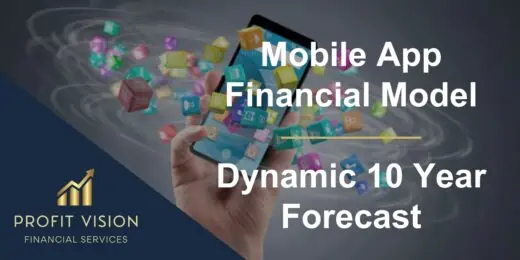
Mobile App Financial Model – Dynamic 10 Year Forecast
Financial Model providing a dynamic up to 10-year financial forecast for a Mobile Application Business.
- Full Excel Model – $129.00 Version 2

Subscription Meal Kit Financial & DCF Valuation Model
We are glad to present our new integrated, dynamic and ready-to-use Subscription Meal Kit Financial & DCF Valuation Model.
- Free PDF Version – $0.00 Version 1
- Full Excel Version – $69.00 Version 1

Subscription Box Financial Model – Up to 72 Months
Test many variables in this financial model for a subscription box company. Includes up to six pricing tiers with advanced retention configurations.
- Full Version – $125.00 Version 1

“Netflix for Gadgets” – Consumer-Tech Subscription/Rental Business Revenue and DCF Valuation Model
An integrated, dynamic and ready-to-use financial model for Consumer-Tech Subscription/Rental Business which is a brand new and emerging segment marke... read more
- Full Excel Model – $95.00
- Free PDF Demo – $0.00

FAST FOOD The Customer-Centric Financial Restaurant Model
Starting a fast food restaurant without a financial plan is like driving a car blindfolded. You wouldn´t do it because you are a careful person! As a... read more

Data-as-a-Service Financial Feasibility Study
This model is built for data-as-a-service startups. If you have valuable data to monetize, this template will allow for price testing, variable cost a... read more

Property Management Business Financial Model
Create a wide range of scenarios for the financial forecasting of a property management business. Includes an integrated 3 statement model.
- Full Version – $75.00 Version 1

Online Classes Subscription Financial Model Excel Template
Order Your Online Classes Subscription Financial Plan. This well-tested, robust, and powerful template is your solid foundation to plan a succes... read more
- Excel - Multi-User – $129.00
- Excel - Single-User – $99.00
- Free Demo – $0.00

Beauty Subscription Box Financial Model Excel Template
Check Beauty Box Subscription Financial Plan. Use this Excel to plan effectively, manage Cash Flows and foresight your growth for 5 years. The b... read more

Boutique Gym Financial Model – Dynamic 10 Year Forecast
Financial model providing a dynamic 10-Year Financial Plan for a Boutique Gym.
- Standard Version – $69.00
- Premium Version – $89.00
- PDF Free Demo – $0.00

Online Payments Platform – 5 Year Financial Model
Financial Model providing an advanced 5-year financial plan for a startup Online Payments Platform providing internet-based payment methods to busines... read more
- Excel Financial Model – $139.00 Version 1

Health & Fitness Club Financial Model – 5 Year Business Plan
5-Year Financial Model providing advanced financial & planning analysis for a Health and Fitness Club.
- Excel Financial Model – $99.00

Co-working Spaces – Dynamic 10 Year Financial Model
Financial Model providing a dynamic 10-year financial forecast for a Co-working Spaces Business.
- Financial Model - Standard Version – $89.00
- Financial Model - Premium Version – $109.00

Mobile App Financial Model Template
The financial model presents the business case of a Mobile App Business. A mobile application, also referred to as a mobile app or simply an app, is a... read more
- Full Excel Model – $119.00
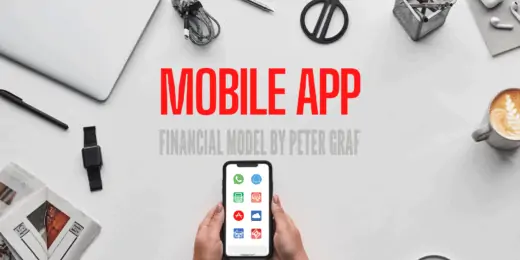
Mobile App Financial Model MEGA/GIGA + Video Tutorial
This simple, but powerful financial model in Excel helps you to plan your mobile app business in no time. Its unique benefit is the One-Screen-Assumpt... read more
- Excel Version MEGA – $79.00
- Excel Version GIGA – $99.00
- Free PDF Version GIGA – $0.00

Marketplace with 3 Subscription Tiers: 5 Year Financial Model
I built marketplace assumptions on to of my best subscription forecasting model to get this beautiful forecasting tool. Includes connected 3-statement... read more
- Full Excel Model – $175.00 Version 2

Social Media Platform – Dynamic 10 Year Financial Model
Financial Model providing a dynamic up to 10-year financial forecast for a startup Social Media Platform.

Tech/I.T. Services Company – 5 Year Financial Model
Financial Model providing an advanced 5-year financial plan for an I.T. Services Company.
- Financial Model - Standard Version – $89.00 Version 2
- Financial Model - Premium Version – $109.00 Version 2

VOD/OTT Streaming Platform – 10 Year Financial Model
Financial Model providing a 10-year financial plan for a startup or operating Video in Demand/Over-the-top Streaming Platform.

Function-as-a-Service (serverless computing) Financial Model
Create financial projections for a FaaS cloud computing services business. This is a recurring revenue business that can be monetized through monthly ... read more
- Full Model Version – $75.00 Version 1
- Lite Model Version – $65.00 Version 1

Wholesale Business 3 Statement Model with Returns Calculation
This model can be used to analyze the financial return of a wholesale business using a 3 statement model.
- Full Model – $40.00
- PDF Demo – $0.00

SAAS Financial Model Template
This easy to use Financial Model template enables you to model your SAAS business in an intuitive way.

Golf Course – Membership Only Model
Create a financial forecast for a members-only golf course. There are industry-specific caveats here that you need to understand if you are going into... read more

Urban Micro-Mobility Services Financial Model (10+ Yrs. DCF and Valuation)
The Urban Micro-Mobility Services Financial Model with DCF (Discounted Cash Flow) and Valuation is a comprehensive tool designed to analyze the financ... read more
- Free PDF – $0.00 Version 1
- Excel Model – $79.00 Version 1

Household Service Marketplace Financial and DCF Valuation Model
A complete and fully dynamic financial and DCF valuation model for a household service marketplace business based on a 5- year project.
- EXCEL PAID VERSION – $85.00 Version 1
- FREE PDF VERSION – $0.00 Version 1

Software as a Service (SaaS) Monthly 3-Statement Business Plan with Return Calculations
Pro Forma Models created this model to prepare and analyze a start-up or existing Software as a Service (SaaS) business plan forecast that incorporate... read more
- Full Excel Model – $50.00 Version 1
- Free PDF Demo – $0.00 Version 1

MARKET PLACE 3 Statement Financial Model Template – 5 Years Projections
Introducing the Future-Proof Market Place Financial Model Template: Unlock Your Business Potential! Are you an aspiring entrepreneur looking to ventur... read more
- Excel Model – $19.00 Version 1

SaaS Customer Feasibility and Margin Model
Design your ideal SaaS customer with all relevant terms configurable, including all initial costs/revenues/contract length/value/on-going costs/more. ... read more

AgroTech Services Financial Model (10+ Yrs. DCF and Valuation)
The AgroTech Services Financial Model with DCF (Discounted Cash Flow) and Valuation is a comprehensive tool designed to analyze the financial aspects ... read more

Live Streaming Startup Company – SaaS DCF Financial Model Template
A SaaS financial model for a Live Streaming Subscription Startup company. It is highly focused on the Subscription Revenue and five years DCF valuatio... read more
- Full Excel Version – $35.00
- Free PDF Version – $0.00

Crypto Trading Platform – 5 Year Financial Model
Financial Model presenting an advanced 5-year financial plan of a Crypto Trading Platform allowing customers to trade cryptocurrencies or digital curr... read more

Cleaning Service Pro Forma Template (Commercial / Residential)
A pro forma template for any home service or general service business. Includes bottom up assumptions for recurring contracts and/or fixed price jobs.

Social Media Influencer – 5 Year Financial Model
Financial Model providing a 5-year financial plan for a startup Social Media Influencer Business.
- Excel Financial Model – $89.00 Version 1
eCommerce Monthly 3-Statement Business Plan with Return Calculations
A model to prepare and analyze a start-up or existing eCommerce business. It incorporates the pre-sale launch period using a 3 statement model and key... read more

MOBILE APP FINANCIAL MODEL – Team Strategy FM
A modelling template that covers every aspect of the vast industry of mobile applications and development, all the way from fixed and recurring costs,... read more
- Excel Model – $89.00 Version 1
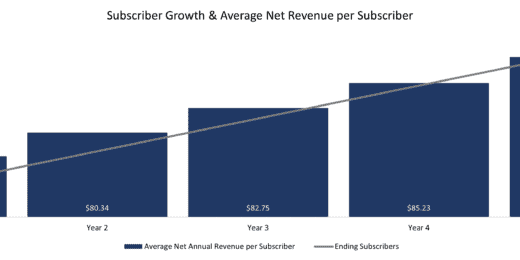
Mobile Applications (App) Monthly 3-Statement Business Plan with Return Calculation
Pro Forma Models created this model to prepare and analyze a start-up or existing mobile application (app) business plan forecast that incorporates a ... read more
- Full Model – $50.00 Version 1
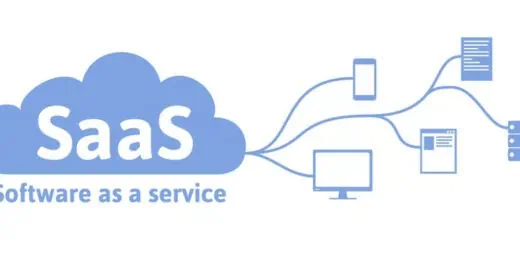
SaaS Company Financial Model and Valuation
Discover the SaaS Company Financial Model and Valuation, an essential tool designed to empower investors, entrepreneurs, stakeholders, finance enthusi... read more
- Free SaaS PDF – $0.00 Version 1
- SaaS Model – $29.99 Version 1
- Bundle with Cohort Analysis – $49.99 Version 1
- Bundle with Cohort Analysis and VC Model – $69.99 Version 1

SaaS CFO Dashboard: Advanced Analysis
Track your YTD SaaS key metrics with this simple dashboard. Includes MRR, CaC, LTV, and more financial analysis.
- Full Version – $45.00 Version 1
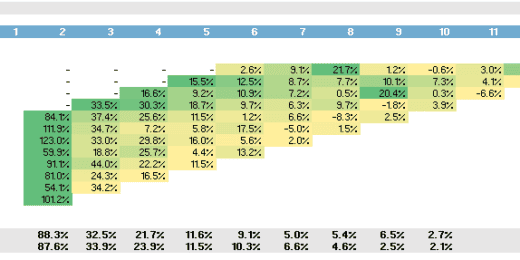
User Cohort Analysis | User Subscription Analysis
This meticulously crafted Excel model is designed for in-depth user behavior analysis (i.e., cohort analysis), allowing users to better understand the... read more
- Excel Model – $24.99 Version 1
Leave a Reply Cancel reply
You must be logged in to post a comment.

Shopify Subscription App
Start a Subscription Box Business Plan in 11 Easy Steps
A subscription box business plan is a comprehensive document that outlines the key aspects, goals, and strategies of a subscription box service. It serves as a roadmap for entrepreneurs, helping them define their objectives, identify their target market, plan their operations, and secure funding. In this article, we will explore what a business plan entails, discuss its importance in the context of subscription box services, outline the main steps to write a subscription box business plan, and provide popular samples for reference.
What Is a Business Plan?
A business plan is a written document that outlines the goals, strategies, financial projections, and operational details of a business. It serves as a roadmap for entrepreneurs, guiding them through the process of launching and managing their venture. A well-crafted business plan provides clarity, defines the business’s direction, and helps attract investors and partners.
Importance of Writing Business Plan in Subscription Box Services
In the context of subscription box services, a business plan plays a crucial role in several ways:
- Defining the Value Proposition: A business plan helps articulate the unique selling points of the subscription box service, such as the curated products, convenience, or personalization, which sets it apart from competitors.
- Understanding the Target Market: Through market research, a business plan helps identify the target audience, their preferences, and buying behaviors, enabling the business to tailor its offerings to meet customer needs effectively.
- Planning Operations and Logistics: A business plan outlines the operational requirements, including sourcing products, managing inventory, packaging, shipping, and customer service, ensuring smooth and efficient operations.
- Financial Projections and Funding: A well-developed business plan includes financial forecasts, such as revenue projections, cost analysis, and profitability estimates. This information is vital for attracting investors or securing funding from lenders.
11 Steps to Write Subscription Box Business Plan
A business plan outlines the steps you need to take to achieve your goals and objectives. It helps you to develop a clear strategy and to make informed decisions. It also helps to identify critical risks and opportunities that could affect your business.
Here is a summary of how to build a subscription box business in the beyond table:
| 1 | Conduct Market Research | 1. Identify target market demographics, preferences, and buying behaviors. 2. Analyze industry trends and competition. |
| 2 | Define Your Value Proposition | 1. Articulate the unique selling points of your subscription box service. 2.Highlight the benefits and value customers will receive by subscribing. |
| 3 | Outline Your Product and Service Offerings: | 1. Determine the types of products to include in your subscription boxes. 2. Consider customization options and pricing strategies. |
| 4 | Develop a Marketing and Sales Strategy | 1. Define customer acquisition channels, such as social media, influencer marketing, or content marketing. 2. Plan advertising campaigns and promotions to attract subscribers. |
| 5 | Prepare an Operations and Logistics Plan | 1. Outline sourcing and procurement processes for products. 2. Detail inventory management, packaging, and shipping procedures. 3. Establish customer support systems for inquiries and issue resolution. |
| 6 | Create Financial Projections | 1. Project revenue and expenses for the subscription box business. 2. Estimate profitability and cash flow. |
| 7 | Craft a Funding Request (if applicable) | 1. Clearly state the amount of funding required. 2. Explain how the funds will be utilized to support the business. |
In the following, we will provide a more comprehensive and detailed explanation of the steps involved in writing subscription box business plan , breaking it down stage by stage.
1. Executive Summary
Provide an overview of the business, its objectives, and unique selling proposition.
- Research and analyze successful subscription box businesses
- Identify industry trends, and gain insights into the competitive landscape.
- Clearly define the unique selling points and benefits that customers will receive by subscribing to your boxes.
- Consider factors such as product curation, personalization, exclusivity, convenience, or educational content.
- Your value proposition should resonate with your target market and compel them to choose your subscription box over others in the market.
2. Research the Market
Start by researching the competitive landscape to understand what other subscription brands are already in the market and what makes them successful. It’s important to identify any gaps in the market and areas where the subscription box business can be unique and stand out from the competition. In short, follow the tips below:
- Conduct market research to identify the demographics, preferences, and buying behaviors of your target audience.
- Determine their needs and pain points, and align your subscription box offerings accordingly.
- By catering to the specific desires of your target market, you can create a compelling and appealing subscription box service.
3. Define the Target Market
Next, it’s important to define the target market for the subscription brand. For Define the target market, you should answer these questions:
- Who are the customers that will be most likely to subscribe to the service?
- What are their pain points, interests, and needs?
Understanding the target market will be key to developing a successful subscription service.
4. Outline Your Product
Outline Your Product and Service Offerings means that you should determine the types of products you will include in your subscription boxes by considering the following factors:
- Product sourcing
- Quality, variety
- Customization options.
- Pricing structure and subscription tiers based on the value provided by your offerings.
- Your product and service offerings should align with your target market’s preferences and reflect your brand’s value proposition.
5. Set Goals
Set clear and achievable goals for your subscription brand like:
- Increasing customer retention
- Improving customer service
- Increasing revenue.
6. Plan Your Operations and Logistics
In this step, outline the operational requirements for running your subscription box business.
- Consider aspects such as product sourcing, inventory management, packaging, shipping, and customer support.
- It’s crucial to create a unique brand identity for the subscription service. This includes the logo, color palette, messaging, tone of voice, and visuals that will be used to communicate the brand.
- Determine how you will source products, manage inventory levels, and ensure timely and efficient fulfillment of orders.
- Additionally, establish customer support systems to address inquiries, concerns, and resolve any issues that may arise.
It is often that businesses neglect the importance of brand awareness due to the expense of having a marketing team. You can, however, contact Subify’s customer success team to get assistance with various aspects of your subscription box business plan, including marketing and UX design.
7. Develop a Marketing and Sales Strategy
Creating a robust marketing and sales strategy is essential for attracting and retaining subscribers.
- Social media
- Influencer marketing
- Email marketing
- Content marketing.
- Determine your customer acquisition tactics and develop strategies to promote your subscription box service.
- Consider offering incentives, referral programs, or limited-time offers to attract new subscribers and retain existing ones.
8. Create Financial Projections
Develop detailed financial projections for your subscription box business. You can follow these steps:
- Estimate your revenue streams, including subscription fees, one-time purchases, or additional services. Consider your cost structure, including product costs, packaging, shipping, marketing expenses, and operational costs.
- Project your expected expenses and calculate your profitability and cash flow.
- These financial projections will help you assess the viability of your business and attract potential investors or lenders.
- Estimate the costs associated with launching and running your subscription brand. This should include things such as advertising, marketing, materials, labor, and shipping.
- Having a budget table before launching your online subscription brand allows you to create a realistic timeline to set deadlines and ensure that all aspects of your business are ready to go when it is time to launch.
9. Outline the Business Model
The business model should be clearly outlined in the business plan. This includes:
- How the subscription service will be marketed?
- How it will be priced?
- How it will be packaged/delivered?
- How it will be managed. Are you planning to offer discounts?
- Would you like to receive pre-payments?
- How about setting delivery dates?
You can answer these questions with Subify tools in order to create the best subscription boxes on Shopify.
10. Write Subscription Box Business Plan
Now that you have gathered all the necessary information, it’s time to write your subscription box business plan :
- Start with an executive summary that provides an overview of your business, followed by a company description, market analysis, product and service description, marketing and sales strategy, operational plan, and financial projections.
- Ensure that your business plan is well-organized, concise, and showcases the unique aspects of your subscription box service.
11. Get Feedback
Ask for feedback from potential customers, industry experts, and other entrepreneurs. This will help you refine your subscription box business plan and ensure it’s ready for success. Allowing your customers to leave reviews on your products is also another way to receive a precise insight into your offerings.
By following these steps, you can create a business plan that will help your subscription brand stand out from the competition. Keep in mind that it’s important to keep your plan updated as your business grows and evolves. That way, you can ensure your subscription model is always relevant and up-to-date.
Subscription Box Business Plans: Tips For Being Successful
Creating a successful subscription brand requires careful planning and an understanding of the competitive landscape. That’s why a business plan is a great way to ensure that all of the necessary requirements are in place and that the subscription brand is unique and competitive enough to stand out.
When creating a subscription box business plan, look for these components:
1. Clear Goals: A business plan must have clear and specific goals that are easy to understand and measure. This will help keep the business on track and ensure that the subscription model is meeting the needs of the customer base.
2. Strategic Pricing: A subscription model requires careful consideration of pricing. It should be competitive enough to attract customers while still generating a healthy profit.
3. Customer Retention: Retaining customers is key to the success of a subscription box business that needs a helpful Retention Strategy . A good business plan should have strategies to keep customers engaged and coming back for more.
4. Automation: Automation is essential for streamlining operations and ensuring that the subscription model runs smoothly. Automation provides various benefits to businesses like:
- Streamlining sales tasks
- Providing powerful analytics that can be used to improve customer experiences.
But, at larger scales, automating payments is practically impossible, which is one of the reasons why customers turn to Subify , as their automated subscription management app.
5. Execution Plan: Last but not least, the business plan should include an execution plan that outlines the steps and processes needed to launch and manage the subscription business within a timeline.
Popular Samples for Subscription Box Business Plan
When writing a subscription box business plan, it can be helpful to refer to popular samples that provide guidance and inspiration. These samples can serve as valuable references to understand the structure, content, and key components of a well-crafted business plan. Here are some popular samples that you can explore:
Subscription Box Business Plan Template
A subscription box business plan template provides a framework that can be customized to suit your specific needs. It typically includes sections such as executive summary, company overview, market analysis, product description, marketing strategy, operational plan, and financial projections.
By using a template, you can ensure that you cover all the essential elements of a subscription box business plan in a systematic manner.
Subscription Box Business Plan Example
Examining a subscription box business plan example can offer real-world insights and practical ideas.
- Look for successful subscription box businesses examples, operating in similar industries or targeting a similar demographic.
- Analyze how they structure their business plans, highlight their unique value propositions, outline their marketing strategies, and present their financial projections. This will help you understand effective approaches and apply them to your own plan.
Industry-Specific Resources
Explore industry-specific resources and publications that may provide subscription box business plan examples or case studies. Look for blogs, articles, or books written by experts in the subscription box industry. These resources often offer valuable insights, best practices, and real-life examples that can inform your own business plan.
Subscription Box Business Communities and Forums
Joining subscription box business communities and forums can connect you with like-minded entrepreneurs and professionals in the industry. Engage in discussions, ask for recommendations, and share your goals.
Members of these communities may be willing to provide sample business plans or direct you to resources that can help you in your business planning process.
Final Thoughts
Planning is everything. Diving into a business without thinking it through first can lead to costly mistakes and wasted resources. The subscription box business is an opportunity for you to raise your revenue, build customer loyalty program , and make your brand stand out in the crowd. Taking a few primary steps early on will keep you from missing out on this opportunity.
Writing a subscription box business plan requires careful consideration and detailed analysis of various aspects of your business. By following the comprehensive steps outlined in this article, you can create a well-structured and informative business plan that will guide your subscription box service towards success. Remember, a subscription box business plan is a dynamic document that should be regularly reviewed and updated as your business evolves and grows.
Related Posts

12 Types Of Subscription Models In Business + Examples
Shopify subscription apps: what makes subify the best, how to set up subscriptions on shopify: a 5-step guide, leave a comment cancel reply.
Your email address will not be published. Required fields are marked *
Save my name, email, and website in this browser for the next time I comment.

Follow us on Social Media
[email protected]
+1 (206) 923 9471
Made with ❤️ in Vancouver, BC

Crafting a Winning Business Plan for Subscription Boxes: The Complete Guide
By alex ryzhkov, get full bundle.
| $169$99 | $59$39 | $39$29 | $15$9 | $25$15 | $15$9 | $15$9 | $15$9 | $19 |
Related Blogs
- Starting a Business
- KPI Metrics
- Running Expenses
- Startup Costs
- Pitch Deck Example
- Increasing Profitability
- Sales Strategy
- Rising Capital
- Valuing a Business
- How Much Makes
- Sell a Business
- Business Idea
- How To Avoid Mistakes
The subscription box industry has experienced remarkable growth in recent years, with a compound annual growth rate of 12.3% from 2019 to 2025, according to a report by Grand View Research. This booming market presents a lucrative opportunity for entrepreneurs looking to start their own subscription box business.
However, before diving into this exciting venture, it is crucial to have a well-crafted business plan in place. Writing a business plan for a subscription box involves a series of strategic steps to ensure your success in this competitive market.
Step 1: Identify your target market and niche
To create a successful subscription box business, it is essential to identify your target audience and cater to their specific interests and preferences. Conduct market research to understand their needs and interests, and carve out your niche.
Step 2: Conduct market research
In-depth market research is integral to understanding the demand and competition in the subscription box industry. Analyze consumer trends, study your target market, and identify gaps or opportunities that you can fill with your unique offering.
Step 3: Determine your unique selling proposition
With numerous subscription box services available, defining your unique selling proposition (USP) is crucial. Identify what sets your business apart from the competition and how you can provide a distinct value proposition to your customers.
Step 4: Analyze the competition
Thoroughly research and analyze your competitors in the subscription box market. Identify their strengths, weaknesses, and pricing strategies. This will help you refine your own business model and develop strategies to stand out.
Step 5: Define your business goals and objectives
Establish clear and measurable goals for your subscription box business. Define what you wish to achieve in terms of customer acquisition, revenue, and brand recognition. This will guide your decision-making process and help you stay focused on your objectives.
Step 6: Establish a pricing strategy
Determine how you will price your subscription box to ensure profitability while providing value to your customers. Consider factors such as product costs, shipping expenses, and the perceived value of your curated items.
Step 7: Create a marketing and sales plan
Develop a comprehensive marketing and sales strategy to attract and retain customers. Utilize digital marketing techniques, social media platforms, and influencer collaborations to build brand awareness and drive subscriptions.
Step 8: Develop a logistics and fulfillment strategy
Consider the logistics and fulfillment aspect of your subscription box business. Determine how you will source products, manage inventory, and ensure timely delivery to provide a seamless customer experience.
Step 9: Determine your financial requirements
Assess the financial aspects of your subscription box business, such as start-up costs, recurring expenses, and projected revenue. Determine the investment required and develop a financial plan to secure funding if needed.
Writing a business plan for a subscription box business is a vital step toward success. By following these nine strategic steps, you'll be well-equipped to navigate the competitive landscape and create a thriving subscription box service that keeps customers eagerly anticipating the unique treasures you deliver each month.
Identify Your Target Market And Niche
When starting a subscription box business, it is crucial to first identify your target market and niche . Understanding who your ideal customers are and what specific needs or interests they have will help you tailor your subscription box offerings to meet their expectations and provide value.
Here are some steps to help you identify your target market and niche:
- Research existing subscription box customers: Look into who is currently subscribing to similar services and analyze their demographics, preferences, and purchasing behaviors. This will give you insights into the potential market size and the specific interests you can cater to.
- Define your ideal customer persona: Create a detailed profile of your ideal customer, including their age, gender, location, interests, and lifestyle. Consider their pain points and how your subscription box can solve a problem or meet a need for them.
- Segment your target market: Break down your target market into specific segments based on factors such as demographics, interests, geographic location, or buying behavior. This will help you better understand the unique needs and preferences of each segment and tailor your marketing strategies accordingly.
- Conduct surveys and gather feedback: Engage with your target market through surveys and feedback forms to gain insights into their preferences, expectations, and suggestions. This will provide valuable information to refine your subscription box offerings and improve customer satisfaction.
- Focus on a specific niche or interest within your target market to differentiate your subscription box from competitors.
- Stay up-to-date with industry trends and consumer preferences to identify emerging niches or changing customer needs.
- Consider conducting focus groups or interviews with potential customers to gain deeper insights into their preferences and expectations.
| Subscription Box Financial Model Get Template |
Conduct Market Research
Market research is a crucial step in the process of developing a business plan for your subscription box service. It provides valuable insights into your target market, helps you gather information about your potential customers, and allows you to identify trends and opportunities in the industry. To conduct effective market research, follow these essential steps:
- Identify your target market and niche: Before diving into research, it is essential to clearly define who your target customers are and the specific niche you want to focus on. This will help you tailor your research efforts to gather relevant and useful data.
- Gather primary and secondary data: Use a combination of primary and secondary research methods to gather data. Primary research involves directly interacting with potential customers through surveys, interviews, or focus groups, while secondary research involves gathering information from existing sources such as industry reports, competitor analysis, and market trends.
- Analyze consumer behavior: Dive deep into understanding your potential customers' preferences, buying habits, and motivations. This will help you identify the key factors that influence their decision-making process and enable you to position your subscription box service effectively.
- Study the industry: Conduct a thorough analysis of the subscription box industry to understand its current state, growth prospects, and the competitive landscape. Identify successful subscription box services and learn from their strategies and best practices.
- Identify market trends and gaps: Look for emerging trends in the market and identify any gaps or unmet needs that your subscription box service can address. This will help you differentiate your offering and provide unique value to your customers.
Tips for conducting effective market research:
- Use a combination of quantitative and qualitative research methods for a comprehensive understanding of your target market.
- Consider hiring a market research firm or working with consultants specialized in the subscription box industry to gain expert insights.
- Stay updated with the latest industry news, blogs, and forums to keep track of evolving market trends and customer preferences.
- Engage with your potential customers through social media platforms, online communities, or forums to gather firsthand feedback and insights.
- Regularly revisit and update your market research to adapt to changing customer needs and market dynamics.
Determine Your Unique Selling Proposition
In order to stand out in a competitive subscription box market, it is crucial to determine your unique selling proposition (USP). Your USP is what sets your subscription box apart from others and gives customers a compelling reason to choose your service.
When determining your USP, consider the following:
- Target Market: Identify the specific group of customers you want to attract. Understanding their needs, preferences, and pain points will help you develop a USP that speaks directly to them.
- Value Proposition: Define the unique value your subscription box offers. What problem does it solve for customers? How does it improve their lives or enhance their experience?
- Product Differentiation: Highlight what makes your curated products special. Are they exclusive, limited edition, or sourced from local artisans? Emphasize the quality, uniqueness, or novelty of the items included.
- Customer Experience: Consider how you can provide an exceptional customer experience. This could include personalized product recommendations, surprise bonuses, or exceptional customer service.
- Research your potential competitors to identify gaps in the market that you can fill with your USP.
- Conduct surveys or gather feedback from your target market to understand their preferences and expectations.
- Stay updated with industry trends and consumer demands to continuously innovate and refine your USP.
By determining your unique selling proposition, you will have a clear direction for your subscription box business and a strong selling point that resonates with your target market. This will not only attract customers but also help build long-term loyalty and differentiate your brand in a competitive industry.
Analyze The Competition
An important step in developing a successful business plan for your subscription box service is to thoroughly analyze the competition in your market. By understanding what other companies are offering and how they are positioning themselves, you can identify opportunities to differentiate your business and attract customers.
Start by researching other subscription box services that cater to a similar target market or offer similar products. Look at their pricing, product offerings, and customer reviews to gain insights into what is already popular in the industry.
Here are some important aspects to consider when analyzing the competition:
- Product Selection: Take note of the types of products other subscription box services are including in their boxes. This will help you understand what products are in-demand and potentially identify gaps or opportunities for unique offerings.
- Pricing Strategy: Evaluate how competitors are pricing their subscription boxes. Consider whether you want to offer a similar price range or differentiate yourself by offering more affordable or higher-end options.
- Customer Experience: Look at how competitors are engaging with their customers and providing added value. This can include personalization options, customer service, or exclusive discounts.
- Marketing Strategies: Investigate the marketing tactics that successful subscription box companies utilize. This can give you an idea of effective channels for reaching your target market and generating buzz around your own service.
After gathering information on your competition, use these insights to carve out your unique selling proposition (USP). Your USP should highlight what sets your subscription box service apart from the rest and why customers should choose you over the competition.
By thoroughly analyzing the competition and leveraging this information to differentiate your business, you can position yourself for success in the subscription box market.
Define Your Business Goals And Objectives
Defining clear and achievable business goals and objectives is crucial for the success of your subscription box business. These goals will serve as a roadmap that will guide your decision-making and help you stay focused on what matters most. Here are some important considerations when defining your business goals and objectives:
- Identify your long-term vision: Start by envisioning where you want your business to be in the long run. What is the ultimate goal you want to achieve? This could be scaling the business to a certain number of subscribers, becoming a recognized brand in your niche, or achieving a specific revenue target. Your business goals should align with this long-term vision.
- Set specific and measurable objectives: Break down your long-term vision into smaller, specific objectives. These objectives should be measurable, allowing you to track your progress. For example, if your long-term vision is to achieve a certain revenue target, your objective could be to increase monthly sales by a certain percentage or acquire a specific number of new subscribers each month.
- Consider short-term and long-term goals: It's important to set both short-term and long-term goals. Short-term goals should be achievable within a shorter timeframe, such as three to six months, while long-term goals can span over a year or more. Short-term goals can help you stay motivated and provide immediate direction, while long-term goals keep you focused on the bigger picture.
- Make your goals SMART: Specific, Measurable, Achievable, Relevant, and Time-bound.
- Consider both financial and non-financial objectives, such as customer satisfaction, brand recognition, or social impact.
- Regularly review and adjust your goals as your business evolves and external factors change.
Defining your business goals and objectives is an ongoing process. As your subscription box business grows and adapts, you may need to revise and refine your goals to keep up with market trends and customer demands. Remember that setting clear goals and objectives will help keep your business on track and ensure that you are continuously working towards success.
Establish A Pricing Strategy
Establishing a pricing strategy is crucial for the success of your subscription box business. It is important to strike a balance between offering value to your customers and ensuring profitability for your company. Below are some important considerations when determining your pricing strategy:
- Cost analysis: Calculate the costs involved in sourcing the products, packaging, shipping, and any additional expenses. This will help you understand your cost per box and make informed decisions when setting the price.
- Value proposition: Consider the unique value you are providing to your customers. Are the products you offer exclusive or hard to find elsewhere? Does your subscription box cater to a specific niche or interest? Highlighting these unique aspects can justify a higher price point.
- Competitor analysis: Research the pricing strategies of your competitors. Compare the value they offer and the prices they charge. This will give you insights into the market norms and help you position your subscription box accordingly.
- Tiered pricing: Consider offering different subscription tiers at different price points. This allows customers to choose a plan that aligns with their budget and preferences. Higher-tier plans can offer additional benefits, such as exclusive items or faster shipping, to justify the higher price.
- Customer feedback: Seek feedback from your target market through surveys or focus groups. Understand what they would be willing to pay for your subscription box and adjust your pricing strategy accordingly.
Tips for establishing a successful pricing strategy:
- Consider offering a discounted rate for customers who commit to longer subscription periods. This encourages customer loyalty and reduces churn.
- Regularly evaluate your pricing strategy to ensure it remains competitive and aligned with your business goals.
- Offer occasional promotions or limited-time offers to attract new customers and create buzz around your subscription box.
- Monitor your costs and be prepared to adjust your pricing if necessary to maintain profitability.
Create A Marketing And Sales Plan
Developing an effective marketing and sales plan is crucial for the success of your subscription box business. This plan will outline the strategies and tactics you will use to attract and retain customers, as well as generate revenue.
1. Identify your target market: Clearly define your ideal customer and understand their demographics, interests, and purchasing behavior. This will help you tailor your marketing messages and reach the right audience.
2. Craft a compelling brand story: Create a brand identity that resonates with your target audience. Clearly communicate what sets your subscription box apart from competitors and why customers should choose your service.
3. Use a multi-channel approach: Utilize various marketing channels to reach your target market effectively. This may include social media, email marketing, content marketing, influencer partnerships, and traditional advertising.
4. Leverage user-generated content: Encourage your subscribers to share their unboxing experiences on social media and provide testimonials and reviews. This not only helps build trust and credibility but also serves as free advertising for your business.
5. Offer incentives for referrals: Implement a referral program that rewards current subscribers for referring new customers. Word of mouth can be a powerful marketing tool, and incentivizing referrals can help grow your subscriber base.
6. Measure and analyze your marketing efforts: Track the performance of your marketing campaigns, such as website traffic, email open rates, conversion rates, and customer acquisition cost. Use this data to optimize your strategies and allocate your marketing budget effectively.
- Invest in email marketing to nurture relationships with your subscribers and keep them engaged.
- Collaborate with influencers or bloggers in your target niche to reach a wider audience.
- Create engaging and shareable content, such as videos or blog posts, that aligns with your customers' interests.
- Consider offering limited-time promotions or exclusive discounts to create a sense of urgency and encourage conversions.
Remember, a well-executed marketing and sales plan will help you attract new customers, retain existing ones, and ultimately drive the growth of your subscription box business.
Develop A Logistics And Fulfillment Strategy
When it comes to running a subscription box business, having a robust and efficient logistics and fulfillment strategy is crucial. This step involves the planning and execution of getting your curated boxes from your suppliers to your customers' doorsteps in a timely and cost-effective manner.
Here are some important considerations to keep in mind:
- Inventory Management: It is essential to have a solid system in place to manage your inventory. This includes tracking stock levels, coordinating with suppliers for timely deliveries, and maintaining accurate records of product quantities.
- Packaging and Presentation: The packaging of your subscription box plays a significant role in enhancing the overall customer experience. Ensure that your packaging not only protects the products but also aligns with your brand image and creates a sense of excitement upon opening.
- Shipping and Delivery: Research and partner with reliable shipping carriers to ensure smooth and timely deliveries. Consider factors such as cost, delivery speed, and order tracking capabilities to provide a seamless experience for your customers.
- Quality Control: Implement a rigorous quality control process to ensure that each box contains the right items and meets your quality standards. This ensures customer satisfaction and reduces the chances of returns or complaints.
- Customer Support: Develop a comprehensive customer support system to address any issues or concerns that may arise during the fulfillment process. This includes promptly responding to inquiries, addressing shipping delays, and facilitating returns or exchanges when necessary.
Tips for Developing a Successful Logistics and Fulfillment Strategy:
- Consider outsourcing fulfillment to a third-party logistics provider (3PL) for scalability and cost efficiency.
- Regularly review and optimize your logistics processes to improve efficiency and reduce costs.
- Invest in software or tools that can streamline inventory management and automate order fulfillment.
- Communicate transparently with your customers regarding shipping timelines and any potential delays.
A well-executed logistics and fulfillment strategy is crucial for ensuring customer satisfaction and streamlining your operations. By carefully planning and implementing this step, you will be able to deliver an exceptional subscription box experience to your customers, ultimately contributing to the long-term success of your business.
Determine Your Financial Requirements
Determining your financial requirements is crucial to the success of your subscription box business. It is important to have a clear understanding of the financial resources you will need to launch and sustain your venture. Here are some key steps to help you determine your financial requirements:
- Calculate startup costs: Identify all the expenses involved in starting your subscription box business, such as sourcing products, packaging, website development, marketing, and legal fees. Consider any upfront investments needed for inventory and infrastructure.
- Estimate monthly expenses: Determine your ongoing operational costs, including rent, utilities, employee salaries, inventory replenishment, and marketing expenses. It is essential to have a realistic estimate of your monthly expenses to calculate profitability.
- Forecast revenue: Conduct thorough market research and analyze industry trends to estimate your potential revenue. Consider factors such as the size of your target market, pricing strategy, and customer retention rate. Create a realistic forecast that outlines your expected monthly and annual revenue streams.
- Calculate breakeven point: Determine the number of subscribers or revenue you need to cover your fixed and variable costs. This will help you understand when your business will start generating profits and guide your growth strategy.
- Explore funding options: Assess your personal financial resources and consider whether you need external funding to start or scale your business. Research different funding options such as loans, grants, or seeking investors. Prepare a detailed business plan and financial projections to make a compelling case for funding.
- Be conservative with your revenue projections and factor in potential challenges or market fluctuations.
- Consider creating a contingency fund to cover unexpected expenses or to navigate through periods of low revenue.
- Regularly review and update your financial projections to adapt to changing market conditions or operational expenses.
- Consult with a financial advisor or accountant to ensure your financial plan is accurate and in line with your business goals.
In conclusion, writing a business plan for a subscription box requires careful consideration of your target market, competition, unique selling proposition, and financial requirements. By following the nine steps outlined in this checklist, you can effectively plan and launch your personalized and curated product subscription service. With a strong strategic foundation in place, you can attract loyal customers, support independent creators, and grow a successful subscription box business in the competitive US market.
| Expert-built startup financial model templates |
Leave a comment
Your email address will not be published. Required fields are marked *
Please note, comments must be approved before they are published

Subscription Box Business Plan Template [Updated 2024]
Subscription Box Business Plan Template
If you want to start a subscription box business or expand your current subscription box business, you need a business plan.
Fortunately, you’re in the right place. Our team has helped develop over 100,000 business plans over the past 20 years, including thousands of subscription box business plans.
The following subscription box business plan template and example gives you the key elements you must include in your plan.
You can download our Ultimate Business Plan Template (including a full, customizable financial model) to your computer here.
Subscription Box Business Plan Example
I. executive summary, business overview.
[Company Name] is a new cosmetics subscription box company located in [Location]. For a monthly fee, customers can order a box of their favorite cosmetics and have them delivered right to their door. We offer multiple subscriptions to choose from. Some of our subscriptions allow customers to choose the cosmetics they want while others include top picks, recommended products, and surprises. We provide the best customer service in the industry and aim to be the #1 cosmetics subscription company in the nation in five years.
Products Served
Every month, customers will pay a fee to get a subscription box of cosmetics delivered to their door. The boxes will vary based on the month as well as the subscription that the customer signed up for. Our subscription boxes will contain a variety of products in these categories:
Customer Focus
[Company Name] is an online store that can ship subscription boxes anywhere in the United States. We expect much of our customer base will consist of women and individuals ages 18-35.
Management Team
[Company Name] is founded by [Founder’s Name], who has 20 years of experience in the beauty industry. She began her career as an assistant manager at a beauty supply store, where she sold thousands of products to thousands of satisfied customers. Through her work in this role, she began to develop ideas for how customers could receive a selection of ideal products in a more convenient and affordable format. This led to the creation of the subscription box model. Though she does not have experience running her own company, she will hire other employees to help her run aspects of the business she is unfamiliar with.
Success Factors
[Company Name] is uniquely qualified to succeed for the following reasons:
- Subscription box businesses and online cosmetics companies are in high demand.
- The management team has a track record of success in the beauty business.
- The cosmetics subscription box industry is a proven business and has succeeded in communities throughout the United States.
Financial Highlights
[Company Name] is currently seeking $350,000 to launch. Specifically, these funds will be used as follows:
- Office build/lease: $100,000
- Initial inventory and supplies: $100,000
- Working capital: $150,000 to pay for marketing, salaries, and overhead costs until [Company Name] reaches break-even.
Top line projections over the next five years are as follows:
| Financial Summary | FY 1 | FY 2 | FY 3 | FY 4 | FY 5 |
|---|---|---|---|---|---|
| Revenue | $560,401 | $782,152 | $1,069,331 | $1,379,434 | $1,699,644 |
| Total Expenses | $328,233 | $391,429 | $552,149 | $696,577 | $776,687 |
| EBITDA | $232,168 | $390,722 | $517,182 | $682,858 | $922,956 |
| Depreciation | $7,000 | $7,000 | $7,000 | $7,000 | $7,000 |
| EBIT | $225,168 | $383,722 | $510,182 | $675,858 | $915,956 |
| Interest | $6,016 | $5,264 | $4,512 | $3,760 | $3,008 |
| Pre Tax Income | $219,152 | $378,458 | $505,670 | $672,098 | $912,948 |
| Income Tax Expense | $76,703 | $132,460 | $176,985 | $235,234 | $319,532 |
| Net Income | $142,449 | $245,998 | $328,686 | $436,864 | $593,416 |
| Net Profit Margin | 25% | 31% | 31% | 32% | 35% |
II. Company Overview
You can download our Business Plan Template (including a full, customizable financial model) to your computer here.

Who is [Company Name]?
[Company Name] is a new cosmetics subscription box company located in [Location]. For a monthly fee, customers can order a box of their favorite cosmetics and have them delivered right to their door. We offer flexible subscription options to ensure our customers get exactly what they are looking for.
One option we offer is a box of items that the customer specifically chooses. Customers can choose from a variety of categories, including makeup, skincare, hair care, and bath and body products. They can also choose the specific brands and products they want to receive. This option is perfect for customers who know exactly what they want and want to be able to customize their boxes.
We also offer mystery box subscriptions for adventurous customers who want to try something new. These boxes are filled with a variety of surprise products, curated by our team of experts. Customers never know what they’re going to get, but they’re sure to find something they love. This option is perfect for customers who are open to trying new things and who want to discover new products.
With a large inventory of products and multiple subscription options, we expect that we will become the most popular cosmetics subscription service in the country in just a few years.
[Company Name]’s History
[Founder’s Name] has spent the past year researching what it takes to establish a subscription box business. She has analyzed the costs, market, demographics, and competition. [Founder’s Name] has compiled enough information to develop her business plan to approach investors.
[Founder’s Name] incorporated [Company Name] as an S-corporation on [Date of Incorporation]. Since incorporation, [Company Name] has achieved the following milestones:
- Developed the company’s name, logo, and website at [website]
- Determined inventory and supply requirements
- Began recruiting key employees
[Company Name]’s Products/Services
- Makeup : Foundation, concealer, powder, blush, bronzer, eyeshadow, eyeliner, mascara, lipstick, lip gloss, and nail polish.
- Skincare : Cleansers, moisturizers, toners, serums, exfoliators, masks, and eye creams.
- Haircare : Shampoos, conditioners, styling products, and hair tools.
- Body care : Body wash, lotion, scrubs, deodorant, and antiperspirant.
- Fragrance : Perfumes, colognes, and body mists.
The exact products that arrive will depend on the month and the subscription that the customer chose. Some of our subscription options allow our customers to choose the exact products that they want. Other options allow us to choose for our customers, which means the boxes will be filled with recommended products, top picks, and other surprises.
III. Industry Analysis
You can download our Business Plan Template (including a full, customizable financial model) to your computer here. The subscription box model has become increasingly popular in recent years. These businesses allow consumers to enjoy their favorite products on a monthly basis for a flat fee. Some subscription boxes allow the customer to choose exactly what they want (such as meal kit boxes) while others send their customers a surprise or items based on particular themes (such as Loot Crate). [Company Name] will compete with thousands of other subscription box companies, particularly those that sell cosmetics.
According to The Business Research Company, the subscription box industry was valued at $31.4 billion in 2023 and is expected to grow at a CAGR of 18.2% over the next several years. This growth is being driven by a number of factors, including:
- The convenience of receiving a curated selection of products on a regular basis.
- The ability to try new products and brands without having to commit to a full-size purchase.
- The perceived value of subscription boxes, which often offer discounts on products that would be more expensive to purchase individually.
We believe that our company will be able to capitalize on the growing demand for subscription boxes and cosmetics by offering a unique and innovative product experience. With all of these positive trends, we expect that [Company Name] will become a major competitor in the subscription box industry.
IV. Customer Analysis
Demographic profile of target market.
[Company Name] will serve any U.S. customers who are interested in cosmetics. We expect this customer base to primarily be young to middle-aged adults who are middle-class or affluent.
Customer Segmentation
We will primarily target the following three customer segments:
- Women : Traditionally, women purchase a majority of cosmetics in the U.S. market. We expect most of our customers to be female.
- Millennials : Millennials are a growing demographic with a strong interest in personal care products. They are also more likely to be open to trying new brands and products.
- Gen-Z : Gen-Z is a younger demographic, but they are already making a significant impact on the cosmetics market. They are more likely to be digitally savvy and value authenticity in brands.
V. Competitive Analysis
Direct & indirect competitors.
The following establishments are major players in the subscription box industry, thus providing either direct or indirect competition for customers:
Birchbox Birchbox is a popular subscription box service that sends customers a curated selection of beauty products each month. The company has over 1 million subscribers and has been featured in publications such as Vogue, Elle, and Cosmopolitan. Each month, Birchbox sends its customers trial sizes of premium beauty products from a wide range of top-tier brands. Due to its popularity and large customer base, we expect that Birchbox will be our biggest competitor.
Shannon’s Cosmetics Shannon’s Cosmetics is a subscription box service that sends customers a monthly box of cosmetics samples from luxury brands. The company has over 50,000 subscribers and is promoted by several major Instagram influencers. While Shannon’s Cosmetics is a major competitor, they have the disadvantage of only providing one subscription option. Every month, all their customers receive the same products, whether they want them or not. Consumers who want more customization will find our subscription boxes more appealing.
Makeup-in-a-box Makeup-in-a-box is a subscription box service that sends customers a monthly box of full-size makeup products. The company has over 20,000 subscribers and has been featured in several publications. The subscription model allows consumers to purchase four to six full-sized products for less than if they bought them individually. However, the subscription only delivers makeup products and customers cannot choose what items come in their box. Those looking for more customization and a wider variety of products will be more inclined to subscribe with [Company Name].
Competitive Advantage
[Company Name] enjoys several advantages over its competitors. These advantages include the following:
- Great products and subscriptions at an affordable price : The complete array of beauty products and subscriptions offered by [Company Name] nearly equals the most premium-positioned competitors. However, [Company Name] will offer these services at a much more affordable price.
- Management : Our management team has years of business and marketing experience that allows us to market to and serve customers in a much more sophisticated manner than our competitors.
- Customer-Oriented Service : We will create our subscription boxes based on customer feedback and preferences. [Company Name] plans to offer more variety and high-quality products that will keep customers coming back for more.
VI. Marketing Plan
The [company name] brand.
The [Company Name] brand will focus on the company’s unique value proposition:
- Offering the best cosmetics and supplies in the industry.
- Offering a variety of subscription boxes to choose from.
- Providing excellent customer service.
Promotions Strategy
[Company Name]’s promotions strategy to reach our target market includes:
Website/SEO [Company Name] will develop a professional website that showcases the variety of cosmetics we sell. It will also explain our subscription box model and the multiple subscription plans we provide. It will also invest in SEO so that the company’s website will appear at the top of search engine results.
Social Media [Company Name] will create social media accounts and invest in ads on all social media platforms. The company will use targeted marketing to appeal to our target demographics.
Referrals [Company Name] understands that the best promotion comes from satisfied customers. The company will encourage its customers to refer other individuals by providing discounts on future subscription boxes for every new customer who signs up for our service. This strategy will increase in effectiveness over time.
Special Offers Offers and incentives are an excellent approach to bringing in new customers. The company will introduce special offers on products to attract new consumers.
Influencer Marketing [Company Name] will partner with social media influencers to promote the company’s value proposition and variety of products.
Email Marketing [Company Name] will maintain ongoing email communications with current customers to communicate special offers, discounts, and important updates.
Pricing Strategy
[Company Name]’s pricing will be moderate so customers feel they receive great value when purchasing its products.
VII. Operations Plan
Functional roles.
To execute [Company Name]’s business model, the company needs to perform many functions, including the following:
Administrative Functions
- Bookkeeping
- Hiring and training staff
- Website and social media management
- General administrative tasks
Service Functions
- Customer service
- Box up subscription orders
- Source and store supplies
| Date | Milestone |
|---|---|
| [Date 1] | Finalize lease agreement |
| [Date 2] | Design and build out [Company Name] |
| [Date 3] | Hire and train initial staff |
| [Date 4] | Kickoff of promotional campaign |
| [Date 5] | Launch [Company Name] |
| [Date 6] | Reach break-even |
VIII. Management Team
Management team members.
[Company Name] is founded by [Founder’s Name], who has 20 years of experience in the beauty industry. She began her career as an assistant manager at a beauty supply store, where she sold thousands of products to thousands of satisfied customers. Through her work in this role, she began to develop ideas for how customers could receive a selection of ideal products in a more convenient and affordable format. This led to the creation of the subscription box model.
Though she has never run a cosmetics or subscription box company herself, she has worked in the industry long enough to gain an in-depth knowledge of the business, including the operations side (e.g., running day-to-day operations) and the business management side (e.g., staffing, marketing, etc.). She will also hire several other employees to help her manage the aspects that she is unfamiliar with.
Hiring Plan
[Founder’s Name] will serve as the President of the company. To launch the store, we need to hire the following personnel:
- Production Associates (3 to start)
- Administrative Assistants (1 to start)
- Customer Service Associates (2 to start)
IX. Financial Plan
Revenue and cost drivers.
[Company Name]’s revenues will come from the fees we charge for our subscription boxes.
The major costs for the company will be the cost of inventory, salaries of the staff, and rent for a prime location. In the initial years, the company’s marketing spend will be high, as it establishes itself in the market.
Capital Requirements and Use of Funds
5 Year Annual Income Statement
| Year 1 | Year 2 | Year 3 | Year 4 | Year 5 | ||
|---|---|---|---|---|---|---|
| Revenues | ||||||
| Product/Service A | $151,200 | $333,396 | $367,569 | $405,245 | $446,783 | |
| Product/Service B | $100,800 | $222,264 | $245,046 | $270,163 | $297,855 | |
| Total Revenues | $252,000 | $555,660 | $612,615 | $675,408 | $744,638 | |
| Expenses & Costs | ||||||
| Cost of goods sold | $57,960 | $122,245 | $122,523 | $128,328 | $134,035 | |
| Lease | $60,000 | $61,500 | $63,038 | $64,613 | $66,229 | |
| Marketing | $20,000 | $25,000 | $25,000 | $25,000 | $25,000 | |
| Salaries | $133,890 | $204,030 | $224,943 | $236,190 | $248,000 | |
| Other Expenses | $3,500 | $4,000 | $4,500 | $5,000 | $5,500 | |
| Total Expenses & Costs | $271,850 | $412,775 | $435,504 | $454,131 | $473,263 | |
| EBITDA | ($19,850) | $142,885 | $177,112 | $221,277 | $271,374 | |
| Depreciation | $36,960 | $36,960 | $36,960 | $36,960 | $36,960 | |
| EBIT | ($56,810) | $105,925 | $140,152 | $184,317 | $234,414 | |
| Interest | $23,621 | $20,668 | $17,716 | $14,763 | $11,810 | |
| PRETAX INCOME | ($80,431) | $85,257 | $122,436 | $169,554 | $222,604 | |
| Net Operating Loss | ($80,431) | ($80,431) | $0 | $0 | $0 | |
| Income Tax Expense | $0 | $1,689 | $42,853 | $59,344 | $77,911 | |
| NET INCOME | ($80,431) | $83,568 | $79,583 | $110,210 | $144,693 | |
| Net Profit Margin (%) | - | 15.00% | 13.00% | 16.30% | 19.40% |
| Year 1 | Year 2 | Year 3 | Year 4 | Year 5 | ||
|---|---|---|---|---|---|---|
| ASSETS | ||||||
| Cash | $16,710 | $90,188 | $158,957 | $258,570 | $392,389 | |
| Accounts receivable | $0 | $0 | $0 | $0 | $0 | |
| Inventory | $21,000 | $23,153 | $25,526 | $28,142 | $31,027 | |
| Total Current Assets | $37,710 | $113,340 | $184,482 | $286,712 | $423,416 | |
| Fixed assets | $246,450 | $246,450 | $246,450 | $246,450 | $246,450 | |
| Depreciation | $36,960 | $73,920 | $110,880 | $147,840 | $184,800 | |
| Net fixed assets | $209,490 | $172,530 | $135,570 | $98,610 | $61,650 | |
| TOTAL ASSETS | $247,200 | $285,870 | $320,052 | $385,322 | $485,066 | |
| LIABILITIES & EQUITY | ||||||
| Debt | $317,971 | $272,546 | $227,122 | $181,698 | $136,273 | |
| Accounts payable | $9,660 | $10,187 | $10,210 | $10,694 | $11,170 | |
| Total Liabilities | $327,631 | $282,733 | $237,332 | $192,391 | $147,443 | |
| Share Capital | $0 | $0 | $0 | $0 | $0 | |
| Retained earnings | ($80,431) | $3,137 | $82,720 | $192,930 | $337,623 | |
| Total Equity | ($80,431) | $3,137 | $82,720 | $192,930 | $337,623 | |
| TOTAL LIABILITIES & EQUITY | $247,200 | $285,870 | $320,052 | $385,322 | $485,066 |
| Year 1 | Year 2 | Year 3 | Year 4 | Year 5 | |
|---|---|---|---|---|---|
| CASH FLOW FROM OPERATIONS | |||||
| Net Income (Loss) | ($80,431) | $83,568 | $79,583 | $110,210 | $144,693 |
| Change in working capital | ($11,340) | ($1,625) | ($2,350) | ($2,133) | ($2,409) |
| Depreciation | $36,960 | $36,960 | $36,960 | $36,960 | $36,960 |
| Net Cash Flow from Operations | ($54,811) | $118,902 | $114,193 | $145,037 | $179,244 |
| CASH FLOW FROM INVESTMENTS | |||||
| Investment | ($246,450) | $0 | $0 | $0 | $0 |
| Net Cash Flow from Investments | ($246,450) | $0 | $0 | $0 | $0 |
| CASH FLOW FROM FINANCING | |||||
| Cash from equity | $0 | $0 | $0 | $0 | $0 |
| Cash from debt | $317,971 | ($45,424) | ($45,424) | ($45,424) | ($45,424) |
| Net Cash Flow from Financing | $317,971 | ($45,424) | ($45,424) | ($45,424) | ($45,424) |
| SUMMARY | |||||
| Net Cash Flow | $16,710 | $73,478 | $68,769 | $99,613 | $133,819 |
| Cash at Beginning of Period | $0 | $16,710 | $90,188 | $158,957 | $258,570 |
| Cash at End of Period | $16,710 | $90,188 | $158,957 | $258,570 | $392,389 |
Comments are closed.

- Launch a Business
- Roll out New Pricing
- Expand Globally
- Shift to Subscriptions
- Move Upmarket
- Introduce Self-Serve
- E-Publishing
- OTT & Video
- North America
- Asia Pacific
- Founder/CEO
- Learning Hub
- Documentation
- Product Documentation
- API Documentation
- Services & Implementation
- Help & Support

- Building Chargebee
- Customer Retention
How To Create A Subscription Box Business Plan?

It’s a great time to be in the subscription box business.
Subscription boxes have been on the rise for years, and the COVID-19 pandemic has given them a massive boost. 20% of US consumers subscribed to a box during the pandemic just to have these products available without going to a store.
And it’s not just the pandemic — 51% of shoppers get subscription boxes just to try new products.
In other words, if you’ve been dreaming of starting a subscription box business , now’s a good time to do so. But you’re going to need a plan.
Subscription boxes are competitive, and it can be hard to reach your target customers. Factors such as fulfillment and recurring billing can get complicated. To give your subscription business a chance, you need to have a comprehensive business plan.
This article will give you the information you need to create a successful subscription box business plan.
The Growth of the Subscription Box Industry
Subscription boxes began their rapid rise in popularity a little over a decade ago. Between 2010 and 2012, the world was introduced to subscription box pioneers like Birchbox, BarkBox, Dollar Shave Club, and Blue Apron.
In 2021, the global subscription box market size reached a value of $22.7 billion , and it’s expected to reach $65 billion by 2027.
While subscription boxes have been around for a while, they really took off during the pandemic. For example, boxes related to pets and animals saw a 147% growth in subscribers between 2019 and 2020, while the number of beauty box and food box subscribers grew by 120% and 100%, respectively.
Why Your Subscription Box Business Needs a Business Plan ?
Starting a subscription box company is complex. A business plan helps you put all the pieces together and achieve your business goals.
Here’s what a business plan can do for you.
Prove Your Idea is Viable
A business plan includes research and analysis of the market, your niche, and your target audience. It demonstrates how your subscription box idea will fit into the existing landscape.
Secure Funding
A business plan can help investors and lenders see your company’s value. They want to know that you not only have a fun idea but a viable plan to profit.
Keep Everyone on the Same Page
If you have multiple decision-makers in your subscription box business, a business plan keeps the entire team aligned.
Plan for Expenses
A business plan helps you set realistic expectations for your upfront and ongoing expenses. It lays out how much cash you will need and where you expect to get it.
Reduce Risks
Your business plan will identify risks and help you manage them. It will mitigate some of the uncertainty involved with starting a new business.
How to Create a Subscription Box Business Plan?
A business plan is essential for breaking into the subscription box market, but it can be intimidating to create one. It doesn’t have to be, though — just take it step-by-step, as outlined below.
1. Determine Your Niche, Target Audience, and Value Proposition
In this part of your business plan, you outline who you will be targeting, your value proposition for that audience, and why your subscription box will be successful in its target market.
Start with an idea for a niche. Is this a beauty box? A meal kit? Popular categories for subscription boxes include:
- Personal care and beauty
In your business plan, describe the product you intend to sell. Next, include research to back up that idea.
Define a Problem and Solution
Every good subscription box offering solves a real problem that people have. For example, if someone wants to cook healthy meals but doesn’t want to spend time shopping and preparing ingredients, they can subscribe to HelloFresh .
Think about what problem your subscription box solves for your target audience, and add that to your business plan.
Market Validation
The next step is to gauge whether your idea is viable in its target market . this ensures you’re not wasting resources on an idea that can’t be profitable. .
Market validation data you can add to your business plan includes:
- Information from interviews with customers in your target market. Does your subscription box solve a real problem they have?
- Sales numbers of your competitors.
- Keyword search volume. Are people searching for products like yours?
- Results of beta tests.
Industry Analysis
What does the current landscape look like in your industry? Include any information you have on the major players, whether the industry is growing or shrinking, and any predictions (such as technological advancements) for the industry’s future that could affect your business.
Competitive Analysis
After you’ve analyzed the industry as a whole, take a look at the competitors in your niche. Although there may be subscription boxes similar to yours, yours should have something that differentiates it. In your business plan, detail what gives your box a competitive edge.
You can also dig into which channels your competitors are using in their promotions. For example, if no one in your niche is taking advantage of influencer marketing, that’s an opportunity you can include in your business plan.
Target Market Analysis
Finally, analyze your target demographic. Assess where you expect your product to gain the most traction, and include this in your business plan.
One way to represent your target buyer is to create buyer personas for your business plan. A buyer persona is a detailed description of a fictional person representing your target audience. Include information like their:
- Spending patterns
- Pain points
- Stage of life (whether they’re married, have children, own a home, are retired, etc.)
Once you’ve nailed down your target market, it’s time to analyze how big that market is and how well you’ll be able to penetrate it. For that, look at TAM SAM SOM:
- TAM (Total Available Market) is the total market demand for a product or service.
- SAM (Serviceable Available Market) is the segment of the TAM that is within your geographical reach.
- SOM (Serviceable Obtainable Market) is the portion of the SAM that you can capture.
2. Plan Your Subscription Box Website
If you were starting a brick-and-mortar company, you would have to make plans for your physical store. For a subscription box company, your website is your storefront. Your business plan should include your plans for the website and the tools you’ll use to make it excellent.
Choose your eCommerce Platform Wisely
Large companies might build eCommerce capabilities into their websites on their own. For most smaller businesses, however, it makes more sense to use an e-commerce platform. An eCommerce platform is a software that facilitates buying and selling online. It may offer features like inventory management, security, marketing tools, design options, and analytics.
Some of the most popular eCommerce website platforms are:
- WooCommerce
- BigCommerce
You may also want to consider taking the approach of headless commerce for your eCommerce website.
Headless commerce involves decoupling the frontend (the customer-facing presentation layer) and the backend (the infrastructure that keeps the site running). Headless is growing in popularity thanks to the agility and other benefits it provides.
Research your options and include your choice in your business plan. Factors to consider include the cost of the platform, whether its traditional or headless, available features and integrations, scalability, security, and whether the design options match your brand’s aesthetic.
Relevant Read: How to start a subscription box business in shopify?
Add Subscription Management functionality
Since your business is subscription-based, you need to integrate a tool into your website that will manage eCommerce subscriptions and recurring payments. This kind of solution handles things like accepting recurring payments for your eCommerce store, helps in recovering failed payments and enables you to experiment with different pricing strategies.
For example, futuristic food maker Soylent turned to Chargebee for subscription management. Chargebee helped Soylent manage tens of thousands of subscribers with minimal engineering overhead.
Your choice of subscription management platform is important because it can provide so much more than monthly billing . Chargebee offers advanced features like localized payments, promotions, gift subscriptions, refund options, PCI compliance, and proration logic .
When you’re choosing a tool to manage subscriptions, consider the different devices and channels your customers use. Chargebee delivers a consistent customer experience to users whether they’re interacting with your site on iOS, Android, or desktop.
As with eCommerce platforms, many subscription management platforms, including Chargebee, are now headless . This makes the platform more flexible by allowing you to alter or scale each function (like billing, taxation, revenue analytics, and more) independently without breaking the systems around it.
Other Integrations for Your Subscription Box Website
There are all sorts of integrations and plugins you can use with your website to enhance your business. Shopify, for example, offers over 4,000 integrations.
These integrations expand the functionality of your website and give you the opportunity to build your ideal subscription experience for your customers. They allow your existing tech stack to work together and make it easy to add features to your site as you grow. Make sure the plugins and integrations you choose are maintained and updated regularly.
Common integrations for a subscription box business include:
- Email marketing
- Accounting software
- Social media platforms
Make a list of key website integrations in your business plan.
3. Develop an Operational Plan
You’ve identified your target market, analyzed the competitive landscape, and made a plan for your business’s storefront.
Now it’s time to talk about operations. Where will you get your products, and how will you send them to your customers? The operational section of your business plan details procurement, packaging, shipping, and fulfillment.
Procurement
You can’t have a subscription box service without products to put into the box. While that might seem obvious, how to source those products is sometimes less clear.
If you’re creating your own products, include your production plan — such as which manufacturing facility you’ll use — in your business plan.
Another option is to purchase products wholesale or for a low price. Make sure the market supports a subscription box price that’s more than what you paid for the products.
Finally, some subscription boxes offer sample products from a variety of companies. It’s in the interest of the vendors to provide these samples for free or at a very low price because doing so will introduce new customers to their products.
One of the most well-known subscription boxes, Birchbox, initially relied entirely on procuring free samples from vendors.
If your subscription box follows this business model, negotiate with vendors. Show them information about your target market and buyer personas to reassure them that they’ll get repeat customers out of the deal.
How your subscription box looks can be as important as what’s inside it. Your subscribers should know at a glance that the package they receive isn’t just any old box but an exciting monthly delivery from your company.
They might even show a friend or post the box on social media, so you want your branding to be visible and memorable.
Ideally, the packaging will fit the box’s theme. For example, Retro Pop Box has a box design with an ‘80s feel. The box for the Once Upon a Book Club looks like a book. And the team at CatLadyBox says it’s no coincidence that the box is perfectly sized for your cat to sit in.
There are digital printing services like BoxUp and PackLane that you can use to create your boxes.
In addition to the boxes’ appearance, you should consider their size and weight. Consider how many products you’ll be sending in each box to determine what the dimensions need to be. Add those details to your business plan.
No one likes paying for shipping. Of course, a subscription box service is pretty heavy on shipping, so you have to find ways to reduce your own costs while making the shipping fee acceptable to the customer.
It’s also important for customer satisfaction that their boxes arrive on time.
Your business plan should include information on which shipping company you plan to use and how much you’ll charge the customer for shipping. Many subscription box companies offer “free shipping” by including the shipping costs in the subscription price.
- Fulfillment
You’ve got the products, and you’ve got the packaging. The next thing to add to your business plan is how you’ll get the box ready to ship.
You have two choices: You can either package and ship the products yourself, or outsource the work to a fulfillment center.
Doing it yourself may be necessary if you’re procuring products from a wide variety of sources.
It can also save money when you’re a very small business, but if your business grows, it’s not economical. You may struggle to keep up with orders, leading to disorganization and errors. You may not have storage space for all of the products or be able to afford the labor costs involved with fulfillment.
Working with a fulfillment center is efficient and scalable. For example, Ipsy is able to send orders to millions of subscribers by partnering with Saddle Creek Logistics Services.
4. Write a Sales and Marketing Plan
You could have the best subscription product in the world, but if you don’t promote it well, no one will buy it.
Your investors and stakeholders know this and want to see a convincing sales and marketing strategy for your subscription box. Here are a few things you can include in this strategy.
Branding refers to the things that people associate with your company, like its name, visual style, and voice. It’s a key way that customers will differentiate your subscription box from the competition.
For example, KiwiCo boxes come in the company’s signature green color that you’ll also see in its logo.

Your business plan can include elements of branding like:
- Company name
- Color palette
- Voice and personality
- Brand values
Marketing Channels
Which methods will you use to promote your subscription boxes?
Different subscription box brands rely on various channels. For example, beauty product seller Ipsy promotes its monthly Glam Bag by working with influencers who already have large followings.

Potential channels to focus on for subscription box marketing include:
- Social media
- Web content
- Paid advertising
- Influencer marketing
- Affiliate marketing
Sales Tactics
Your business plan should also include a high-level plan for your sales team.
What will your team look like? What methodologies will they use to deliver results? How will you measure their progress?
Think about the offers and promotions you’ll create. Incentives like a limited-time percentage discount can drive customers to buy a product. Think about your target customers and the offers they’re likely to appreciate and include them in your business plan.
5. Determine Costs and Upfront Investments
The average startup cost for a subscription box business is $13,936 . It’s important to determine how much you’ll have to invest in your new company upfront and to include this information in your business plan.
The costs to consider including in this section include:
- Domain name and web hosting
- Procurement of products
- Software tools
- Advertising
In your business plan, detail any investment you’ve already secured and what you predict to obtain.
6. Develop a Pricing Strategy
When a potential customer discovers your subscription box, they’ll have one question: How much does it cost?
Picking the right price point is an essential part of creating an attractive subscription box offering. In this section of your business plan, talk about how much your box will cost and why you chose that amount.
When you’re determining the cost of your subscription box, think about factors like:
- The cost of procurement, fulfillment, and shipping
- How much your competitors are charging
- The value of the product to customers
- Customer lifetime value
- Customer acquisition cost
- Profit margin
You also have to consider what types of subscriptions you’ll offer. Will you have different pricing tiers, and will you offer pay-as-you-go boxes? Will you accept payment monthly, or will subscribers have to commit to a longer contract?
You have a few pricing plan options. Indicate the one you choose in your business plan.
If you choose flat rate pricing, all subscriptions cost the same amount. For example, Candy Club only has one price for its candy boxes: $29.99 per month.
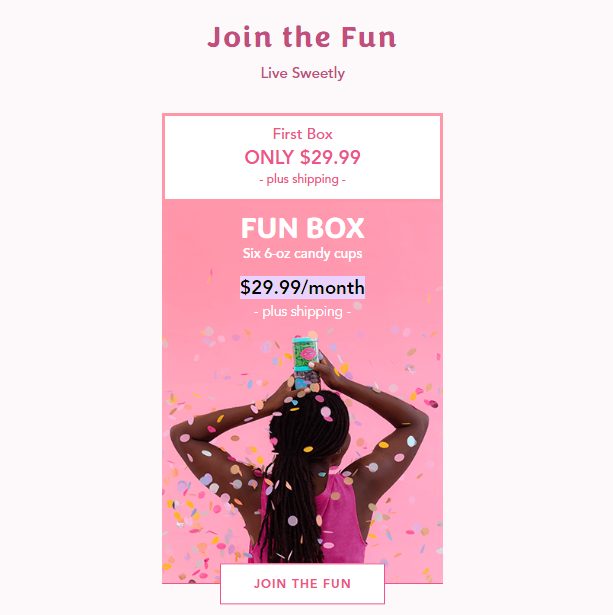
Tiered Pricing
Tiered pricing is extremely popular with subscription box services. With this pricing scheme, different versions of the box are created with different values.
For example, CatLadyBox has the CatLadyBox, which includes cat accessories, and the slightly more expensive CRAZY CatLadyBox, which also includes cat toys.
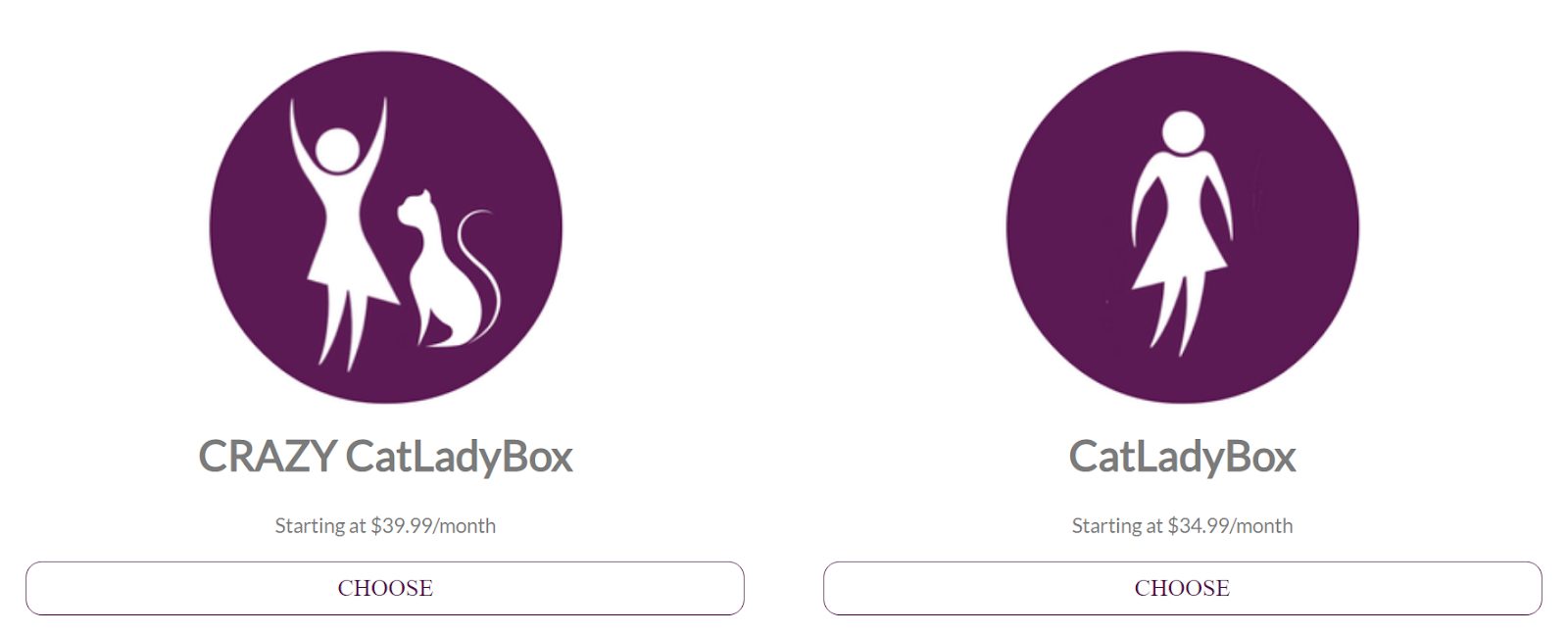
Pay-As-You-Go
Many subscription box companies let customers buy individual boxes with no subscription, this is called as pay-as-you-go pricing model . This is offered in addition to subscription plans and can be a good way to let customers try your product before committing to a subscription.
For example, KiwiCo lets customers shop for individual boxes on its website.
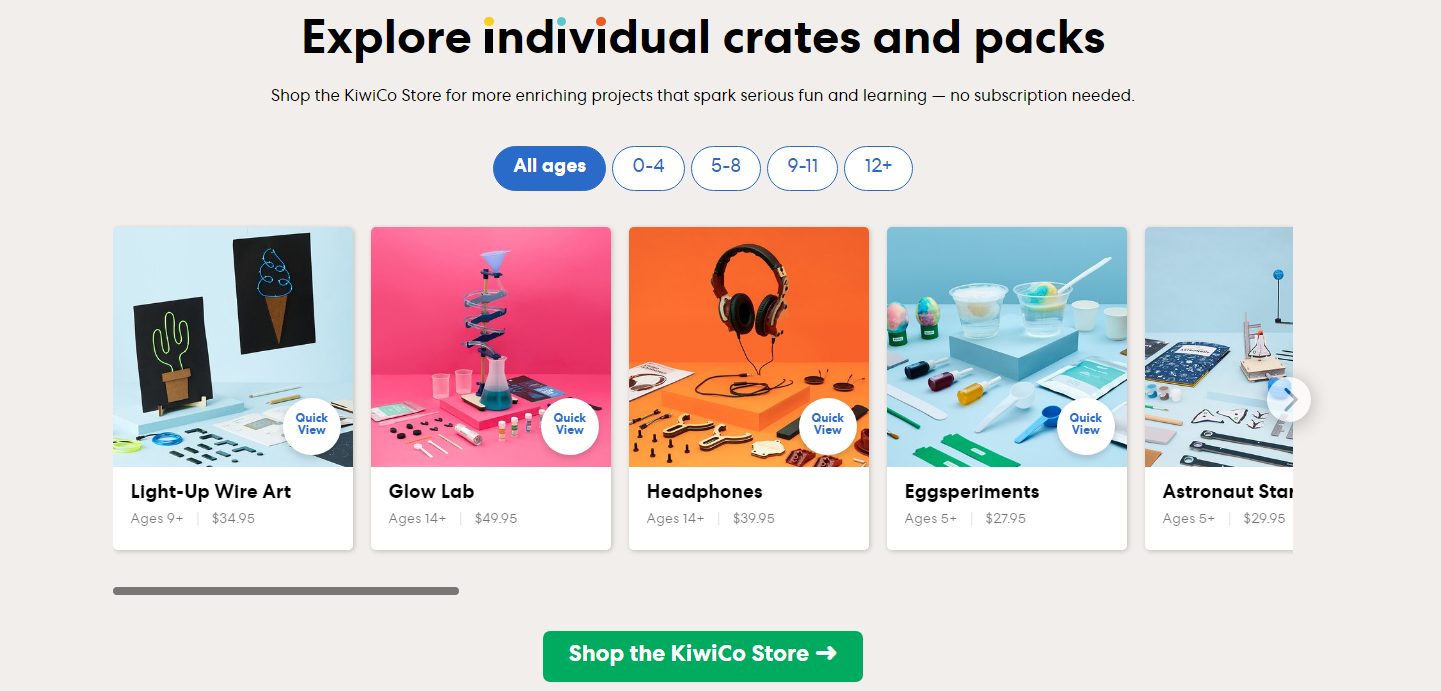
7. Create Your Financial Plan
The financial section of your business plan assures the reader that your subscription box will turn a profit.
Here’s what you need to include in this section:
- Sales forecast : Your annual revenue projections and cost of goods sold (COGS).
- Personnel plan : How much you plan to pay each of your employees.
- Break-even analysis : Determine when your business will break even and begin making a profit.
- Profit and loss statement : Your projected profits (or losses).
- Cash flow statement : How much cash you have, where it’s coming from, and when it’ll come.
- Balance sheet : A statement of your business’s assets, liabilities, and capital.
- Use of funds : Where investments will go and why.
The subscription box business model is more popular than ever, and your box could be the next big thing. But to achieve your idea’s full potential, you need a plan.
Use the subscription box business plan laid out by us to set goals and formulate your strategy. This plan will be valuable for internal stakeholders as well as investors and lenders. Looking for a way to manage billing for your products? Try Chargebee’s subscription box billing .
RELATED BLOGS

Haris is a renowned SaaS content expert specializing in subscription and B2B businesses. With a deep understanding of these industries, he provides invaluable insights and expertise. Stay ahead with Haris’s expertise in the ever-evolving world of SaaS and subscriptions.

Subscription Box Business plan
Written by Elma Steven | Updated on April, 2024

How to Write a Subscription Box Business Plan?
Subscription Box Business Plan is an outline of your overall subscription box business. The business plan should include a 5 year financial projection, marketing plan, industry analysis, organizational overview, operational overview and finally an executive summary. Remember to write your executive summary at the end as it is considered as a snapshot of the overall business plan. You need to be careful while writing the plan as you need to consider various factors that can impact the business’s success.
You can spend 3 to 4 weeks trying to write your own Business Plan by browsing through free online resources or hire a professional writer for $2,000. There is a better way to do this- Download our Subscription Box Business Plan to write a plan in just 2 days .
This depends on your expected revenue and cost. Also, we need to consider the startup cost. Find out the answer- Is Subscription Box Business Profitable?
Table of Contents
Executive summary, how to write an executive summary.
An executive summary should include four sections: an overview, a mission, a vision and an industry overview. The overview section should include details such as the business name, founder details and primary services and products. You can also include any USPs to highlight your competitive advantage. Click on this box to read the details of executive summary writing process. The executive summary should be written at the end and it should inspire the reader to go through the entire business plan.
An innovative Portland, Oregon-based subscription box business, EcoBox Delights promotes sustainability and eco-conscious living via its creative products. Our business, started by Emily Johnson, an avid environmentalist, delivers a curated assortment of premium, eco-friendly items to the homes of our customers every month.
Mission: Our goal is to level the playing field so that everyone may live sustainably. By showcasing eco-friendly items, EcoBox Delights hopes to encourage customers to live a greener lifestyle.
Vision: We see EcoBox Delights as a pioneer in the sustainable subscription box industry, celebrated for its dedication to fair trade, high-quality products, and the promotion of an eco-conscious client base.
Industry Overview:
The worldwide subscription box industry is booming, with a valuation of $25 billion in 2018 and an even more astounding $65 billion by 2027, a robust compound annual growth rate (CAGR) of 16.5%. Convenience, customization, and product discovery are the three pillars upon which this ever-changing industry rests.
Check out this guide on how to write an executive summary? If you don’t have the time to write on then you can use this custom Executive Summary Writer to save Hrs. of your precious time.
Financial Highlights
Earnings & profitability.

Break-Even Analysis

Business Description
Business Name: EcoBox Delights
Founders: Emily Johnson
Management Team: [You can ignore this/ delete this but its better to provide it]

Legal Structure: LLC
Location: Miami
Goals & Objectives:
- Establish a Diverse Subscriber Base: Aim to get subscribers from all walks of life, from specialized fans to casual shoppers, in the first year. The key is to break your customers down into their unique hobbies and preferences so you can personalize your boxes for each group.
- Enhance Brand Recognition: Establish a solid reputation for your subscription box brand. Get involved on social media, build relationships with influential people or related firms, and use focused marketing methods to boost your brand’s exposure.
- Consistently Deliver Quality Products: Make sure that every subscription box stays true to your brand’s concept and offers high-quality, one-of-a-kind goods. The foundation of trust and a devoted clientele rests on this constancy.
- Expand Product Range and Services: In the next two years, you should strive to expand your membership choices to include more themes or specialty boxes. Weigh the pros and cons of implementing limited edition boxes and supplementary services, such as individualized product recommendations.
- Achieve Financial Stability: In the first three years of operation, you should aim to establish a sustainable model that generates consistent revenue growth. Strategic pricing, effective cost management, and prudent financial planning are all necessary components of this.
- Create a Community Around Your Brand: Create an active community of subscribers by offering them opportunities to participate in activities like social media groups and special events. Client loyalty and word-of-mouth advertising may both benefit from this kind of community-building.
- Incorporate Technological Advancements : Stay updated with the latest in e-commerce and subscription management technologies to enhance user experience, from personalized subscription models to seamless order processing.
- Develop Strategic Partnerships: Your box offers and your network may both benefit from collaborations with local craftsmen, product suppliers, and other enterprises. Opportunities for co-marketing and cross-promotions might also arise via these collaborations.
- Gain Industry Recognition: Aim for industry accolades or features in prominent publications within five years. This recognition can significantly boost your brand’s credibility and market presence.
- Commit to Sustainability and Social Responsibility: Promote ethical sourcing procedures and use environmentally friendly packaging. Take part in community events or form collaborations with charities to show that your business cares about the world around.
Services:
- Curated Product Selections: Present boxes stocked with handpicked items that are designed to complement certain hobbies, interests, or ways of life. Make sure that subscribers have a one-of-a-kind and enjoyable experience with every box.
- Personalization Options: Make it possible for subscribers to tailor their boxes to their own tastes and requirements. Types of products, themes, or even package contents may be customized in this way.
- Flexible Subscription Plans: Make it simple for customers to cancel or switch plans by offering a variety of subscription plans (monthly, quarterly, or yearly) to meet their requirements.
- Exclusive Products and Collaborations: Incorporate limited-edition or exclusive goods into your boxes, or team up with other businesses or influencers to provide things that aren’t found anywhere else.
- Member-Only Perks: Offer additional benefits to subscribers, such as exclusive discounts, early access to new products, or members-only content like guides, tutorials, or webinars.
- Gift Subscription Options: Allow subscribers to purchase gift subscriptions, providing a unique gift option for friends and family for special occasions.
- Sustainable and Eco-Friendly Practices: Use eco-friendly packaging and source products from sustainable or ethical brands, aligning with environmentally conscious values.
- Interactive Community Engagement: Build an online community for subscribers to share experiences, provide feedback, and connect over shared interests related to the box themes.
- Seasonal and Special Edition Boxes: Offer seasonal or special edition boxes throughout the year, aligned with holidays, seasons, or special events.
- Customer Service Excellence: Guarantee complete client happiness, provide quick response times for support inquiries, and make it simple to manage subscriptions.
- Educational Content and Inserts: Put educational inserts or resources in the boxes to make unpacking more fun and useful, and make sure they tie to the concept of the box.
- Referral and Loyalty Programs: Implement referral incentives and loyalty rewards to encourage subscribers to spread the word and remain loyal to your service.
- Market Research and Feedback Loops: Regularly conduct market research and solicit subscriber feedback to continually improve the box contents and overall subscription experience.
- Custom Brand Collaborations: Collaborate with brands to create custom products that align with your box themes and add unique value for your subscribers.
Financial Overview
Startup cost, revenue & cost projection, profitability & cash flow projection, business model, tips on business model canvas.
The Business Model Canvas is a high-level overview of the business model. It can also be considered as the business model map in the overall plan. The important partners, key activities, value proposition and cost & revenue sections are only some of the nine vital components. A company idea’s complexities may be mapped out, analyzed and communicated with the use of the canvas. It shows the whole picture of a company’s value creation, delivery and capture processes. It helps new business owners hone their ideas, encourage creative thinking and make sound strategic decisions. It’s a helpful resource for coming up with ideas, organizing plans and presenting business models to key players. Check out the 100 samples of business model canvas.

Tips on SWOT Analysis
It offers a clear lens into a company’s strengths, weaknesses, opportunities and threats. This self-awareness enables effective resource allocation and strategic positioning against competitors. Businesses can mitigate risks, make informed decisions and set realistic goals. In addition, presenting a SWOT analysis in a business plan communicates to stakeholders that the company possesses a deep understanding of its market environment. In essence, SWOT ensures a business’s strategy is grounded in reality enhancing its chances of success. Check out the 100 SWOT Samples

Marketing Plan
How to write your marketing plan.
The marketing plan concisely focuses on customer engagement & competitive strategies, incorporating a marketing budget, promotional channels, brand management and a go-to-market approach. It requires understanding the target audience and competition, setting defined marketing goals and developing a strategy that blends these elements. This approach ensures efficient budget use, leverages appropriate channels for promotion, maintains brand integrity and executes a solid market entry strategy.
Promotional Channels
Social media marketing – $15,000 (30%).
- Platform Focus: Concentrate on platforms like Instagram, Facebook, and Pinterest, ideal for showcasing the visual appeal of your boxes. Share unboxing videos, customer reviews, and themed box previews.
- Paid Ads: Use targeted advertising to reach potential subscribers based on interests, demographics, and online behavior.
- Content Strategy: Regular posts featuring box contents, sneak peeks, subscriber stories, and occasional live Q&A sessions to engage the audience.
Website and SEO ($10,000 – 20%)
- Website Revamp: Ensure your website is visually engaging, easy to navigate, and effectively showcases the unique selling points of your subscription boxes.
- Blog Content: Regularly update a blog with posts related to the themes of your boxes, subscriber stories, and lifestyle tips to drive organic traffic.
- SEO: Optimize your website with relevant keywords associated with subscription boxes, your specific themes, and e-commerce best practices.
Email Marketing ($5,000 – 10%)
- Newsletter: Develop a regular newsletter featuring behind-the-scenes content, upcoming box themes, exclusive offers, and subscriber spotlights.
- Segmentation: Customize emails for different subscriber segments, such as new subscribers, long-term subscribers, and those who showed interest but haven’t subscribed yet.
Influencer Collaborations ($7,000 – 14%)
- Influencer Partnerships: Partner with influencers who align with your box themes for unboxings and reviews, reaching their followers.
- Giveaways and Promotions: Collaborate on giveaways and special promotions to create buzz and attract new subscribers.
Paid Online Advertising ($6,000 – 12%)
- Search and Display Ads: Invest in search engine and display ads to capture potential customers actively searching for subscription boxes.
- Retargeting Campaigns: Use retargeting ads to re-engage visitors who have visited your website but haven’t made a purchase.
Local Partnerships and Events ($4,000 – 8%)
- Local Market Collaborations: Partner with local markets or events to showcase your boxes and offer on-the-spot subscriptions.
- Pop-up Events: Organize pop-up events to create a physical presence, offering a tactile experience of your boxes.
Referral Program ($3,000 – 6%)
- Referral Incentives: Implement a referral program where current subscribers get benefits or discounts for referring new customers, encouraging word-of-mouth promotion.
Brand Management
Social media marketing.
- Brand Voice and Visual Identity:Develop a brand voice that is engaging, friendly, and aligns with the theme of your subscription boxes, whether it’s lifestyle, food, beauty, or another niche.
- Use a consistent visual style across all platforms that highlights the uniqueness and value of the products in your boxes. High-quality images and videos of the boxes and their contents are crucial.
User-Generated Content:
- Encourage subscribers to share their unboxing experiences on social media. User-generated content like unboxing videos and product reviews can significantly boost credibility and attract new subscribers.
Influencer Marketing:
- Collaborate with influencers who align with your brand to reach a wider audience. They can create unboxing videos, write reviews, or share photos using your products.
Search Engine Marketing (SEM) and SEO:
- Develop engaging ad copy highlighting special features like exclusive items, curated experiences, or personalized products.
- Optimize your website with relevant keywords related to your subscription box theme.
- Keep your Google My Business updated if you have a physical location or office.
Email Marketing:
- Regular newsletters can update subscribers on upcoming box themes, sneak peeks, special offers, and new product launches.
- Use segmentation to tailor content to different subscriber preferences or purchasing history.
Partnerships and Collaborations:
- Partner with brands or local businesses to include their products in your boxes, which can also expose your box to their customer base.
- Collaborate with non-profit organizations for special edition boxes, appealing to socially conscious consumers.
Content Marketing:
- Create blog posts and videos related to the themes of your boxes, offering additional value to your subscribers.
- Share behind-the-scenes content about how boxes are curated and packed, highlighting the care and thought put into each box.
Social Media Marketing:
- Regularly post on social media platforms where your target audience is most active. Use these platforms to tease upcoming boxes, announce new products, and engage with your community.
- Host giveaways and contests to increase engagement and visibility.
Offline Advertising:
- Participate in pop-up events, trade shows, or local markets to showcase your subscription boxes.
- Distribute flyers or discount codes in complementary local businesses or at events.
Referral Program:
- Offer incentives to subscribers who refer friends, like discounts on their next box or exclusive items.
Go To Market Strategy
Online presence and community engagement.
- Professional Website: Make a website that looks good and is easy to use. Make it simple for people to subscribe by showcasing the themes and contents of your boxes and including testimonials from satisfied customers.
- Content Marketing: Consistently release content that relates to your boxes’ topics, whether it’s lifestyle advice, product reviews, or industry news. You can establish your brand as an authority in your field and increase traffic from search engines with this material.
- Local Directory Listings: If you own a subscription box or target a certain market niche, it is essential that your company be included in appropriate web directories.
- Partnerships: Partner with like-minded businesses, bloggers, and influencers who can help spread the word about your box. Promotional possibilities and more awareness may be achieved via these collaborations.
Subscription Box Launch and Promotional Offers:
- Launch Event: Consider an online launch event, such as a live unboxing with an influencer or a virtual tour of your box’s contents. This can create buzz and attract early subscribers.
- Introductory Discounts: Offer special rates or bonus items for first-time subscribers. You could also create bundle deals for long-term subscriptions to encourage customer commitment.
Digital Marketing and Customer Relations:
- Social Media Campaigns: Showcase your boxes on social media sites like Instagram, Facebook, and Pinterest. Consistently provide interesting information, such as videos of forthcoming boxes being unpacked, customer testimonials, and previews of previous shipments.
- Email Marketing: Update your subscribers with news about upcoming box themes, unique material, and discount codes by email. Using segmentation, you may tailor communications to each subscriber’s unique tastes.
- Loyalty Program: Implement a rewards system where subscribers can earn points for referrals, long-term subscriptions, or social media shares.
Brand Awareness and Public Relations:
- Local Media Outreach: Reach out to local media and bloggers for features or reviews. Sharing unique stories about your box or its contents can garner media interest.
- Community Involvement: Engage with community events or charities that align with your box’s theme. This not only increases visibility but also enhances brand image.
- Influencer Partnerships: Partner with influencers who can authentically represent your box to their followers. This content can then be shared across your social media platforms.
Performance Tracking:
- Analytics and Feedback: Regularly monitor your marketing strategies’ effectiveness using tools like Google Analytics. Collect customer feedback through surveys or direct communication.
- Adaptation: Stay flexible and ready to adjust your strategies based on performance data and customer feedback, keeping up with market trends and subscriber preferences.
Organizational Overview
How to write your organizational overview.
Organizational overview provides a snapshot of how a company is structured and operates. It outlines the ownership structure, roles, responsibilities of key management personnel and the reporting hierarchy within the organization. This section offers stakeholders, investors and other readers a clear understanding of the company’s leadership and its chain of command. Additionally, it may give insight into the company’s culture, values and operational philosophy.
Emily Johnson’s inventive creativity and dedication to sustainable living are on full display in her expertly crafted EcoBox Delights, which she made in the environmentally aware city of Portland, Oregon. With a background in business and sustainability studies, Emily was driven to start EcoBox Delights by her love for environmental protection. She was able to create a subscription box business that promotes a greener lifestyle and delivers eco-friendly items because to her unique blend of knowledge and enthusiasm.
Sustainable living should not be difficult, boring, or out of reach; this is Emily’s goal with EcoBox Delights. Emily carefully selects an assortment of eco-friendly products, such as organic personal care items and eco-friendly household goods, to include in each monthly box. All of the items here come from reliable vendors and mom-and-pop shops that share our values of ethics and environmental responsibility.
In EcoBox Delights, Emily is committed to teaching her subscribers about sustainability and environmental challenges; her responsibility extends beyond product curation. Share your thoughts, ideas, and inspiration for making daily decisions that are more ecologically responsible with every box.
A standout quality under Emily’s leadership is the dedication to actively engaging with and receiving support from the community. By showcasing goods made and sold by local artists and small companies, EcoBox Delights helps to lessen the environmental impact of shipping and distribution while simultaneously strengthening local economies.
Another important part of Emily’s eco-friendly strategy is the packaging and shipment. In keeping with the company’s philosophy of minimizing waste and environmental effect, EcoBox Delights uses only recyclable, biodegradable, or reusable packaging materials.
Emily makes a name for herself in Portland’s eco-conscious circles outside of the subscription box as well. Hosts educational programs, partners with other eco-friendly enterprises, and is actively engaged in local sustainability projects to educate awareness and support sustainable living.
EcoBox Delights, run by Emily Johnson, is more than just a subscription service; it’s a reflection of her business savvy, her love of the environment, and her desire to bring together people who share her enthusiasm for making a difference.
Positions and Responsibilities
Chief executive officer (ceo):.
The expansion, long-term goals, and strategic trajectory of the company are all under your purview as CEO. Overseeing the whole organization, making high-level decisions, and representing the firm in professional transactions are all part of your job description.
Operations Manager:
Order processing, inventory management, and logistics are all part of the day-to-day activities that this position oversees. The timely assembly and shipment of the subscription boxes is guaranteed by the Operations Manager.
Product Curator/Manager:
Choosing the contents of each subscription box is your responsibility. They make sure there’s a high-quality, consistent assortment of goods that fits the brand and what customers want by researching and sourcing them, negotiating with suppliers, and so on.
Customer Service Manager:
Manages customer interactions, addressing inquiries and concerns, handling subscription changes, and ensuring a high level of customer satisfaction.
Marketing and Promotions Manager:
Plans and executes advertising campaigns to bring in new subscribers and keep the ones they already have. Advertising, social media, email, and collaboration possibilities are all within their purview.
Content Creator/Social Media Coordinator:
Creates engaging content for social media, blogs, and newsletters. This role is key for building a community around the brand and enhancing customer engagement.
Financial Controller:
Manages the company’s money matters, including accounting, budgeting, and financial reporting. They need to keep an eye on the company’s finances and make sure everything is in order.
Data Analyst:
Determines consumer tastes and habits by analyzing subscription data and customer records. Using this data, product selection and marketing tactics may be more informed selections.
IT/Web Manager:
Manages the technical aspects of the business, including the website and subscription management system. They ensure that the online platform is user-friendly, secure, and efficient.
Logistics Coordinator:
Handles the logistics of box assembly and shipping, managing relationships with shipping and logistics providers to ensure timely and cost-effective delivery.
Human Resources Specialist:
Manages staffing needs, including hiring, onboarding, and employee relations. They ensure that the business has the right talent to grow and succeed.
Legal and Compliance Officer:
Ensures that the business complies with all legal and regulatory requirements, particularly in areas like consumer protection, data privacy, and contracts with suppliers and partners.
Operational Overview
Curated subscription boxes:.
- Monthly themed boxes containing a selection of products tailored to specific interests such as beauty, wellness, gourmet foods, books, or hobbies.
- Personalization options based on subscriber preferences and feedback.
Special Edition Boxes:
- Limited edition boxes released for special occasions or holidays, featuring exclusive items or collaborations with brands.
- Option for one-time purchase without needing a regular subscription.
Customizable Boxes:
- Allow subscribers to build their own boxes by choosing from a range of products.
- Options to select the number of items or set a price range.
Gift Subscriptions:
- Special gift packages for various occasions like birthdays, anniversaries, or holidays.
- Include a personalized message and gift wrapping options.
Corporate/Bulk Orders:
- Tailored solutions for corporate gifting or bulk orders for events and occasions.
- Custom branding and packaging options to align with corporate identity.
Eco-Friendly and Sustainable Options:
- A line of boxes focusing on sustainability, featuring eco-friendly and ethically sourced products.
- Use of recyclable or biodegradable packaging materials.
Kids and Family Boxes:
- Boxes designed for children or families, containing age-appropriate products, educational items, or family activities.
- Options for different age groups and family sizes.
International Specialty Boxes:
- Boxes featuring products from different countries or cultures, offering an international experience.
- Focus on traditional, artisanal, or unique items from around the globe.
Health and Wellness Boxes:
- Boxes centered around health and wellness, including fitness products, healthy snacks, and wellness guides.
- Collaboration with health and wellness experts for curated content.
Subscription Add-Ons:
- Additional services or products that subscribers can add to their monthly box, such as premium items, extra products, or exclusive content.
Online Community Access:
- Exclusive access to an online community for subscribers, offering additional content, forums, and special events.
Subscriber Loyalty Program:
- A rewards program for long-term subscribers, offering discounts, early access to new boxes, or exclusive products.
Industry Analysis
Tips on industry analysis.
The industry analysis section offers a detailed exploration of the market environment. It identifies current challenges and potential opportunities within the industry, segments the target market to pinpoint specific consumer demographics, assesses the market’s overall size for growth potential and examines influential industry forces. This thorough analysis is essential for developing strategic business approaches, aligning objectives with market trends and positioning the company for competitive success.
The global subscription box industry is witnessing explosive growth, expected to reach $65 billion by 2027, fueled by a remarkable 18.3% CAGR from 2022. This rapid expansion is driven by several key factors
Source: businessresearchinsights
With a projected valuation of $65 billion by 2027, the worldwide subscription box market is booming. Curated product delivery, which are tailored to individual interests and requirements, are driving this trend because of how convenient and personalized they are. The growth of this sector is being propelled by changes in consumer tastes towards more customized experiences, a wider variety of items, and the proliferation of online shopping and social media. New technological developments are adding to this trend with features including enhanced user experiences, dynamic pricing, and tailored suggestions. There is a wide variety of choices available to meet the demands of the industry’s three primary segments: replenishment, curation, and access subscriptions. Key themes impacting the future include collaborations and partnerships, sustainability, experiential subscriptions, and personalization. Acquisition and retention of customers, operational efficiency, competitiveness, and regulatory compliance are some of the remaining issues. Subscription box businesses may succeed in this ever-changing industry by meeting these problems head-on and jumping on the trend bandwagon, all while providing customers with sustainable, customized goods and using technology to improve their experience.
Other key trends and stats:
- Personalization: Companies are increasingly leveraging data and customer preferences to personalize box contents, offering unique and relevant experiences for each subscriber.
- Sustainability: Consumers are seeking eco-friendly options, leading to the rise of subscription boxes with sustainable packaging, ethical sourcing, and carbon-neutral practices.
- Experiential Subscriptions: Subscriptions are evolving beyond products to offer access to unique experiences and activities, fostering brand loyalty and engagement.
- Collaborations and Partnerships: Companies are partnering with influencers, brands, and other businesses to expand their reach, offer exclusive products, and cater to niche interests.
Source: thebusinessresearchcompany
Industry Problems
- Customer Acquisition and Retention:Solution: Attract the correct audience with the use of customized marketing methods. Boost client retention by attentive service, high-quality goods, and tailored experiences.
- Managing Inventory and Supply Chain: The solution is to create effective mechanisms for managing inventories. Ensure dependable procurement by cultivating strong connections with suppliers and negotiating advantageous terms.
- Diverse and Appealing Product Curation: The answer is to keep an eye on what consumers want and how the market is evolving. To meet the needs of a wide range of customers, provide a selection of boxes or personalization choices.
- Cost Management and Pricing Strategy: The solution is to find the sweet spot between profitability and competitiveness in pricing. Try buying in bulk or haggling with shipping companies to get a better deal on shipping and handling.
- Effective Marketing and Branding: A solid brand identity should be established. To promote your boxes and engage your audience, use social media, influencer collaborations, and email marketing.
- Customer Experience and Engagement: Our solution is to streamline the unpacking process and actively involve our consumers via various online channels like as social media, newsletters, and community forums. Ask for and consider client input.
- Logistics and Shipping Challenges: The solution is to enhance the reliability of delivery while simplifying the fulfillment operations. Make tracking options available and resolve delivery difficulties efficiently.
- Sustainability and Eco-Friendliness: Sustainability and environmental friendliness are key, therefore make use of recyclables and only buy from companies you can trust.
- Adapting to Market Changes and Trends: Keep an open mind and be quick to adapt to shifting customer tastes and preferences. Substantially change up the contents and concepts of the boxes to keep people interested.
- Data Analysis and Customer Insights: The solution is to learn about consumer tastes and habits using data analytics. To increase happiness, modify your services according to these findings.
- International Expansion and Localization: The solution is to think about cultural preferences, local shipping rules, and customs while growing internationally. Target foreign consumers with locally relevant marketing and product recommendations.
- Building a Community Around the Brand: The answer is to provide opportunities for members to connect with one another, such as user-generated content, special events, or online platforms.
Industry Opportunities
- Flexible Subscription Models: Create a range of subscription plans to meet the needs of customers with varying budgets and tastes. Plan choices include monthly, quarterly, or yearly payments, as well as one-time purchases and gift subscriptions.
- Efficient Online Platform and Scheduling :Create a subscription management software that is simple to use online. Make it easy for users to manage their subscriptions by adding options to stop, cancel, or change them. Timely deliveries are guaranteed by efficient management of inventory and delivery schedules.
- Curated and High-Quality Product Selection: Keep looking for one-of-a-kind, high-quality products to include in your boxes. Always be aware of what your customers want and what’s happening in the industry so you can maintain your products interesting and relevant.
- Diverse and Skilled Team :Put together a staff that excels in a variety of areas, such as marketing, customer support, and product curation. To keep up with the latest trends and provide consistent high-quality service, it is important to provide continuous training.
- Creating an Engaging Customer Experience: Create an exciting and unforgettable unpacking experience by designing your packaging. Improving the customer experience may be achieved by adding customized touches, appealing packaging, and branded goods.
- Robust Communication Channels: Keep in constant, fruitful contact with subscribers. Stay in touch with your subscribers and keep them engaged via customer care channels, social media, and email.
- Comprehensive Range of Services: Offer a variety of box types to cater to different interests and needs, such as themed boxes, limited edition collections, or customizable options.
- Accessible and Convenient Services: Make sure your subscription service has a simple and straightforward web interface. For clients who would rather use their mobile devices, think about mobile optimization.
- Secure and Privacy-Focused Operations :Implement strong privacy and security measures to protect customer data. Be transparent about your use of data and adhere to privacy regulations.
- Tailored Services and Personalization: Provide individualized subscription boxes according to subscriber preferences. Customize items and enhance customization by using client data and feedback.
Target Market Segmentation
Geographic segmentation:.
- Local Residents: Focus on families living in close proximity to the nursing home who are seeking convenient care options for their elderly relatives.
- Specific Areas with Aging Populations: Target regions or neighborhoods with a higher percentage of seniors, where there might be a greater demand for nursing home services.
Demographic Segmentation:
- Age Groups: Differentiate services for younger seniors who may be more independent versus older seniors who may require more comprehensive care.
- Income Levels: Offer a range of options from basic elder care services to more luxurious accommodations and amenities for higher-income clients.
Psychographic Segmentation:
- Health-Conscious Seniors: Focus on residents who are particularly interested in wellness and fitness programs.
- Socially Active Seniors: Offer a vibrant community environment with a variety of social activities, events, and communal spaces.
Behavioral Segmentation:
- Long-term Residents: Tailor services for residents who plan to stay for an extended period, focusing on comfort, ongoing health care, and community building.
- Short-term or Respite Care Clients: Offer specialized programs for short-term stays, catering to seniors recovering from surgery or giving relief to family caregivers.
Needs-Based Segmentation:
- Residents with Specific Health Conditions: Provide specialized care for residents with conditions like dementia, Alzheimer’s, or mobility issues.
- Independent Living vs. Assisted Living Needs: Segment services based on the level of care and independence each resident requires.
Cultural and Ethnic Segmentation:
- Culturally Specific Care: Offer services, meals, and activities tailored to specific cultural or ethnic groups, ensuring a sense of familiarity and comfort for residents.
Technological Segmentation:
- Tech-Savvy Seniors: Integrate technology-based solutions for entertainment, communication, and health monitoring for residents comfortable with technology.
- Traditional Service Preference: Maintain traditional care and communication methods for residents who prefer a more conventional approach.
Market Size
- Total Addressable Market (TAM) for Subscription Box Business: The total addressable market (TAM) is the sum of all possible subscription box service users in a certain area or worldwide. Anyone or everything that could be considering a subscription service for product delivery falls under this category. The amount of the TAM may be affected by factors such as the current state of online shopping, customer purchasing patterns, and the increasing popularity of home delivery services. The total addressable market (TAM) for subscription box services might grow in response to rising e-commerce and a trend towards customized goods.
- Serviceable Addressable Market (SAM) for Subscription Box Business: Within the TAM, SAM is a more narrowly defined market segment that your subscription box company may reasonably aim to reach and satisfy. A number of variables come into play here, including your geographic reach, your target demographics, and the nature of your items (e.g., books, gourmet foods, or beauty supplies). The SAM of a company that caters to those who are passionate about beauty products would vary from that of a company whose subscription boxes are filled with gourmet foods. Gaining insight into your SAM allows you to customize your offers and marketing techniques to resonate with your target audience.
- Serviceable Obtainable Market (SOM) for Subscription Box Business: The SOM represents the share of the SAM that your company has a reasonable chance of capturing. It is the percentage of the market that you can expect to capture with your existing strategy, advertising, name recognition, and level of competition. Your SOM is highly dependent on factors like customer happiness, product originality, price strategy, and marketing efficacy. In terms of subscribers and income, this statistic gives you a more reasonable goal for your company, so you may concentrate your strategy on gaining a larger proportion of the most lucrative and appropriate market sectors.
Industry Forces
Demand in the Market and Current Customer Preferences: Subscription box companies are doing really well right now. It is critical to know what items or topics are popular so that boxes may be tailored to fit their interests. Some examples of popular themes include health, gourmet cuisine, beauty, and hobbies. Another factor that might drive expansion is the growing need for more convenient and tailored shopping experiences.
Numerous organizations provide a wide range of themes and items in the subscription box industry, making it very competitive. Attracting and retaining members may be achieved by differentiating your boxes by greater quality, customisation choices, unique goods, or specialized targeting.
Recent Technological Developments: The most important thing is to use technology to make the subscription process easy, handle orders efficiently, and provide customers with individualized experiences. Efficient logistics and stock management systems, as well as data analytics for customized products, are all part of this.
The regulatory landscape necessitates adherence to rules governing online sales, shipping, and sales tax, particularly when engaging with clients from other countries. Also, be sure you follow all health and safety regulations if your parcels include food, cosmetics, or health items.
Subscription services are susceptible to changes in disposable income and consumer spending patterns brought about by macroeconomic factors. Subscription services that are considered luxuries or not absolutely necessary may see a decrease in demand while the economy is in a slump.
Dynamics with Suppliers: The assortment, price, and quality of the items in the boxes are highly dependent on the suppliers. The capacity to properly manage inventory, keep up with product trends and availability, and cultivate strong connections with dependable suppliers is crucial.
Expectations and Preferences of Customers: It is critical to comprehend subscriber preferences about personalization, product variety, and delivery frequency. Customer happiness and loyalty may be enhanced by adapting to evolving consumer expectations and providing subscription terms with some leeway.
Consumers are becoming more conscious of the importance of sustainability and ethical practices. Sustainable or ethical product sourcing, eco-friendly packaging, and promotion of these methods might draw in customers who are more concerned about these issues.
Strong branding and efficient marketing methods are of the utmost importance. To draw in buyers, highlight the boxes’ distinctive features via content marketing, influencer collaborations, and social media.
Engaging with subscribers via feedback and community building, providing outstanding customer service, and having a strong online presence may increase customer loyalty and word-of-mouth recommendations.
Tips on Financial Modeling & Analysis
It includes essential elements such as an Investment and Capital Expenditure Summary that details the necessary funds, a Revenue Summary that estimates profits, a Cost of Goods Sold (COGS) Summary that details the expenses of manufacturing or services and an Operating Expenses (OpEx) Summary that presents the costs of everyday operations. An Income Statement that shows how profitable the business is, a Cash Flow Statement that shows how liquid the funds are and a Balance Sheet that shows the overall financial health of the organization round out the part. For stakeholders to make educated decisions it is crucial to have a comprehensive picture of the company’s financial health and development possibilities.
Investment & Capital Expenditure

Revenue Summary

Cost of Goods Sold Summary

OpEX Summary

Income Statement

Cash Flow Statement

Balance Sheet

Download Business Plan
Just Fill Up & Print
- Start free trial
START YOUR BUSINESS WITH SHOPIFY
Whatever type of business you start, Shopify has the tools to help you sell, ship, and grow.

Subscription Business Model: Benefits, Types, and Tips for 2024
A subscription business model allows companies to scale with predictable revenue while offering a more personalized customer experience.

The subscription ecommerce market is projected to reach over $450 billion by 2025—making it a big opportunity for existing and aspiring business owners.
In this article, you'll learn how to utilize the subscription business model in a new or existing ecommerce business and discover the pros and cons of various subscription business models .
Table of contents
What is the subscription business model?
Benefits of a subscription business model, types of subscription business model, tips for making the subscription business model work for you, how to start your own subscription business, subscription business model faq.
The subscription business model is a strategic revenue-generation approach where customers pay a recurring price at regular intervals to access a product or service.
In ecommerce, subscription models are used by sellers offering everything from physical goods such as groceries or beauty products to digital services like streaming media or software. By providing ongoing value, subscriptions help build a long-term customer relationship, encourage repeat sales and enable businesses to forecast revenue more effectively.
More predictable revenue
More cash on hand.
- Less spent on customer acquisition
Improved customer loyalty
Easier upselling and cross-selling.
Knowing how much money is coming in every month helps you streamline everything from sales forecasting to inventory planning. It also means you know how much you can reinvest into the growth of your business.
Many subscription businesses ask for full payment upfront, at a discounted price. Besides being great for cash flow, this buffer can provide startups with much-needed peace of mind.
Less spent on customer acquisition
Businesses with a pay-per-product pricing model have to constantly invest in marketing and sales in order to attract new customers and thereby increase revenue. Increasing customer acquisition costs is a leading source of startup failure. With a subscription-based model, customers make payments to you on a regular basis, so you don’t have to invest as much in new customers to keep your business going.
Acquiring a new customer can cost 5–10 times more than retaining an existing customer.
The recurring nature of subscriptions creates a virtuous cycle: regular purchases offer deeper insights into your customers’ behavior, which allows you to continually improve the personalized experience you offer and, in turn, keeps customers coming back.
If done well, subscription businesses create extremely loyal, repeat customers—and repeat customers spend 67% more than new customers . This is the premise of customer lifetime value , and one of the most important factors in determining a business’ success.
With a subscription model, you’re uniquely positioned to make more revenue from existing customers. Because you have continuous contact with your customers, you’re building a trusting relationship with them. This makes it easier to market additional products or services to them , because they already know you provide a valuable service.
Launching a subscription business can be extremely lucrative–if done right. The first step is choosing the subscription model that best suits your business.
There are three overarching types of subscriptions: curation, replenishment, and access. They all have their perks and drawbacks, so identifying the best fit for you will come down to the types of physical and digital products you’re selling, your capacity, and your unique business ideas and goals.
Curation business model (i.e. subscription boxes)
This is the most common subscription business model, popularized by companies like Birchbox, Blue Apron, and Stitch Fix. These are your subscription box businesses , which seek to surprise and delight customers by providing them with new items and highly personalized experiences.
Typically, these businesses sell products in the apparel, beauty, and food categories, but the model works well across a wide range of products and is expanding into more industries every year.
✅ Benefits
- High profit potential. Subscription boxes can be very lucrative—in fact, the growth of and share in the subscription market is fueled by a few curator brands. Considered a “splurge” by most standards, subscription boxes cost anywhere from $15 to $100 a month and promote the discovery of new products. Compounded monthly, this profit model can scale quickly compared to other food business ideas .
- High churn. Novelty drives initial enthusiasm for these businesses, so this model can experience higher rates of customer churn. Plus, since these products are typically niche non-essentials, subscription box businesses thrive when the economy is doing well, but are the first to go during a recession.
- Operational complexity. Not only is acquiring customers more expensive in the subscription box space, these businesses also have considerably higher operating costs, including packaging, branding, and regular shipping.
Replenishment business model
This model is all about convenience and cost savings. Replenishment subscriptions allow consumers to automate the purchase of essential items—often at a discount.
Most products don’t need to be replenished regularly, so the types of products that you’re selling are an important consideration with this business model. Commodity and convenience items like razors, diapers, vitamins, and pet food are good fits for the replenishment model.
- Higher conversion rates. 65% of customers who consider a replenishment service subscribe, which is significantly higher compared to the other models (50%).
- Higher retention rates. Due to the nature of the products that these businesses sell, the replenishment model has particularly high long-term subscription rates: 45% of members have subscribed for at least one year.
Replenishment services have particularly high long-term subscription rates: 45% of members have subscribed for at least one year.
- Thin margins. In many instances, this business model requires companies to compete on price and offer generous discounts. This means businesses need to keep their costs very low and operate at scale in order to realize profits (in other words, sell a lot of products).
Access business model
Access subscribers pay a monthly fee to obtain lower prices or members-only perks. JustFab, NatureBox, and Thrive Market are all examples of access subscription businesses, and their primary value is offering exclusivity to customers.
- Greater value to the customer. Because customers are paying for exclusive access to perks, there is an opportunity to provide personalized offers that will help deepen your relationship with the customer. That value can be further stretched by creating a community of members, where they can interact through forums or Facebook groups.
- Bundling opportunities. Opportunity to offer customers an array of products (and non-tangibles like discounts for future purchases) as part of a single membership.
- Greater time investment . Because access requires not a single service or product you can add on to checkout, you do need to put in work to make sure your membership offering is robust enough and maintained regularly in order for it to be of value to your customer.
Bonus: Add-on subscription business model
OK, this isn’t a business model, but it’s a hybrid approach that allows you to add subscription services to your existing business. More and more companies are shifting toward this revenue model, as it’s a flexible way of exploring the subscription ecosystem without committing to one revenue model (or pivoting your business).
Across the board, churn is the biggest risk for subscription businesses. The good news is that subscription consumers can be extremely sticky once they find a service they like. Here are some tips to curb churn rates and run a profitable subscription business:
1. Evaluate your product viability
The first step in any business is evaluating your product/market fit and your product viability . In the subscription space particularly, some product categories are oversaturated, making it considerably more challenging to enter the market.
For example, the meal-kit category has extremely high rates of cancellation within the first six months, reflecting competitive pricing and broad similarities among the leading players. Do your research to ensure there’s a need for your product in the market and keep tabs on your competitors .
2. Be clear about your business goals
Is it a revenue number, customer acquisition, or number of units sold? Whatever your business goals are, you need to keep them top-of-mind—especially when choosing your business model.
3. Be conservative about pricing at the beginning
Many subscription consumers who churn do so quickly, so you shouldn’t over invest in free trials or heavy discounts unless they have a clear payback. Plus, pricing should always be tested, adapted, and evaluated as your company evolves.
4. Invest in personalization
For all the business models, but especially the curation model, customers expect personalized subscriptions to become even more tailored over time. 28% of curation subscribers said a personalized experience was the most important reason to continue to subscribe.
Do you have the in-house data expertise or technical stack to scale personalization efforts? If not, do you have the budget to invest in it?
5. Prioritize retention strategies
In the early stages, you have to prioritize acquisition in order to get sales. But once you’ve got the ball rolling, it’s time to switch up tactics and focus on customer retention strategies .
Remember: It costs more to acquire a customer than it does to retain one, and you can always draw more value from a loyal customer base. Most subscription companies put all their efforts into acquiring new customers, but that’s not the most effective way to grow a business.

6. Diversify marketing channels and tactics
Subscription business models use different channels to attract new customers and engage with existing subscribers. If you’re just starting out, influencer marketing can help you gain social clout.
And since subscription-based businesses depend on a frequent and meaningful engagement of customers, email is a critical tool for all business models. Keep in mind that each subscription business model has its “marketing match." For example, for the curation model, affiliate marketing is the top acquisition channel. Recurring packages then offer a built-in marketing surface to engage with those customers.
7. Monitor churn
It goes without saying that you should be monitoring and analyzing voluntary churn—customers cancelling their subscription—in order to continually improve your service.
8. But what about involuntary churn?
Expired, lost, or stolen credit cards; address changes; and network errors all contribute to involuntary churn over the course of a subscription customer’s lifecycle.
According to Profitwell, involuntary churn makes up 20–40% of overall churn, so actively staying on top of these common causes can make a big difference to your bottom line.
Subscription business models can be added onto an existing business or used as the basis for a new business. If you’re interested in starting up your own subscription business, we have an easy five-step guide for you.
1. Choose your subscription idea
The first step is deciding what type of subscription model your business will use and what product(s) you’ll offer.
If you currently have a successful clothing brand, adopting a subscription model can be a great way to bring in guaranteed revenue each month. On the other hand, you may simply have a great idea for a subscription box theme that you want to start from scratch.
Regardless, your first step needs to revolve around coming up with your subscription idea and outlining what this might look like in action.
One popular subscription business, FabFitFun , sends seasonal boxes with 6-8 full-size products that are perfect for each season—like beach-going goodies for summer and dry skin products for winter.

2. Select your subscription products
Pick the types of products you want your subscription business to offer each month. This is also the point where you may want to start reaching out to brands to create partnerships so that you can offer their products in your monthly subscription at a lower cost to your business.
This is also the time to build a “prototype box” or sample subscription so that new subscribers can get an idea of the types of products they’ll be receiving each month. This doesn’t have to be completely accurate yet; just make sure the products you start lining up for marketing photos match the same types of products you’ll actually be sending.
3. Price your subscription options
Once you know what types of products you’ll be offering and how much your new subscription service will be able to purchase them for, you can start pricing out your subscription. Depending on your offerings, there may even be different subscription levels.
For example, the Variety Fun snack subscription box has two different options: a “Regular Snacks” that’s cheaper and has more classic snacks and a “Healthy Snacks” that focuses on healthy snack options.
However, you might also offer different prices based on how far in advance your subscriber commits to. A one-year subscription would have a lower monthly cost than a month-to-month subscription.
You’ll need to price your subscription box at a point that is appealing to your target customer but also ensures your business makes a profit. It won’t be feasible for your business to spend $25/box while charging only $20/box.
4. Start your online store
Once you know what type of subscription you’ll be offering and how you’ll price it, it’s time to start your online store . Here, you’ll share photos of sample products, allow customers to sign up for their next box, and share information about the products they receive each month.
And you can easily create your subscription business website with Shopify. Whether it’s adding an option for recurring orders to your existing business or creating subscription boxes from scratch, Shopify makes launching a subscription business easy either through own Shopify Subscription app or third-party alternatives.
Boost recurring revenue with Shopify Subscriptions
Increase your customers’ lifetime value by offering subscriptions. Get started with the free Shopify Subscriptions app.
Add a subscriptions app
You can easily create a subscription offering by installing any of the following subscription management apps:
- Shopify Subscriptions . Easily setup and manage subscriptions within Shopify admin with the free Shopify Subscriptions app
- PayWhirl Recurring Payments . Create, manage, and sell subscriptions through our native platform.
- Awtomatic Subscriptions . The Awtomatic app (Previously Bundle Subscriptions) empowers you to easily add subscription options to your products and is fully integrated with Shopify’s native checkout.
- Assemble Subscriptions . Built by a team of Shopify experts with almost a decade of experience across the platform, this is no ordinary subscriptions app.
- Bold Subscriptions. Built with enterprise companies in mind, Bold lets you customize, manage, and scale a subscription business.
- Recharge Subscriptions . Quickly launch and manage subscriptions for your Shopify store.
- Native Subscriptions . Powering subscriptions payments, seamless checkouts, and recurring orders.
- Seal Subscriptions . Boost sales with subscriptions and automatic recurring payments.
- Appstle Subscriptions . A comprehensive subscription solution that enables you to offer products and services to your customers, on a recurring basis.
For more options, check out Shopify’s subscription app collection to find an app that fits your business.
5. Market your new subscription business
Now that your new subscription business is ready to sell, you have to put it in front of your target customers and start getting signups. Marketing any business is key to success, but it can seem daunting when faced with an empty slate.
Here are a few key tips for marketing a brand new business:
- Create and brand all of your social media platforms
- Take tons of product photos so you have creative assets to promote
- Start building an email list and send regular newsletters
- Set aside a small ad budget that you can use to start building awareness
- Reach out to micro-influencers who you may be able to partner with for a smaller fee
- Write and publish press releases about your new product
- Network in online communities to further increase awareness
- Run contests and giveaways to get more people interested in your product
While it may feel like things are going slowly at first, business growth is exponential. You just have to put in the effort and be patient while you grow your subscription business.
Build your own custom subscription solution
Shopify's tooling enables partners and developers to also build new subscription experiences directly within Shopify Checkout. For the first time, developers can now build on Shopify Checkout, meaning merchants no longer have to choose between selling subscription products and using Shopify’s checkout.
Merchants no longer have to choose between selling subscription products and using Shopify’s checkout.
Moving forward, you don’t have to manage multiple checkout experiences, and your customers can enjoy the same friction-free checkout experience, regardless of whether they’re purchasing a one-time or recurring product.
The following resources are available to you today:
- The Shopify Subscription APIs and Product Subscription Extension .
- Check out our detailed developer documentation and our developer guide on migrating existing subscription contracts to Shopify .
This is the first step toward improving checkout extensibility so developers can help customize our checkout to meet more merchant needs. Visit our Partner Blog for more information about how to apply for access to the Subscriptions API.
- How To Source Products To Sell Online
- 25 Best Ways to Make Money From Home in 2024
- The 13 Best Dropshipping Suppliers in 2024
- How to Start a Dropshipping Business- A Complete Playbook for 2024
- The Ultimate Guide To Dropshipping (2024)
- What To Sell on Shopify: Top 12 Things To Sell (2024)
- Sell Coffee Online- How to Launch a Café
- What Is Affiliate Marketing and How to Get Started
- Making Spirits Bright- Inside the Workshops of 7 Christmas Store Owners
- 17 Unique Business Ideas for You To Try This Year
What is an example of subscription model?
Is a subscription business profitable, how does a subscription business make money.
Keep up with the latest from Shopify
Get free ecommerce tips, inspiration, and resources delivered directly to your inbox.
By entering your email, you agree to receive marketing emails from Shopify.
popular posts

The point of sale for every sale.

Subscribe to our blog and get free ecommerce tips, inspiration, and resources delivered directly to your inbox.
Unsubscribe anytime. By entering your email, you agree to receive marketing emails from Shopify.
Latest from Shopify
Aug 16, 2024
Learn on the go. Try Shopify for free, and explore all the tools you need to start, run, and grow your business.
Try Shopify for free, no credit card required.

How to Start a Subscription Box Business

Starting a subscription box business can be very profitable. With proper planning, execution and hard work, you can enjoy great success. Below you will learn the keys to launching a successful subscription box business.
Importantly, a critical step in starting a subscription box business is to complete your business plan. To help you out, you should download Growthink’s Ultimate Business Plan Template here .
Download our Ultimate Business Plan Template here
14 Steps To Start a Subscription Box Business :
- Choose the Name for Your Subscription Box Business
- Develop Your Subscription Box Business Plan
- Choose the Legal Structure for Your Subscription Box Business
- Secure Startup Funding for Your Subscription Box Business (If Needed)
- Secure a Location for Your Business
- Register Your Subscription Box Business with the IRS
- Open a Business Bank Account
- Get a Business Credit Card
- Get the Required Business Licenses and Permits
- Get Business Insurance for Your Subscription Box Business
- Buy or Lease the Right Subscription Box Business Equipment
- Develop Your Subscription Box Business Marketing Materials
- Purchase and Setup the Software Needed to Run Your Subscription Box Business
- Open for Business
1. Choose the Name for Your Subscription Box Business
The first step to starting a subscription box business is to choose your business’ name.
This is a very important choice since your company name is your brand and will last for the lifetime of your business. Ideally you choose a name that is meaningful and memorable. Here are some tips for choosing a name for your subscription box business:
- Make sure the name is available . Check your desired name against trademark databases and your state’s list of registered business names to see if it’s available. Also check to see if a suitable domain name is available.
- Keep it simple . The best names are usually ones that are easy to remember, pronounce and spell.
- Think about marketing . Come up with a name that reflects the desired brand and/or focus of your new business.
2. Develop Your Subscription Box Business Plan
One of the most important steps in starting a subscription box business is to develop your subscription box business plan . The process of creating your plan ensures that you fully understand the subscription box market and your business strategy. The plan also provides you with a roadmap to follow and if needed, to present to funding sources to raise capital for your business.
Your business plan should include the following sections:
- Executive Summary – this section should summarize your entire business plan so readers can quickly understand the key details of your subscription box business.
- Company Overview – this section tells the reader about the history of your subscription box business and what type of subscription box business you operate. For example, are you a monthly subscription box, quarterly subscription box, or a customized subscription box?
- Industry Analysis – here you will document key information about the subscription box industry. Conduct market research and document how big the industry is and what trends are affecting it.
- Customer Analysis – in this section, you will document who your ideal or target market are and their demographics. For example, how old are they? Where do they live? What do they find important when purchasing products like the ones you will offer?
- Competitive Analysis – here you will document the key direct and indirect competitors you will face and how you will build competitive advantage.
- Marketing Plan – your marketing plan should address the 4Ps: Product, Price, Promotions and Place.
- Product : Determine and document what products/services you will offer
- Prices : Document the prices of your products/services
- Place : Where will your business be located and how will that location help you increase sales?
- Promotions : What promotional methods will you use to attract customers to your subscription box business? For example, you might decide to use pay-per-click advertising, public relations, search engine optimization and/or social media marketing.
- Operations Plan – here you will determine the key processes you will need to run your day-to-day operations. You will also determine your staffing needs. Finally, in this section of your plan, you will create a projected growth timeline showing the milestones you hope to achieve in the coming years.
- Management Team – this section details the background of your company’s management team.
- Financial Plan – finally, the financial plan answers questions including the following:
- What startup costs will you incur?
- How will your subscription box business make money?
- What are your projected sales and expenses for the next five years?
- Do you need to raise funding to launch your business?
Finish Your Business Plan Today!
3. choose the legal structure for your subscription box business.
Next you need to choose a legal structure for your subscription box business and register it and your business name with the Secretary of State in each state where you operate your business.
Below are the five most common legal structures:
1) Sole proprietorship
A sole proprietorship is a business entity in which the owner of the subscription box business and the business are the same legal person. The owner of a sole proprietorship is responsible for all debts and obligations of the business. There are no formalities required to establish a sole proprietorship, and it is easy to set up and operate. The main advantage of a sole proprietorship is that it is simple and inexpensive to establish. The main disadvantage is that the owner is liable for all debts and obligations of the business.
2) Partnerships
A partnership is a legal structure that is popular among small businesses. It is an agreement between two or more people who want to start a subscription box business together. The partners share in the profits and losses of the business.
The advantages of a partnership are that it is easy to set up, and the partners share in the profits and losses of the business. The disadvantages of a partnership are that the partners are jointly liable for the debts of the business, and disagreements between partners can be difficult to resolve.
3) Limited Liability Company (LLC)
A limited liability company, or LLC, is a type of business entity that provides limited liability to its owners. This means that the owners of an LLC are not personally responsible for the debts and liabilities of the business. The advantages of an LLC for a subscription box business include flexibility in management, pass-through taxation (avoids double taxation as explained below), and limited personal liability. The disadvantages of an LLC include lack of availability in some states and self-employment taxes.
4) C Corporation
A C Corporation is a business entity that is separate from its owners. It has its own tax ID and can have shareholders. The main advantage of a C Corporation for a subscription box business is that it offers limited liability to its owners. This means that the owners are not personally responsible for the debts and liabilities of the business. The disadvantage is that C Corporations are subject to double taxation. This means that the corporation pays taxes on its profits, and the shareholders also pay taxes on their dividends.
5) S Corporation
An S Corporation is a type of corporation that provides its owners with limited liability protection and allows them to pass their business income through to their personal income tax returns, thus avoiding double taxation. There are several limitations on S Corporations including the number of shareholders they can have among others.
Once you register your subscription box business, your state will send you your official “Articles of Incorporation.” You will need this among other documentation when establishing your banking account (see below). We recommend that you consult an attorney in determining which legal structure is best suited for your company.
Incorporate Your Business at the Guaranteed Lowest Price
We are proud to have partnered with Business Rocket to help you incorporate your business at the lowest price, guaranteed.
Not only does BusinessRocket have a 4.9 out of 5 rating on TrustPilot (with over 1,000 reviews) because of their amazing quality…but they also guarantee the most affordable incorporation packages and the fastest processing time in the industry.
4. Secure Startup Funding for Your Subscription Box Business (If Needed)
In developing your subscription box business plan , you might have determined that you need to raise funding to launch your business.
If so, the main sources of funding for a subscription box business to consider are personal savings, family and friends, credit card financing, bank loans, crowdfunding and angel investors. Angel investors are individuals who provide capital to early-stage businesses. Angel investors typically will invest in a subscription box business that they believe has high potential for growth.
5. Secure a Location for Your Business
When starting a subscription box business, you will need to find a space that is affordable and has enough room to store all of your inventory. You may also want to consider locating your business in a city with a large population, as this will increase your potential customer base.
6. Register Your Subscription Box Business with the IRS
Next, you need to register your business with the Internal Revenue Service (IRS) which will result in the IRS issuing you an Employer Identification Number (EIN).
Most banks will require you to have an EIN in order to open up an account. In addition, in order to hire employees, you will need an EIN since that is how the IRS tracks your payroll tax payments.
Note that if you are a sole proprietor without employees, you generally do not need to get an EIN. Rather, you would use your social security number (instead of your EIN) as your taxpayer identification number.
7. Open a Business Bank Account
It is important to establish a bank account in your subscription box business’ name. This process is fairly simple and involves the following steps:
- Identify and contact the bank you want to use
- Gather and present the required documents (generally include your company’s Articles of Incorporation, driver’s license or passport, and proof of address)
- Complete the bank’s application form and provide all relevant information
- Meet with a banker to discuss your business needs and establish a relationship with them
8. Get a Business Credit Card
You should get a business credit card for your subscription box business to help you separate personal and business expenses.
You can either apply for a business credit card through your bank or apply for one through a credit card company.
When you’re applying for a business credit card, you’ll need to provide some information about your business. This includes the name of your business, the address of your business, and the type of business you’re running. You’ll also need to provide some information about yourself, including your name, Social Security number, and date of birth.
Once you’ve been approved for a business credit card, you’ll be able to use it to make purchases for your business. You can also use it to build your credit history which could be very important in securing loans and getting credit lines for your business in the future.
9. Get the Required Business Licenses and Permits
Licenses and permits you may need to start a subscription box business include a business license, a seller’s permit, and a general contractor’s license. You may also need a shipping permit. For more information on the licenses and permits you may need to start your business, contact your local government agency.
10. Get Business Insurance for Your Subscription Box Business
You may need multiple types of insurance to operate a subscription box business.
Business insurance policies you should consider for your subscription box business include:
- General liability insurance : This covers accidents and injuries that occur on your property. It also covers damages caused by your employees or products.
- Auto insurance : If a vehicle is used in your business, this type of insurance will cover if a vehicle is damaged or stolen.
- Workers’ compensation insurance : If you have employees, this type of policy works with your general liability policy to protect against workplace injuries and accidents. It also covers medical expenses and lost wages.
- Commercial property insurance : This covers damage to your property caused by fire, theft, or vandalism.
- Business interruption insurance : This covers lost income and expenses if your business is forced to close due to a covered event.
- Professional liability insurance : This protects your business against claims of professional negligence.
Find an insurance agent, tell them about your business and its needs, and they will recommend policies that fit those needs.
11. Buy or Lease the Right Subscription Box Business Equipment
There are a few pieces of essential equipment that you’ll need to run your subscription box business. You’ll need a computer to manage your orders, a phone to communicate with customers, and packing supplies to package and ship your subscription boxes. You may also want to invest in a label printer to create professional-looking labels for your boxes.
12. Develop Your Subscription Box Business Marketing Materials
Marketing materials will be required to attract and retain customers to your subscription box business.
The key marketing materials you will need are as follows:
- Logo : Spend some time developing a good logo for your subscription box business. Your logo will be printed on company stationery, business cards, marketing materials and so forth. The right logo can increase customer trust and awareness of your brand.
- Website : Likewise, a professional subscription box website provides potential customers with information about the products you offer, your company’s history, and contact information. Importantly, remember that the look and feel of your website will affect how customers perceive you.
- Social Media Accounts : establish social media accounts in your company’s name. Accounts on Facebook, Twitter, LinkedIn and/or other social media channels will help customers and others find and interact with your subscription box business.
13. Purchase and Setup the Software Needed to Run Your Subscription Box Business
To start a subscription box business, you’ll need software to manage your inventory, shipping, and customers. There are many different types of software that can help you do this, so you’ll need to find the one that fits your needs. Some popular options include Shopify, Shipstation, and Mailchimp.
14. Open for Business
You are now ready to open your subscription box business. If you followed the steps above, you should be in a great position to build a successful business. Below are answers to frequently asked questions that might further help you.
Additional Resources
Subscription Box Mavericks
How to Finish Your Ultimate Business Plan in 1 Day!
Don’t you wish there was a faster, easier way to finish your subscription box business plan?
With Growthink’s Ultimate Business Plan Template you can finish your plan in just 8 hours or less!
How to Start a Subscription Box Business FAQs
Is it hard to start a subscription box business.
No, It is not hard to start a subscription box business because all you need is a good idea and the drive to make it happen. Additionally, the growth of e-commerce has made it easier than ever to reach customers and start selling your boxes online.
How can I start a subscription box business with no experience?
There are a few things you can do to get started with starting your own subscription box business with no experience. First, look online for resources or attend entrepreneur workshops in your area. Additionally, try reaching out to subscription box businesses that are already established and ask them if they would be willing to mentor you. Finally, make sure to create a business plan and track your progress along the way so you can continually improve your process.
What type of subscription box business is most profitable?
The most profitable type of subscription box company is one that offers a variety of products in its box. This allows customers to try out a range of products without having to go to multiple stores. It also gives them the opportunity to find new favorites.
How much does it cost to start a subscription box business?
It can cost anywhere from $5,000 to $20,000 to start a subscription box business. You'll need to invest in marketing, branding, and product development in the beginning. Additional costs include web hosting, payment processing fees, and shipping materials.
What are the ongoing expenses for a subscription box business?
The ongoing expenses for a subscription box business typically include costs associated with shipping and handling, as well as marketing and advertising. Additional costs may include the design and production of the boxes, customer service, and inventory storage.
How does a subscription box business make money?
There are generally two ways subscription box businesses make money: through the sale of products and services, and through membership fees. Some businesses also generate revenue by charging brands to be featured in their boxes, while others make a commission on every product sold.
Is owning a subscription box business profitable?
Yes, the subscription business model is profitable because it generally involves a high level of customer retention, which means businesses spend less on lead generation to get new customers. The price of the subscription box also often includes the shipping costs which makes it even more attractive to new customers. Subscription box businesses can be even more profitable if they use a tiered pricing strategy in addition to one time purchases.
Why do subscription box businesses fail?
Many subscription box businesses fail because they do not properly assess what their customers want. They may also offer the wrong mix of products, which can frustrate customers and lead to them canceling their subscriptions. Businesses that do not manage customer satisfaction well are likely to see a high rate of customer churn.
Other Helpful Business Plan Articles & Templates

Need a business plan? Call now:
Talk to our experts:
- Business Plan for Investors
- Bank/SBA Business Plan
- Operational/Strategic Planning
- L1 Visa Business Plan
- E1 Treaty Trader Visa Business Plan
- E2 Treaty Investor Visa Business Plan
- EB1 Business Plan
- EB2 Visa Business Plan
- EB5 Business Plan
- Innovator Founder Visa Business Plan
- UK Start-Up Visa Business Plan
- UK Expansion Worker Visa Business Plan
- Manitoba MPNP Visa Business Plan
- Start-Up Visa Business Plan
- Nova Scotia NSNP Visa Business Plan
- British Columbia BC PNP Visa Business Plan
- Self-Employed Visa Business Plan
- OINP Entrepreneur Stream Business Plan
- LMIA Owner Operator Business Plan
- ICT Work Permit Business Plan
- LMIA Mobility Program – C11 Entrepreneur Business Plan
- USMCA (ex-NAFTA) Business Plan
- Franchise Business Planning
- Landlord Business Plan
- Nonprofit Start-Up Business Plan
- USDA Business Plan
- Cannabis business plan
- eCommerce business plan
- Online Boutique Business Plan
- Daycare business plan
- Mobile Application Business Plan
- Restaurant business plan
- Food Delivery Business Plan
- Real Estate Business Plan
- Business Continuity Plan
- Buy Side Due Diligence Services
- ICO whitepaper
- ICO consulting services
- Confidential Information Memorandum
- Private Placement Memorandum
- Feasibility study
- Fractional CFO
- How it works
- Business Plan Templates
Subscription Box Business Plan Sample
Published May.14, 2018
Updated Apr.24, 2024
By: Jakub Babkins
Average rating 4.6 / 5. Vote count: 5
No votes so far! Be the first to rate this post.

Table of Content
Subscription Box Business Plan for starting your own business
Do you plan to start a subscription box business ? Subscription box business has been growing steadily over the last couple of years which has seen a drastic increases in the number of subscribers gaining interest in subscription boxes. The best part about this business is you can exercise as much creativity as you want since there are so many creative ideas you can implement to stand out from your competitors. Everyone gets excited at the thought of receiving a subscription box every month not knowing what the box contains. Statistics have shown that traffic to subscription box sites has grown by over 3,000% in a span of three years. There are so many niche categories to choose from and with a well-laid out subscription box business plan , you’re guaranteed to make good profits.
Executive Summary
2.1 the business.
The subscription box business will be registered as Brandchoice and will be situated in Los Angeles, California. The business will be owned and managed by Raul Davis who’s an experienced Accountant by profession.
2.2 Management Team
Raul Davis who’s the owner and manager of Brandchoice is an experienced accountant with vast experience in the subscription box industry that spans over 10 years. During his career, Raul has worked for top subscription box companies such as Ipsy and Blue Apron gathering crucial experience associated with the subscription box industry.
2.3 Customer Focus
In this subscription box business model , focus will be on targeting customers who love subscription boxes and are excited by the curiosity that comes with not knowing what they will find in a box each month.
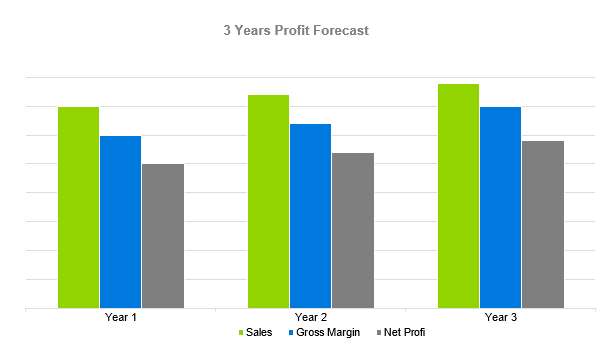
2.4 Business Target
Brandchoice plans to offer high quality, niche specific, durable and exciting products to a wide range of customers. After carefully considering local trends, Brandchoice is looking to target both local, regional and international customers with an aim of targeting customers.
Company Summary
3.1 company owner.
Raul Davis is an experienced accountant who has had the opportunity to work in reputable and well known subscription box companies across the United States. Given his past experience, he knows how to start a subscription box business . Raul clearly understands the various aspects involved in niche selection, business strategy and business marketing.
3.2 Aim of Starting the Business
Subscription boxes have become so popular thus necessitating the need to have providers who can creatively cater for customer needs. Customers love subscription boxes because they’re highly convenient and are delivered at your doorstep. With people preferring personalized items, subscription box businesses cater for these needs. The excitement associated with subscription boxes is evidently increasing and for these reasons, Raul found the best approach of how to build a subscription box business that caters for individual customer needs.
3.3 How the Business will be Started
With over a decade in subscription box industry, Raul Davis is an expert in subscription box businesses as he has actively helped many businesses to prosper. Given his accounting experience, Davis understands what needs to be done and has come up with a comprehensive financial analysis for Brandchoice.
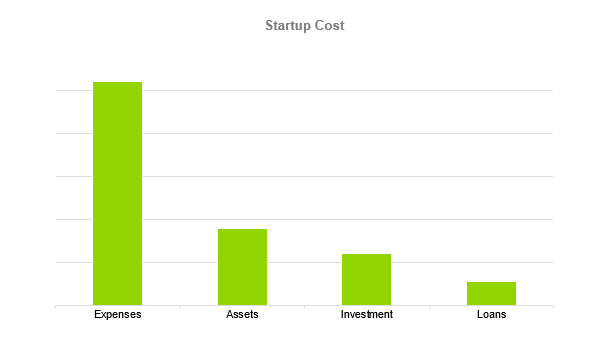
| Legal | $3,000 |
| Consultants | $6,000 |
| Insurance | $18,000 |
| Rent | $14,000 |
| Research and Development | $13,000 |
| Expensed Equipment | $20,000 |
| Signs | $5,000 |
| TOTAL START-UP EXPENSES | $79,000 |
| Start-up Assets | $0 |
| Cash Required | $150,000 |
| Start-up Inventory | $50,000 |
| Other Current Assets | $23,000 |
| Long-term Assets | $10,000 |
| TOTAL ASSETS | $23,000 |
| Total Requirements | $25,000 |
| $0 | |
| START-UP FUNDING | $90,000 |
| Start-up Expenses to Fund | $40,000 |
| Start-up Assets to Fund | $30,000 |
| TOTAL FUNDING REQUIRED | $0 |
| Assets | $20,000 |
| Non-cash Assets from Start-up | $14,000 |
| Cash Requirements from Start-up | $0 |
| Additional Cash Raised | $50,000 |
| Cash Balance on Starting Date | $25,000 |
| TOTAL ASSETS | $0 |
| Liabilities and Capital | $0 |
| Liabilities | $0 |
| Current Borrowing | $0 |
| Long-term Liabilities | $0 |
| Accounts Payable (Outstanding Bills) | $0 |
| Other Current Liabilities (interest-free) | $0 |
| TOTAL LIABILITIES | $0 |
| Capital | $0 |
| Planned Investment | $0 |
| Investor 1 | $30,000 |
| Investor 2 | $25,000 |
| Other | $0 |
| Additional Investment Requirement | $0 |
| TOTAL PLANNED INVESTMENT | $120,000 |
| Loss at Start-up (Start-up Expenses) | $40,000 |
| TOTAL CAPITAL | $55,000 |
| TOTAL CAPITAL AND LIABILITIES | $40,000 |
| Total Funding | $280,000 |
Services for Customers
Brandchoice plans to offer its clients a wide range of exciting products. The best part about subscription box business is it directly caters for the needs of customers. Brandchoice hopes to collect information from each customer in order to better understand their likes and preferences with an aim of making customized products. In order to successfully create a subscription box business , it is important to identify the products you wish to sell and try to diversify where necessary. In this case, Brandchoice is planning how to start a monthly subscription box business that will offer customers the following products:
- Art and Culture subscription boxes such as jewelry boxes, toys, paintings and kids books.
- Food and beverage subscription boxes such as chocolate subscription, jams, honey, healthy food bars and baking boxes.
- Home and Living subscription boxes i.e. cleaning suppliers, flowers and doormats.
- Fashion, Beauty and Grooming subscription boxes such as luxury bags, t-shirts, soap, underwear and deodorants etc.
Marketing Analysis of Subscription box business
Ever since the introduction of subscription boxes, the market has been receptive as the number of people signing up for subscription boxes has increased. The retail market has changed and customers now want to be surprised with pleasant items they didn’t expect. There are numerous reasons that have increased the popularity of subscription box businesses. This subscription box business plan identifies technology as one of the main drivers of the growth of subscription box enterprises. According to Hitwise, there are approximately 5.7 million subscription box shoppers as at 2017.
Demographics are key and Brandchoice knows too well starting a subscription box business must clearly identify and target specific demographics.
5.1 Market Segment
Immigration business plan.
For Brandchoice to meet the needs of its customers, the subscription box business plan s to offer diverse subscription box products whose demand is high. This way, subscription box can effectively reach out to consumers. Subscriptions don’t last forever as customers eventually end them. Brandchoice has done a comprehensive market analysis to only target the right customers with the right products in order to lengthen subscriptions.

5.1.1 Households
Los Angeles has a high population of households that require different types of items for various uses. However, research has shown subscription box purchases are mainly done by households with an income exceeding $100,000. Given the unique nature of subscription boxes, only households with specific interest in unique items will be expected to subscribe for boxes from Brandchoice. This business plan for subscription box intends to specifically offer subscription boxes with products tailored for household use. There’s no doubt, this is a major revenue source for Brandchoice.
5.1.2 Working Class Population
Subscription boxes are a favorite for employed individuals and entrepreneurs earning a steady income. Subscription boxes come at different prices and the concept of monthly payments makes them an ideal choice for salaried individuals with a taste for fine and unique items. Los Angeles is a business hub thus providing a high population of working class individuals who’re likely to commit to monthly subscription of products cutting across various niches.
5.1.3 Women
Women ordinarily love creative and unique items and will therefore to go any lengths to search for customized products. Subscription boxes offer a perfect solution because these boxes are famously associated with various fashion and beauty items. Brandchoice plans to sell fashion, beauty and grooming subscription boxes which are a favorite for women. To succeed in the business, Brandchoice has incorporated subscription box business ideas that target female shoppers who’re considered a key customer segment for the business.
5.1.4 Children
A good number of subscription boxes to be offered by Brandchoice will be geared for children. These boxes contain kids’ items such as toys, children books and clothes that attract parents who want to buy them for their children. The aim of the business is to venture into niches that are appreciated by children in order to capture this lucrative market. Brandchoice is keen to curate products for children to maximize retention and offer a great customer experience.
| Potential Customers | Growth | CAGR | |||||||
| Households | 30% | 25,000 | 27,000 | 29,000 | 31,000 | 33,000 | 10.00% | ||
| Working Class | 27% | 23,000 | 25,000 | 27,000 | 29,000 | 31,000 | 12.00% | ||
| Women | 23% | 20,000 | 22,000 | 24,000 | 26,000 | 28,000 | 14.00% | ||
| Children | 20% | 17,000 | 19,000 | 21,000 | 23,000 | 25,000 | 16.00% | ||
| Total | 100% | 85,000 | 93,000 101,000 | 109,000 | 117,000 | 20.00% | |||
5.2 Business Target
With the demand for subscription boxes increasing, Brandchoice has created a unique subscription box business plan template that will cater for both local and external customers. Los Angeles is a large city and the business expects to make good sales by putting in place systems that allows for the creation of unique and exciting subscription boxes. This box subscription business model hopes to achieve an annual sales growth of between 15-20%.
5.3 Product Pricing
In order for Brandchoice to achieve its targets, a detailed pricing survey was done in order to come up with a competitive pricing structure after taking into account the market average. Brandchoice also hopes to initially sell its subscription boxes at discounted prices for the first two months.
The subscription box industry has witnessed positive growth and it is expected more people will join this new wave. The appetite for unique and customized products has grown and trends indicate an increase in the uptake of subscription products.
Great Satisfaction
Great communication and coordination. The quality of the work delivered is very professional and exceeded my expectation. I would definitely engage with OGS Capital again in the future. Thank you OGS Capital!
When determining how to create a subscription box business , focus should be how to attract long lasting subscriptions to keep a steady flow of income. With good strategies in place, Brandchoice hopes to reach out to a wide market segment.
6.1 Competitive Analysis
When you start subscription box business , it is critical to analyze the market and come up with the best strategies to grow the business. Despite the growing number of subscription box companies in Los Angeles, Brandchoice has come up with the best strategies to remain ahead of competitors.
6.2 Sales Strategy
For Brandchoice to advertise its subscription boxes, the following sales strategies will be adopted for marketing the business.
- Understand client preferences and what they want in order to minimize cancellations and find out ways of making subscription boxes more appealing
- Find a creative and customer-friendly approach of handling cancellations and returns to keep a positive image of the business
- Provide a good alternative for customers who’re not satisfied with the present subscription plan or model
- Advertise the subscription box business on local media channels such as television, radio and newspapers
- Offer new clients a free subscription box in order to entice and allow them to see the quality of products
- Adopt direct mailing approach for targeted customer segments such as household and corporate organizations
- Advertise the business using digital marketing strategies such as Social media platforms (Facebook, Twitter and Instagram).
6.3 Sales Forecast
To achieve its sales targets, Brandchoice has formulated a detailed sales forecast to show how the subscription box business will perform when it begins operations.
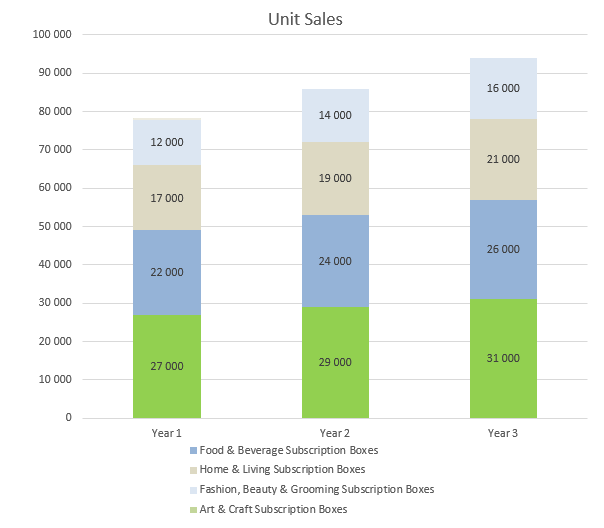
| Unit Sales | Year 3 | ||
| Art &Craft Subscription Boxes | 500,000 | 520,000 | 540,000 |
| Food &Beverage Subscription Boxes | 400,000 | 420,000 | 440,000 |
| Home & Living Subscription Boxes | 300,000 | 320,000 | 340,000 |
| Fashion, Beauty & Grooming Subscription Boxes | 250,000 | 270,000 | 290,000 |
| TOTAL UNIT SALES | |||
| Unit Prices | Year 1 | Year 2 | Year 3 |
| Art &Craft Subscription Boxes | $400.00 | $420.00 | $440.00 |
| Food & Beverage Subscription Boxes | $300.00 | $320.00 | $340.00 |
| Home & Living Subscription Boxes | $200.00 | $220.00 | $240.00 |
| Fashion, Beauty & Grooming Subscription Boxes | $100.00 | $120.00 | $140.00 |
| Sales | |||
| Art &Craft Subscription Boxes | $350,000 | $370,000 | $390,000 |
| Food &Beverage Subscription Boxes | $300,000 | $320,000 | $340,000 |
| Home & Living Subscription Boxes | $250,000 | $270,000 | $290,000 |
| Fashion, Beauty & Grooming Subscription Boxes | $200,000 | $220,000 | $240,000 |
| TOTAL SALES | |||
| Direct Unit Costs | Year 1 | Year 2 | Year 3 |
| Art &Craft Subscription Boxes | $3.20 | $4.20 | $5.20 |
| Food &Beverage Subscription Boxes | $2.20 | $3.20 | $4.20 |
| Home & Living Subscription Boxes | $1.20 | $2.20 | $3.20 |
| Fashion, Beauty & Grooming Subscription Boxes | $1.00 | $2.20 | $3.20 |
| Direct Cost of Sales | |||
| Art &Craft Subscription Boxes | $120,000 | $140,000 | $160,000 |
| Food &Beverage Subscription Boxes | $70,000 | $90,000 | $110,000 |
| Home & Living Subscription Boxes | $30,000 | $35,000 | $40,000 |
| Fashion, Beauty & Grooming Subscription Boxes | $50,000 | $55,000 | $60,000 |
| Subtotal Direct Cost of Sales | $315,000 | $350,000 | $365,000 |
Personnel Plan
Brandchoice plans to hire an experienced and small team of staff to run the subscription business. How to start your own subscription box business requires you to identify your personnel team as well as each role every member will play. It is also important to come up with a staff budget to help the business know how much it will spend on staff salaries.
7.1 Personnel Plan
Brandchoice is owned by Raul Davis who will also become the manager of the subscription box business. As preparations take shape to open the business, the following staff members will be hired to help on how to run a subscription box business . The team is expected to work closely together to facilitate a smooth flow of business activities.
Manager/Owner 1 Marketing Executive 1 Operations Manager 1 Accountant 2 Designers 1 Admin Assistant Those who’re successful will be taken through extensive training in order to familiarize themselves with how subscription box businesses are managed on a day-to-day basis.
7.2 Average Salaries
Brandchoice plans to remunerate staff members the following salaries in the first three years of operation.
| Manager | $40,000 | $45,000 | $50,000 |
| Marketing Executive | $35,000 | $40,000 | $45,000 |
| Operation Manager | $25,000 | $35,000 | $40,000 |
| Accountant | $30,000 | $50,000 | $70,000 |
| 2 Designers | $50,000 | $55,000 | $60,000 |
| Admin Assistant | $25,000 | $30,000 | $35,000 |
| Total Salaries | $205,000 | $255,000 | $300,000 |
Financial Plan
Brandchoice has come up with a comprehensive financial plan that will guide how the business will be run and managed. In this subscription box service business model , key financial parameters have been identified. Raul Davis will raise capital from his personal savings and will be working closely with two investors. Before planning how to start a box subscription business , you need to know about the expenses and costs involved to launch operations. A bank loan for business plan subscription box will be secured to finance any budget deficiencies.
8.1 Important Assumptions
The financial forecast for Brandchoice will be based on the assumptions below.
| Plan Month | 1 | 2 | 3 |
| Current Interest Rate | 8.00% | 11.00% | 13.00% |
| Long-term Interest Rate | 5.00% | 5.00% | 5.00% |
| Tax Rate | 12.00% | 14.00% | 16.00% |
| Other | 0 | 0 | 0 |
8.2 Brake-even Analysis
The Brake-even Analysis for Brandchoice is shown in the graph below.
| Monthly Units Break-even | 12000 |
| Monthly Revenue Break-even | $420,000 |
| Assumptions: | |
| Average Per-Unit Revenue | $250.00 |
| Average Per-Unit Variable Cost | $3.00 |
| Estimated Monthly Fixed Cost | $520,000 |

8.3 Projected Profit and Loss
Below is the Profit and Loss information for the subscription box business calculated on a monthly and annual basis.
| Sales | $500,000 | $520,000 | $540,000 |
| Direct Cost of Sales | $100,000 | $130,000 | $160,000 |
| Other | $0 | $0 | $0 |
| TOTAL COST OF SALES | |||
| Gross Margin | $400,000 | $420,000 | $440,000 |
| Gross Margin % | 70.00% | 74.00% | 80.00% |
| Expenses | |||
| Payroll | $300,000 | $320,000 | $340,000 |
| Sales and Marketing and Other Expenses | $6,000 | $8,000 | $10,000 |
| Depreciation | $3,000 | $5,000 | $7,000 |
| Leased Equipment | $0 | $0 | $0 |
| Utilities | $7,000 | $9,000 | $11,000 |
| Insurance | $3,000 | $4,000 | $5,000 |
| Rent | $12,000 | $14,000 | $16,000 |
| Payroll Taxes | $25,000 | $28,000 | $31,000 |
| Other | $0 | $0 | $0 |
| Total Operating Expenses | $320,000 | $350,000 | $380,000 |
| Profit Before Interest and Taxes | $70,000 | $80,000 | $90,000 |
| EBITDA | $20,000 | $25,000 | $30,000 |
| Interest Expense | $0 | $0 | $0 |
| Taxes Incurred | $18,000 | $22,000 | $26,000 |
| Net Profit | $120,000 | $130,000 | $140,000 |
| Net Profit/Sales | 25.00% | 30.00% | 35.00% |
8.3.1 Monthly Profit
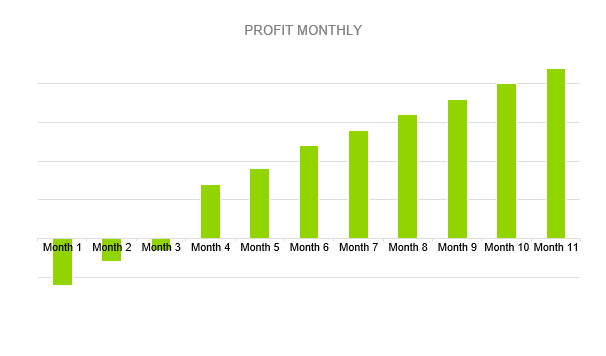
8.3.2 Yearly Profit
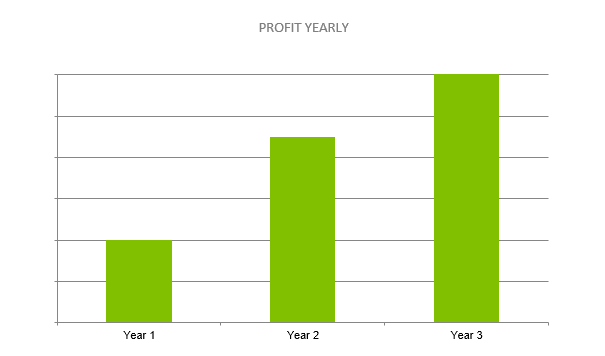
8.3.3 Monthly Gross Margin
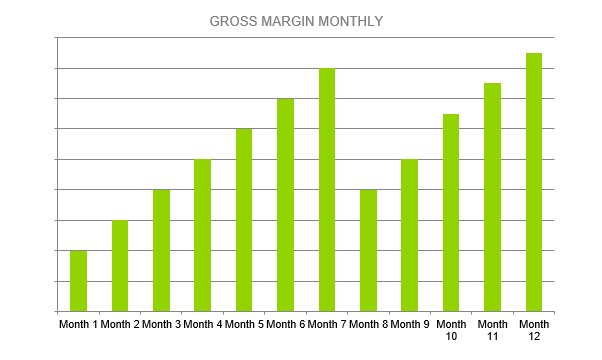
8.3.4 Yearly Gross Margin
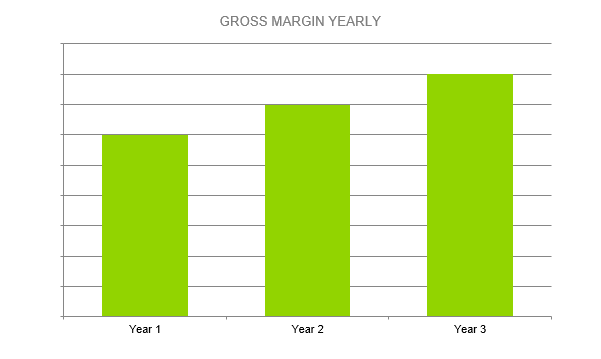
8.4 Projected Cash Flow
Below is a summary of pro forma cash flow, subtotal cash received, subtotal cash spent, subtotal cash from operations and subtotal cash spent on operations.
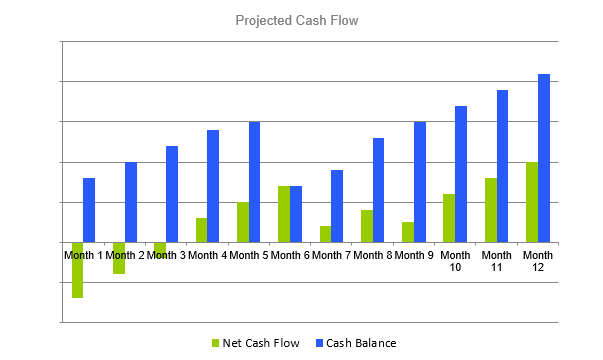
| Cash Received | |||
| Cash from Operations | |||
| Cash Sales | $150,000 | $155,000 | $160,000 |
| Cash from Receivables | $80,000 | $100,000 | $120,000 |
| SUBTOTAL CASH FROM OPERATIONS | |||
| Additional Cash Received | |||
| Sales Tax, VAT, HST/GST Received | $0 | $0 | $0 |
| New Current Borrowing | $0 | $0 | $0 |
| New Other Liabilities (interest-free) | $0 | $0 | $0 |
| New Long-term Liabilities | $0 | $0 | $0 |
| Sales of Other Current Assets | $0 | $0 | $0 |
| Sales of Long-term Assets | $0 | $0 | $0 |
| New Investment Received | $0 | $0 | $0 |
| SUBTOTAL CASH RECEIVED | |||
| Expenditures | Year 1 | Year 2 | Year 3 |
| Expenditures from Operations | |||
| Cash Spending | $40,000 | $45,000 | $50,000 |
| Bill Payments | $25,000 | $30,000 | $35,000 |
| SUBTOTAL SPENT ON OPERATIONS | |||
| Additional Cash Spent | |||
| Sales Tax, VAT, HST/GST Paid Out | $0 | $0 | $0 |
| Principal Repayment of Current Borrowing | $0 | $0 | $0 |
| Other Liabilities Principal Repayment | $0 | $0 | $0 |
| Long-term Liabilities Principal Repayment | $0 | $0 | $0 |
| Purchase Other Current Assets | $0 | $0 | $0 |
| Purchase Long-term Assets | $0 | $0 | $0 |
| Dividends | $0 | $0 | $0 |
| SUBTOTAL CASH SPENT | |||
| Net Cash Flow | $20,000 | $23,000 | $26,000 |
| Cash Balance | $25,000 | $28,000 | $31,000 |
8.5 Projected Balance Sheet
Below is a Projected Balance Sheet for Brandchoice that shows assets, capital, liabilities, long term assets and current liabilities.
| Assets | |||
| Current Assets | |||
| Cash | $380,000 | $400,000 | $420,000 |
| Accounts Receivable | $40,000 | $50,000 | $60,000 |
| Inventory | $5,000 | $8,000 | $9,000 |
| Other Current Assets | $5,000 | $5,000 | $5,000 |
| TOTAL CURRENT ASSETS | |||
| Long-term Assets | |||
| Long-term Assets | $30,000 | $33,000 | $36,000 |
| Accumulated Depreciation | $15,000 | $18,000 | $21,000 |
| TOTAL LONG-TERM ASSETS | |||
| TOTAL ASSETS | |||
| Liabilities and Capital | Year 1 | Year 2 | Year 3 |
| Current Liabilities | |||
| Accounts Payable | $20,000 | $23,000 | $26,000 |
| Current Borrowing | $0 | $0 | $0 |
| Other Current Liabilities | $0 | $0 | $0 |
| SUBTOTAL CURRENT LIABILITIES | |||
| Long-term Liabilities | $0 | $0 | $0 |
| TOTAL LIABILITIES | |||
| Paid-in Capital | $30,000 | $30,000 | $30,000 |
| Retained Earnings | $30,000 | $60,000 | $90,000 |
| Earnings | $130,000 | $160,000 | $190,000 |
| TOTAL CAPITAL | |||
| TOTAL LIABILITIES AND CAPITAL | |||
| Net Worth | $420,000 | $450,000 | $480,000 |
8.6 Business Ratios
The following is the Ratio Analysis, Business Net Worth and Business Ratios for Brandchoice.
| Sales Growth | 10.00% | 50.00% | 60.00% | 6.00% |
| Percent of Total Assets | ||||
| Accounts Receivable | 10.00% | 8.00% | 6.00% | 11.00% |
| Inventory | 5.00% | 4 | 3.00% | 10.00% |
| Other Current Assets | 3.00% | 4.00% | 2.00% | 35.00% |
| Total Current Assets | 120.00% | 150.00% | 150.00% | 60.00% |
| Long-term Assets | -8.00% | -14.00% | -25.00% | 50.00% |
| TOTAL ASSETS | ||||
| Current Liabilities | 6.00% | 4.00% | 2.00% | 26.00% |
| Long-term Liabilities | 0.00% | 0.00% | 0.00% | 24.00% |
| Total Liabilities | 6.00% | 2.00% | 1.50% | 45.00% |
| NET WORTH | ||||
| Percent of Sales | ||||
| Sales | 100.00% | 100.00% | 100.00% | 100.00% |
| Gross Margin | 74.00% | 80.00% | 90.00% | 0.00% |
| Selling, General & Administrative Expenses | 65.00% | 75.00% | 60.00% | 70.00% |
| Advertising Expenses | 5.00% | 3.00% | 1.50% | 5.00% |
| Profit Before Interest and Taxes | 25.00% | 28.00% | 33.00% | 3.00% |
| Main Ratios | ||||
| Current | 8 | 10 | 14 | 1.6 |
| Quick | 28 | 31 | 34 | 2.5 |
| Total Debt to Total Assets | 4.00% | 3.00% | 2.10% | 60.00% |
| Pre-tax Return on Net Worth | 85.00% | 95.00% | 100.00% | 4.00% |
| Pre-tax Return on Assets | 65.00% | 55.00% | 68.00% | 10.00% |
| Additional Ratios | Year 1 | Year 2 | Year 3 | |
| Net Profit Margin | 20.00% | 23.00% | 26.00% | N.A. |
| Return on Equity | 55.00% | 60.00% | 50.00% | N.A. |
| Activity Ratios | ||||
| Accounts Receivable Turnover | 7 | 9 | 11 | N.A. |
| Collection Days | 100 | 110 | 120 | N.A. |
| Inventory Turnover | 23 | 27 | 31 | N.A. |
| Accounts Payable Turnover | 14.2 | 16.2 | 18.2 | N.A. |
| Payment Days | 24 | 24 | 24 | N.A. |
| Total Asset Turnover | 3.6 | 2.6 | 1.6 | N.A. |
| Debt Ratios | ||||
| Debt to Net Worth | 0 | -0.1 | -0.05 | N.A. |
| Current Liab. to Liab. | 0 | 0 | 0 | N.A. |
| Liquidity Ratios | ||||
| Net Working Capital | $410,000 | $430,000 | $450,000 | N.A. |
| Interest Coverage | 0 | 0 | 0 | N.A. |
| Additional Ratios | ||||
| Assets to Sales | 0.75 | 0.5 | 0.35 | N.A. |
| Current Debt/Total Assets | 9% | 7% | 4% | N.A. |
| Acid Test | 32 | 35 | 38 | N.A. |
| Sales/Net Worth | 4.2 | 3.5 | 2.6 | N.A. |
| Dividend Payout | 0 | 0 | 0 | N.A. |
Download Subscription Box Business Plan Sample in pdf
OGS capital writers specialize in business plan themes such as tipper truck business plan , business plan for food delivery service , helicopter flight services business plan , professional taxi service business plan , medical transportation business plan , airmall business plan and many others.
OGSCapital’s team has assisted thousands of entrepreneurs with top-rate business plan development, consultancy and analysis. They’ve helped thousands of SME owners secure more than $1.5 billion in funding, and they can do the same for you.

Bowling Alley Business Plan Sample

Nightclub Business Plan (2024): A Comprehensive Guide

Rabbit Farming Business Plan

Beverages Business Plan

Private Schools Business Plan

Business Plan for a Lounge

Any questions? Get in Touch!
We have been mentioned in the press:
Leave a Reply Cancel reply
Your email address will not be published. Required fields are marked *
Save my name, email, and website in this browser for the next time I comment.
Search the site:
Formswift: Kickstart your success with a clear business plan template
From accounting to retail, a business plan is the key to helping you run your business. Wherever you are on your entrepreneurial journey, try our business plan template today to set your business up for success.

A business plan outlines a business’s goals, strategies, and financial projections.
As a roadmap for the company's future, it details the company's mission, target market, financial plan, competition, and operational plans. This paints a picture of how the business will operate and grow over time.

Why use a business plan?
Whether you’re a small business or a large corporation, a business plan outlines your business's objectives, strategies, marketing plan, and financial projections. It provides a step-by-step blueprint for success, detailing your business concept, target market, competition, and operational plans.
In fact, a business plan can help you in a vast number of ways.
A business plan clearly articulates your business idea, mission, and values to establish a strong foundation.

A well-crafted business plan provides a clear understanding of the business's viability and helps attract potential investors or secure financing.

The planning process forces you to research and analyze various aspects of your business, helping you make sound decisions based on market trends and data.

By establishing specific objectives and milestones, a business plan helps you track progress and stay focused on achieving your targets.

Traditional business plans cover everything: From market analysis and marketing strategies to financial projections.
Lean startup plans focus on elements like value proposition, customer segments, and revenue streams.
Operational plans cover operations, resource allocation, and implementation plans.

When to use a business plan
A business plan is essential in various situations, including starting a new business, seeking funding, and expanding or restructuring an existing business.
Starting a new business
It’s crucial to have a well-defined roadmap when launching a new venture to ensure a smooth start and increase the likelihood of success.
Seeking funding or business loan
Along with a balance sheet, income statements, and financial statements, investors and lenders often require a business plan. This is all part of their evaluation process to assess the viability and potential return on investment.
Expanding or restructuring an existing business
When making significant changes to your business, a business plan helps you evaluate the impact and plan accordingly.
What’s included in a business plan?
A well-rounded business plan typically includes the following key sections.
A concise overview of your business concept, highlighting its unique value and potential. This is the most important part of a business plan, as many readers, especially investors, might not look beyond this section if it isn't compelling. Ideally, you should write this section last but present it first in the business plan.

Detailed information about your business, including its mission, legal structure, and key personnel. You should describe your industry, the current market, your target demographic, expected future market growth, and how your company plans to fit into that market.

A thorough assessment of your target market, industry trends, and competitive landscape. Include your company’s unique selling proposition (USP), marketing strategy, sales strategy, and plans for customer retention and engagement.

Your plans for reaching and attracting customers, including pricing, promotions, and distribution channels.

Detailed forecasts of your business's financial performance, including revenue, expenses, and profitability. This section should contain an overview of the business's revenue and expenses for the next three to five years. Include existing income statements, balance sheets, and cash flow statements if possible (in other words, if you’re already operating).

Specific details about your business operations, including facilities, production processes, and staffing requirements. Highlight your company’s management team and organizational structure.

If you’re seeking funding, it’s beneficial to add a section detailing how much funding you need, how the funds will be used, and your desired terms.

Frequently asked questions
Yes, Formswift provides business plan templates online that can guide you through the process of creating a business plan. These templates provide a structured format and prompts for each section, making it easier to get started.
Try our template today
The length of a business plan can vary depending on the complexity of your business. However, it’s generally recommended to keep it concise and focused, typically ranging from 15 to 30 pages.
Absolutely. As a business owner, you should use the plan as a dynamic document that evolves with your business. Regularly reviewing and updating your plan ensures it remains relevant and aligned with your goals.
As you expand and gain insight from competitive analysis, market research, target customers, and social media feedback, it’s important to adjust your business model and business plan for optimal growth.
If you have a management team, take time to meet with them to review what works and what doesn't, along with the competitive advantages your own business has. Take these advantages and highlight them in your business plan.
While not mandatory, having a business plan is still beneficial, even if you’re the sole proprietor. As an entrepreneur, it’ll help clarify your business objectives, identify potential challenges, and stay organized in achieving your goals.
A business plan is a valuable tool, but success ultimately depends on various factors, including market conditions, execution of strategies, and adaptability. A well-crafted business plan increases your chances of success but doesn’t guarantee it.
Explore more helpful forms and templates
Non-disclosure agreement.
Protect your business with a binding confidentiality agreement.
Job application
Collect information from people who want to apply for a job.
Release of liability
Safeguard your business from potential risk.
Fill out your employees’ work and wage details, pain free.
Formswift is not a law firm and does not provide legal advice or representation. Formswift's documents are not a substitute for the advice of an attorney. Communications between you and Formswift are governed by the Formswift Privacy Policy but are not protected by the attorney-client privilege or as work product. Formswift does not provide advice, opinions, or recommendations about individual's legal rights, options, strategies, or the selection of forms. Your use of the Formswift website and forms is governed by the Formswift Terms of Service .
Create and edit your business plan, all in one place

COMMENTS
To build a strong subscription box business plan, consider six core components: Goals & Strengths, Niche, Cost Analysis, Competitive Analysis, Plan for Growth, & a Week-by-Week Launch Calendar. You'll see each of these represented in our template at the bottom of this post.
How to use this Business Plan template. In this blog post, we'll go over the core components of the subscription box business plan and at the end, you'll be able to download a 25-page template to get you started! The business plan is broken up into 6 different parts: Goals & Strengths, Niche, Cost Analysis, Competitive Analysis, Plan for ...
Discover the key elements to include in your subscription box business plan. Our guide offers practical advice, templates, and examples to help you write your own.
This guide to writing a subscription box business plan will help you through the process either way. To help you get started, you can download this free business plan template for writing a traditional business plan for a loan or investment, or this Lean Plan template for a more nimble, easy to update plan. 1.
Get Growthink's subscription box business plan template & step-by-step instructions to quickly & easily create your business plan.
Learn how to craft the perfect business plan for your subscription box business. This guide provides a template and what to include in each section.
These boxes are automatically delivered for the length of your subscription. The majority of subscription box services keep each month's specific box items a surprise. It is indeed a growing and profitable business in the united states of America. Below is a sample box subscription services business plan template that will help you write yours with little or no stress.
Plan your subscription service with our 'subscription box business plan example,' featuring marketing tactics and operational guidelines.
A subscription box business plan is a comprehensive document that outlines the key aspects, goals, and strategies of a subscription box service. It serves as a roadmap for entrepreneurs, helping them define their objectives, identify their target market, plan their operations, and secure funding.
Learn how to create a winning business plan for your subscription box venture with this comprehensive 9-step checklist. Master the art of strategic planning and take your subscription box business to new heights today.
Use this free Subscription Box business plan template to easily create a great business plan to start or grow your Subscription Box business.
The subscription box business is booming, and your idea could be the next big thing. To give your subscription business a chance to be successful, you need to create a comprehensive business plan.
How to Start a Subscription Box Business in 8 Simple Steps Subscription boxes are one of the best ways to shop, period. They offer consumers unique experiences curated around products and themes, introduce new brands, and make checking the mail just plain fun.
A successful subscription box business starts with a good subscription box business plan. Click to find out how to create it from scratch.
Why write a business plan for a subscription box? Understanding the document's scope and goals will help you easily grasp its structure and content. Before diving into the specifics of the plan, let's take a moment to explore the key reasons why having a subscription box business plan is so crucial.
Subscription Box Business Plan is an outline of your overall subscription box business. The business plan should include a 5 year financial projection, marketing plan, industry analysis, organizational overview, operational overview and finally an executive summary.
A one-year subscription would have a lower monthly cost than a month-to-month subscription. You'll need to price your subscription box at a point that is appealing to your target customer but also ensures your business makes a profit. It won't be feasible for your business to spend $25/box while charging only $20/box.
One of the biggest challenges ecommerce owners face is getting customers to make repeat purchases.
Learn how to start a subscription box business including business planning, key industry information, key startups costs, and more.
CURRENT BUSINESS STRENGTHS: In the space below write down the list of strengths, skills and talent that you currently possess which will benefit your subscription box business. Ex: Social media experience, accounting, logistics, expert in industry, etc.
The Box Business Plan Workshop is the proven framework for aspiring subscription box entrepreneurs where you'll create your business plan, improve your mindset, and actually have fun during the process!
With the demand for subscription boxes increasing, Brandchoice has created a unique subscription box business plan template that will cater for both local and external customers.
Set your business up for success. Understand what to include in a business plan and get started with our free business plan template. Learn more.